The Project Gutenberg eBook of Marvels of Pond-life
most other parts of the world at no cost and with almost no restrictions
whatsoever. You may copy it, give it away or re-use it under the terms
of the Project Gutenberg License included with this ebook or online
at www.gutenberg.org. If you are not located in the United States,
you will have to check the laws of the country where you are located
before using this eBook.
Title: Marvels of Pond-life
Author: Henry James Slack
Release date: July 30, 2011 [eBook #36903]
Most recently updated: January 7, 2021
Language: English
Credits: Produced by Chris Curnow, Matthew Wheaton and the Online
Distributed Proofreading Team at https://www.pgdp.net (This
file was produced from images generously made available
by The Internet Archive)
*** START OF THE PROJECT GUTENBERG EBOOK MARVELS OF POND-LIFE ***
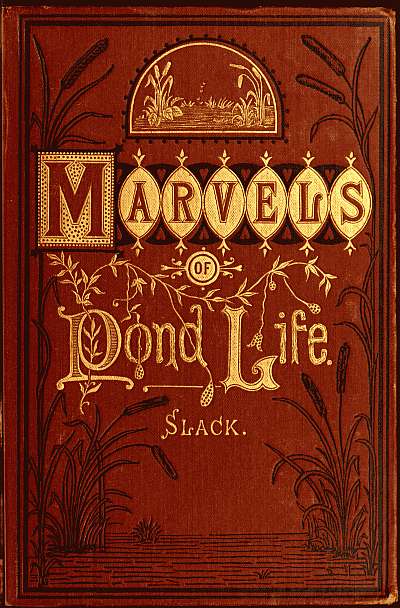

MARVELS OF POND-LIFE
OR,
A YEAR'S MICROSCOPIC RECREATIONS
AMONG THE
POLYPS, INFUSORIA, ROTIFERS, WATER-BEARS,
AND POLYZOA.
BY
HENRY J. SLACK, F.G.S.,
SECRETARY TO THE ROYAL MICROSCOPICAL SOCIETY;
AUTHOR OF
'THE PHILOSOPHY OF PROGRESS IN HUMAN AFFAIRS,' ETC. ETC.
SECOND EDITION.
ILLUSTRATED WITH COLOURED PLATES AND NUMEROUS WOOD ENGRAVINGS.
LONDON:
GROOMBRIDGE AND SONS,
5, PATERNOSTER ROW.
MDCCCLXXI.
PRINTED BY J. E. ADLARD,
BARTHOLOMEW CLOSE.
INTRODUCTION.
As this little book is intended to be no more than an
introduction to an agreeable branch of microscopical study,
it is to be hoped it will not require a formal preface; but
a few words may be convenient to indicate its scope and
purpose.
The common experience of all microscopists confirms the
assertion made by Dr. Goring, that the most fascinating
objects are living creatures of sufficient dimensions to be
easily understood with moderate magnification; and in no
way can objects of this description be so readily obtained,
as by devoting an occasional hour to the examination of the
little ponds which are accessible from almost any situation.
A complete volume of pond lore would not only be a bulky
book—much bigger than the aldermanic tomes which it is
the fashion to call "Manuals," although the great stone
fists in the British Museum would be required to grasp
them comfortably,—but its composition would overtask all
the philosophers of our day. In good truth, a tea-spoonful
of water from a prolific locality often contains a variety of
living forms, every one of which demands a profound
and patient study, if we would know but a few things
concerning it.
To man, then, is a vast and a minute. Our minds ache
at the contemplation of astronomical immensities, and we
are apt to see the boundless only in prodigious masses,[iv]
countless numbers, and immeasurable spaces. The Creative
Mind knows no such limitations; and the microscope
shows us that, whether the field of nature's operation be
what to our apprehension is great or small, there is no
limit to the exhibition of marvellous skill. If the "undevout
astronomer" be "mad," the undevout microscopist
must be still more so, for if the matter be judged by human
sense, the skill is greater as the operation is more minute;
and not the sun itself, nor the central orb round which he
revolves, with all his attendant worlds, can furnish sublimer
objects of contemplation, than the miraculous assemblage of
forces which make up the life of the smallest creature that
the microscope reveals.
There is an irresistible charm in the effort to trace
beginnings in nature. We know that we can never
succeed; that each discovery, which conducts back towards
some elementary law or principle, only indicates how much
still lies behind it: but the geologist nevertheless loves to
search out the first or oldest traces of life upon our globe;
and so the microscopist delights to view the simplest
exhibitions of structures and faculties, which reach their
completion in the frame and mind of man. That one great
plan runs through the whole universe is now an universally
accepted truth, and when applied to physiology and natural
history, it leads to most important results.
The researches of recent philosophers have shown us
that nature cannot be understood by studying the parts of
animals with reference merely to their utility in the
economy of the creature to which they belong. We do,
indeed, find an admirable correspondence between structures
and the services they perform; but every object in
creation, and every part of it, is in harmonious relation to
some grand design, and exhibits a conformity to some
general mode of operation, or some general disposition and
direction of forces, which secures the existence of the[v]
individual or the species, and at the same time works out
the most majestic schemes. Microscopic researches, such
as are within the reach of millions, offer many of the most
beautiful illustrations of these truths; and although the
following pages are confined to such objects as are easily
obtainable from ponds, and relate almost exclusively to the
Infusoria, the Rotifers, the Polyps, and the Polyzoa, it is
hoped that they will assist in associating a few of the highly
suggestive reasonings of science, with one of the most
pleasurable recreations that human ingenuity has devised.
After a preliminary chapter, which is intended to assist
the young microscopist in some technical matters, that
could not be conveniently introduced into the text, the
observations are distributed in chapters, corresponding with
the twelve calendar months. This arrangement was suggested
by the author's diary of operations for the year
1860, and although it by no means follows that the months
in which particular creatures were then discovered, will be
those in which they will be most readily found in other
years, it was thought advantageous to give a real account
of an actual period of microscopic work, and also that the
plan would facilitate a departure from the dry manner of a
technical treatise. The index will enable any one to use
the book for the purpose of reference, and it will be
observed that the first chapter in which any member of a
group of creatures is introduced, is that in which a general
description of the class is given. The illustrations are
taken from drawings made by the wife of the author from
the actual objects, with the exception of a few instances, in
which the authority is acknowledged. The sketches were
made especially for beginners, and the rule followed, was
not to introduce any details that could not be seen at
one focus, and with the simplest means: more elaborate
representations, though of the highest value to advanced
students, are bewildering at the commencement.[vi]
The ponds referred to are all either close to, or within a
moderate distance of, London;[1] but similar objects will in
all probability be obtained from any ponds similarly
situated, and the descriptions and directions given for the
capture of the minute prey will be found generally applicable.
Care has been taken throughout to explain the most
convenient methods of examining the objects, and although
verbal descriptions are poor substitutes for the teachings of
experience, it is hoped that those here given will remove
some difficulties from a pursuit that no intelligent person
can enter upon without pleasure, or consent to abandon
when its elementary difficulties have been mastered, and
the boundless fields of discovery are opened to view. Let
not the novice be startled at the word "discovery." It is
true that few are likely to arrive at new principles or facts
which will inscribe their names upon the roll of fame; but
no one of ordinary powers can look at living objects with
any considerable perseverance, without seeing much that
has never been recorded, and which is nevertheless worthy
of note; and when the mind, by its own exertions, first
arrives at a knowledge of new truth, an emotion is felt
akin to that which more than recompenses the profoundest
philosopher for all his toil.
[1] Many are now (1871) destroyed by the progress of building.[vii]
CONTENTS.
CHAPTER I.
MICROSCOPES AND THEIR MANAGEMENT.
PAGE
Powers that are most serviceable—Estimated by Focal
length—Length of Body of Microscope and its Effects—Popular
Errors about Great Magnification—Modes of
Stating Magnifying Power—use of an "Erector"—Power
of various Objectives with different Eye-pieces—Examination
of Surface Markings—Methods of Illumination—Direct
and Oblique Light—Stage Aperture—Dark-ground
Illumination—Mode of Softening Light—Microscope
Lamps—Care of the Eyes1
CHAPTER II.
JANUARY.
Visit to the Ponds—Confervæ—Spirogyra quinina—Vorticella—Common
Rotifer—Three Divisions of Infusoria—Phytozoa—Protozoa—Rotifera—Tardigrada—Meaning
of these Terms—Euglenæ—Distinction between Animals
and Vegetables—Description of Vorticellæ—Dark-ground
Illumination—Modes of producing it—The
[viii]Nucleus of the Vorticella—Methods of Reproduction—Ciliated
Protozoa—Wheel-bearers or Rotifers—Their
Structure—The Common Rotifer—The young Rotifer
seen inside the old one—an Internal Nursery—"Differentiation"
and "Specialization"—Bisexuality of Rotifers—Their
Zoological Position—Diversities in their
Appearance—Structure of their Gizzard—Description of
Rotifers10
CHAPTER III.
FEBRUARY.
Visit to Hampstead—Small ponds—Water-Fleas—Water-Beetle—Snails—Polyps—Hydra
viridis—The Dipping-tube—A
Glass Cell—The Hydra and its Prey—Chydorus
Sphæricus and Canthocamptus, or Friends and
their Escapes—Cothurnia—Polyp Buds—Catching
Polyps—Mode of Viewing Them—Structure of Polyps—Sarcode—Polyps
Stimulated by Light—Are they Conscious?—Tentacles
and Poison Threads—Paramecium—Trachelius—Motions
of Animalcules, whether Automatic
or directed by a Will—Their Restless Character30
CHAPTER IV.
MARCH.
Paramecia—Effects of Sunlight—Pterodina patina—Curious
Tail—Use of a Compressorium—Internal Structure
of Pterodina—Metopidia—Trichodina pediculus—Cothurnia—Salpina—Its
Three-sided Box—Protrusion of
its Gizzard Mouth43
[ix]
CHAPTER V.
APRIL.
The Beautiful Floscule—Mode of Seeking for Tubicolar
Rotifers—Mode of Illuminating the Floscule—Difficulty
of seeing the Transparent Tube—Protrusion of Long
Hairs—Lobes—Gizzard—Hairy Lobes of Floscule not
Rotatory Organs—Glass Troughs—Their Construction
and Use—Movement of Globules in Lobes of Floscule—Chætonotus
larus—Its mode of Swimming—Coleps
hirtus—Devourer of Dead Entomostraca—Dead Rotifer
and Vibriones—Theories of Fermentation and Putrefaction—Euplotes
and Stylonichia—Fecundity of Stylonichia54
CHAPTER VI.
MAY.
Floscularia cornuta—Euchlanis triquetra—Melicerta ringens—Its
Powers as Brickmaker, Architect, and Mason—Mode
of Viewing the Melicerta—Use of Glass Cell—Habits
of Melicerta—Curious Attitudes—Leave their
Tubes at Death—Carchesium—Epistylis—Their Elegant
Tree Forms—A Parasytic Epistylis like the "Old
Man of the Sea"—Halteria and its Leaps—Aspidisca
lynceus69
CHAPTER VII.
JUNE AND JULY.
Lindia torulosa—Œcistes crystallinus—A Professor of
Deportment on Stilts—Philodina—Changes of Form
[x]and Habits—Structure of Gizzard in Philodina Family—Mr.
Gosse's Description—Motions of Rotifers—Indications
of a Will—Remarks on the Motions of Lower
Creatures—Various Theories—Possibility of Reason—Reflex
Actions—Brain of Insects—Consensual Actions—Applications
of Physiological Reasoning to the Movements
of Rotifers and Animalcules76
CHAPTER VIII.
AUGUST.
Mud Coloured by Worms—Their Retreat at Alarm—A
Country Duck-Pond—Contents of its Scum—Cryptomonads—Their
Means of Locomotion—A Triarthra
(Three-limbed Rotifer)—The Brachion or Pitcher Rotifer—Its
Striking Form—Enormous Gizzard—Ciliary
Motion inside this Creature—Large Eye and Brain—Powerful
Tail—Its Functions—Eggs86
CHAPTER IX.
SEPTEMBER.
Microscopic Value of Little Pools—Curious Facts in Appearance
and Disappearance of Animalcules and Rotifers—Mode
of Preserving them in a Glass Jar—Fragments
of Melicerta Tube—Peculiar Shape of Pellets—Amphileptus—Scaridium
longicaudum—A Long-tailed
Rotifer—Stephanoceros Eichornii—A Splendid Rotifer—Its
Gelatinous Bottle—Its Crown of Tentacles—Retreats
on Alarm—Illumination Requisite to see its
Beauties—Its Greediness—Richly-coloured Food—Nervous
Ganglia97
[xi]
CHAPTER X.
OCTOBER.
Stentors and Stephanoceri—Description of Stentors—Mode
of viewing them—Their Abundance—Social
Habits—Solitary Stentors living in Gelatinous Caves—Propagation
by Divers Modes—Cephalosiphon limnias—A
Group of Vaginicolæ—Changes of Shape—A Bubble-blowing
Vorticella107
CHAPTER XI.
NOVEMBER.
Characteristics of the Polyzoa—Details of Structure according
to Allman—Plumatella repens—Its Great
Beauty under proper Illumination—Its Tentacles and
their Cilia—The Mouth and its Guard or Epistome—Intestinal
Tube—How it swallowed a Rotifer, and what
happened—Curiosities of Digestion—Are the Tentacles
capable of Stinging?—Resting Eggs, or "Statoblasts"—Tube
of Plumatella—Its Muscular Fibres—Physiological
Importance of their Structure118
CHAPTER XII.
DECEMBER.
Microscopic Hunting in Winter—Water-Bears, or Tardigrada—Their
Comical Behaviour—Mode of viewing
them—Singular Gizzard—Wenham's Compressorium—Achromatic
Condenser—Mouth of the Water-Bear—Water-Bears'
Exposure to Heat—Soluble Albumen—Physiological
and Chemical Reasons why they are not
[xii]killed by Heating or Drying—The Trachelius ovum—Mode
of Swimming—Method of Viewing—By Dark-ground
Illumination—Curious Digestive Tube with
Branches—Multiplication by Division—Change of Form
immediately following this Process—subsequent Appearances128
CHAPTER XIII.
Conclusion.—Remarks on Classification, &c.140
[1]
CHAPTER I.
PLAIN HINTS ON MICROSCOPES AND THEIR
MANAGEMENT.
Powers that are most serviceable—Estimated by focal length—Length
of body of microscope and its effects—Popular errors about great
magnification—Modes of stating magnified power—Use of an
"Erector"—Power of various objectives with different eye-pieces—Examination
of surface markings—Methods of illumination—Direct
and oblique light—Stage aperture—Dark ground illumination—Mode
of softening light—Microscope lamps—Care of the eyes.
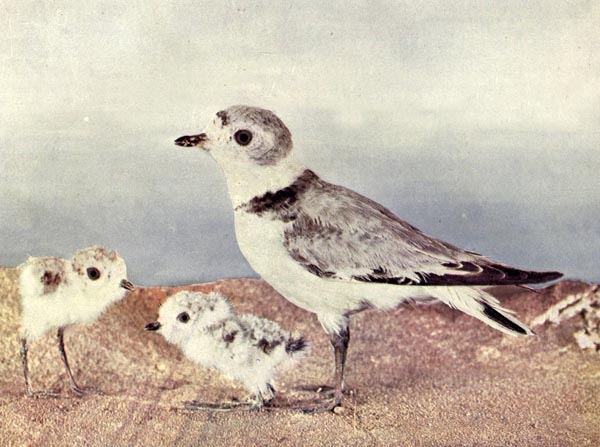
HE microscope is rapidly becoming the companion
of every intelligent family that can
afford its purchase, and, thanks to the skill of
our opticians, instruments which can be made to answer
the majority of purposes may be purchased for three
or four guineas, while even those whose price is counted
in shillings are by no means to be despised. The most
eminent English makers, Wales, and Tolles, in America,
and Hartnack, in Paris, occupy the first rank, while the
average productions of respectable houses exhibit so
high a degree of excellence as to make comparisons[2]
invidious. We shall not, therefore, indulge in the praises
of particular firms, but simply recommend any reader
entering upon microscopic study to procure an achromatic
instrument, if it can be afforded, and having at
least two powers, one with a focus of an inch or two
thirds of an inch, and the other of half or a quarter.
Cheap microscopes have usually only one eye-piece,
those of a better class have two, and the best are furnished
with three, or even more.
The magnifying power of a compound microscope
depends upon the focal length of the object-glass (or
glass nearest the object), upon the length of the tube,
and the power of the eye-piece. With regard to object-glasses,
those of shortest focal length have the highest
powers, and the longest eye-pieces have the lowest
powers. The body of a microscope, or principal tube
of which it is composed, is, in the best instruments,
about nine inches long, and a draw tube, capable of
being extended six inches more, is frequently useful.
From simple optical principles, the longer the tube the
higher the power obtained with the same object-glass;
but only object-glasses of very perfect construction will
bear the enlargement of their own imperfections, which
results from the use of long tubes; and consequently for
cheap instruments the opticians often limit the length of
the tube, to suit the capacity of the object-glasses they
can afford to give for the money. Such microscopes
may be good enough for the generality of purposes, but
they do not, with glasses of given focal length, afford
the same magnifying power as is done by instruments
of better construction. The best and most expensive[3]
glasses will not only bear long tubes, but also eye-pieces
of high power, without any practical diminution of the
accuracy of their operation, and this is a great convenience
in natural history investigations. To obtain
it, however, requires such perfection of workmanship
as to be incompatible with cheapness. An experienced
operator will not be satisfied without having an object-glass
at least as high as a quarter, that will bear a deep
eye-piece, but beginners are seldom successful with a
higher power than one of half-inch focus, or thereabouts,
and before trying this, they should familiarise
themselves with the use of one with an inch focus.
It is a popular error to suppose that enormous magnification
is always an advantage, and that a microscope
is valuable because it makes a flea look as big as a cat
or a camel. The writer has often smiled at the exclamations
of casual visitors, who have been pleased with
his microscopic efforts to entertain them. "Dear me,
what a wonderful instrument; it must be immensely
powerful;" and so forth. These ejaculations have often
followed the use of a low power, and their authors have
been astonished at receiving the explanation that the
best microscope is that which will show the most with
the least magnification, and that accuracy of definition,
not mere increase of bulk, is the great thing
needful.
Scientific men always compute the apparent enlargement
of the object by one dimension only. Thus,
supposing an object one hundredth of an inch square
were magnified so as to appear one inch square, it
would, in scientific parlance, be magnified to "one hundred[4]
diameters," or one hundred linear; and the figures
100 would be appended to any drawing which might be
made from it. It is, however, obvious that the length
is magnified as well as the breadth; and hence the
magnification of the whole surface, in the instance
specified, would be one hundred times one hundred, or
ten thousand: and this is the way in which magnification
is popularly stated. A few moments' consideration
will show that the scientific method is that which
most readily affords information. Any one can instantly
comprehend the fact of an object being made
to look ten times its real length; but if told that it is
magnified a hundred times, he does not know what this
really means, until he has gone through the process of
finding the square root of a hundred, and learnt that a
hundredfold magnification means a tenfold magnification
of each superficial dimension. If told, for example,
that a hair is magnified six hundred diameters, the
knowledge is at once conveyed that it looks six hundred
times as broad as it is; but a statement that the
same hair is magnified three hundred and sixty
thousand times, only excites a gasping sensation
of wonder, until it is ascertained by calculation that
the big figures only mean what the little figures express.
In these pages the scientific plan will always be followed.
If expense is not an object, a binocular instrument
should be purchased, and it is well to be provided with
an object-glass as low as three or even four inches focus,
which will allow the whole of objects having the diameter
of half an inch or more to be seen at once. Such a low[5]
power is exceedingly well adapted for the examination
of living insects, or of the exquisite preparations of
entire insects, which can now be had of all opticians.
Microscopes which have a draw tube can be furnished
with an erector, an instrument so called because it
erects the images, which the microscope has turned
upside down, through the crossing of the rays. This is
very convenient for making dissections under the instrument;
and it also gives us the means of reducing
the magnifying power of an object-glass, and thus
obtaining a larger field. The erector is affixed to the
end of the draw tube, and by pulling it out, or thrusting
it in, the rays from the object-glass are intercepted at
different distances, and various degrees of power obtained.
A binocular microscope is most useful with low
powers from two thirds upwards. A new form, devised
by Mr. Stephenson, acts as an erector, and is very
valuable for dissections. It works with high powers.
Beginners will be glad to know how to obtain the
magnifying power which different objects require, and
it may be stated that, with a full-sized microscope, a
two-inch object-glass magnifies about twenty-five diameters
with the lowest eye-piece; a one-inch object-glass,
or two thirds, from fifty to sixty diameters; a
half-inch about one hundred; a quarter-inch about two
hundred. The use of deeper eye-pieces adds very considerably
to the power, but in proportions which differ
with different makers. One instrument used by the
writer has three eye-pieces, giving with a two thirds
object-glass powers of sixty one hundred and five, and[6]
one hundred and eighty respectively; and with
a fifth two hundred and forty, four hundred and
thirty, and seven hundred and twenty, which can be
augmented by the use of a draw tube.
It has been well observed that the illumination of
objects is quite as important as the glasses that are
employed, and the most experienced microscopists have
never done learning in this matter. Most microscopes
are furnished with two mirrors beneath the stage, one
plane and one concave. The first will throw a few
parallel rays through any transparent object properly
placed, and the latter causes a number of rays to
converge, producing a more powerful effect. The first
is usually used in daylight, when the instrument is
near a window (one with a north aspect, out of direct
sunlight, being the best); and the second is often
useful when the source of illumination is a candle or a
lamp. By varying the angle of the mirror the light is
thrown through the object more or less obliquely, and
its quantity should never be sufficient to pain the eye.
Few objects are seen to the best advantage with a
large pencil of perfectly direct light, and the beginner
should practise till the amount of inclination is obtained
which produces the best effect.
It is advisable that the hole in the stage of the
microscope should be large—at least an inch and a half
each way—so that the entrance of oblique rays is not
obstructed, and it is desirable that the mirror, in
addition to sliding up and down, should have an arm
by which it can be thrown completely out of the
perpendicular plane of the body of the instrument.[7]
This enables such oblique rays to be employed as to
give a dark field, all the light which reaches the eye
being refracted by the object through which it is sent.
The opticians sell special pieces of apparatus for this
purpose, but though they are very useful, they do not
render it less desirable to have the mirror mounted as
described.
Most microscopes are furnished with a revolving
diaphragm, with three holes, of different sizes, to
diminish the quantity of light that is admitted to the
object. This instrument is of some use, and offers a
ready means of obtaining a very soft agreeable light for
transparent objects, viewed with low powers. For this
purpose cut a circular disk of India or tissue paper,
rather larger than the biggest aperture; scrape a few
little pieces of spermaceti, and place them upon it, then
put the whole on a piece of writing-paper, and hold it
a few inches above the flame of a candle, moving it
gently. If this is dexterously done, the spermaceti will
be melted without singeing the paper, and when it is
cold the disk will be found transparent. Place it over
the hole in the diaphragm, send the light through it,
and the result will be a very soft agreeable effect, well
suited for many purposes, such as viewing sections of
wood, insects mounted whole, after being rendered
transparent, many small water creatures, etc. Another
mode of accomplishing this purpose is to place a
similarly prepared disk of paper on the flat side of a
bull's-eye lens, and transmit the light of a lamp through
it. This plan may be used with higher powers, and
the white opaque light it gives may be directed[8]
at any angle by means of the mirror beneath the
stage.
An ordinary lamp may be made to answer for microscopic
use, but one of the small paraffine lamps now
sold everywhere for eighteen-pence is singularly convenient.
It is high enough for many purposes, and can
easily be raised by one or more blocks. A paraffine
lamp on a sliding stand is still more handy, and all the
better for a hole with a glass stopper, through which
the fluid can be poured.
Many people fancy that the eyes are injured by
continual use of the microscope, but this is far from
being the case if reasonable precautions are taken.
The instrument should be inclined at a proper angle,
all excess of light avoided, and the object brought into
focus before it is steadily looked at. Most people
solemnly shut one eye before commencing a microscopic
examination; this is a practical and physiological
mistake. Nature meant both eyes to be open, and
usually resents a prolonged violation of her intentions
in this matter. It requires but a little practice to keep
both eyes open, and only pay attention to what is seen
by that devoted to the microscope. The acquisition of
this habit is facilitated, and other advantages gained,
by a screen to keep out extraneous light. For this
purpose take a piece of thin cardboard about nine
inches square, and cut a round hole in it, just big
enough to admit the tube of the microscope, about two
inches from the bottom, and equidistant from the two
sides. Next cut off the two upper corners of the cardboard,
and give them a pleasant-looking curve. Then[9]
cover the cardboard with black velvet, the commonest,
which is not glossy, answers best, and your screen is
made. Put the hole over the tube of the microscope,
and let the screen rest on the little ledge or rim which
forms an ornamental finish to most instruments. A
piece of cork may be gummed at the back of the screen,
so as to tilt it a little, and diminish its chance of
coming into contact with that important organ the
nose. This little contrivance adds to the clearness and
brilliancy of objects, and is a great accommodation to
the eyes.
One more oculistic memorandum, and we have done
with this chapter. Do not stare at portions of objects
that are out of focus, and consequently indistinct, as
this injures the eyes more than anything. Remember
the proverb, "None so deaf as those that won't hear,"
which naturally suggests for a companion, "None so
blind as those that won't see." It is often impossible
to get every object in the field in focus at one time;—look
only at that which is in focus, and be blind to all
the rest. This is a habit easily acquired, and is one
for which our natural microscopes are exceedingly
grateful; and every judicious observer desires to keep
on the best terms with his eyes.
[10]
CHAPTER II.
JANUARY.
Visit to the ponds—Confervæ—Spirogyra quinina—Vorticella—Common
Rotifer—Three divisions of Infusoria—Phytozoa—Protozoa—Rotifera—Tardigrada—Meaning
of these terms—Euglenæ—Distinction
between animals and vegetables—Description of
Vorticellæ—Dark ground illumination—Modes of producing it—The
Nucleus of the Vorticellæ—Methods of reproduction—Ciliated
Protozoa—Wheel bearers or Rotifers—Their structure—The common
Rotifer—The young Rotifer seen inside the old one—An
internal nursery—"Differentiation" and "Specialisation"—Bisexuality
of Rotifers—Their zoological position—Diversities in
their appearance—Structure of their Gizzard—Description of
Rotifers.
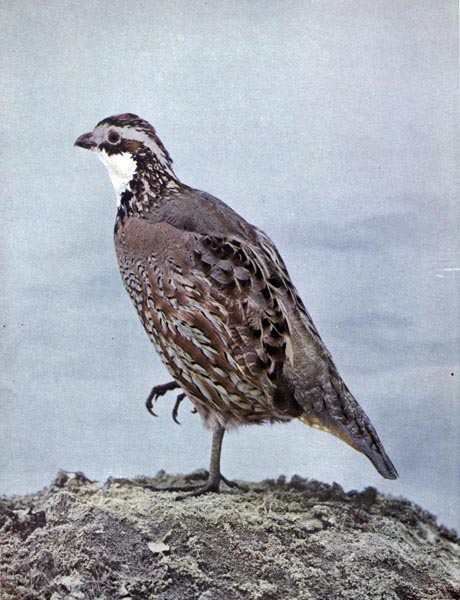
HE winter months are on the whole less
favorable to the collection of microscopic
objects from ponds and streams than the
warmer portions of the year; but the difference is
rather in abundance than in variety, and with a very
moderate amount of trouble, representatives of the
principal classes can always be obtained.
On a clear January morning, when the air was keen,
but no ice had yet skinned over the surface of the
water, a visit to some small ponds in an open field not
far from Kentish Town provided entertainment for
several days. The ponds were selected from their open[11]
airy situation, the general clearness of their water, and
the abundance of vegetation with which they were
adorned. Near the margin confervæ abounded, their
tangled masses of hair-like filaments often matted
together, almost with the closeness of a felted texture.
At intervals, minute bubbles of air, with occasionally a
few of greater size, indicated that the complex processes
of vegetable life were actively going on, that the tiny
plants were decomposing carbonic acid, dexterously
combining the carbon—which we are most familiar
with in the black opaque form of charcoal—to form
the substance of their delicate translucent tissues, and
sending forth the oxygen as their contribution to the
purification of the adjacent water, and the renovation
of our atmospheric air. This was a good sign, for
healthy vegetation is favorable to many of the most
interesting forms of infusorial life. Accordingly the
end of a walking-stick was inserted among the green
threads, and a skein of them drawn up, dank, dripping,
and clinging together in a pasty-looking mass. To
hold up a morsel of this mass, and tell some one not in
the secrets of pond-lore that its dripping threads were
objects of beauty, surpassing human productions, in
brilliant colour and elegant form, would provoke
laughter, and suggest the notion that you were poking
fun at them, when you poked out your stick with the
slimy treasure at its end. But let us put the green
stuff into a bottle, with some water from its native
haunt, cork it up tight, and carry it away for quiet
examination under the microscope at home.
Here we are with the apparatus ready. We have[12]
transferred a few threads of the conferva from the
bottle to the live box, spreading out the fine fibres with
a needle, and adding a drop of water. The cover is
then gently pressed down, and the whole placed on the
stage of the microscope, to be examined with a power
of about sixty. A light is thrown somewhat obliquely
by the mirror through the object, the focus adjusted,
and a beautiful sight rewards the pains. Our mass of
conferva turns out to contain one of the most elegant
species. Fine hair-like tubes of an organic material,
as transparent as glass, are divided by partitions of the
same substance into cylindrical cells, through which a
slender ribbon of emerald green, spangled at intervals
with small round expansions, is spirally wound. We
shall call it the Spiral Conferva, its scientific name
being Spirogyra quinina. Some other species, though
less elegantly adorned, make a pleasing variety in the
microscopic scene; and appended to some of the
threads is a group of small crystal bells, which jerk up
and down upon spirally twisted stalks. These are the
"Bell Flower Animalcules" of old observers, the
Vorticellæ, or Little Vortex-makers of the present day.
Other small creatures flit about with lively motions,
and among them we observe a number of green spindles
that continually change their shape, while an odd-looking
thing crawls about, after the manner of certain
caterpillars, by bringing his head and tail together,
shoving himself on a step, and then repeating the
process, and making another move. He has a kind of
snout, behind which are two little red eyes, and something
like a pig-tail sticks out behind. This is the[13]
Common Wheel-bearer, Rotifer vulgaris, a favourite
object with microscopists, old and young, and capable,
as we shall see, of doing something more interesting
than taking the crawl we have described.
A higher power, say one or two hundred, may be
conveniently applied to bring out the details of the
inhabitants of our live box more completely; but if the
glasses are good, a linear magnification of sixty will
show a great deal, with the advantage of a large field,
and less trouble in following the moving objects of our
search.
Having commenced our microscopic proceedings by
obtaining some Euglenæ, Vorticellæ, and a Rotifer, we
are in a position to consider the chief characteristics of
three great divisions of infusoria, which will often
engage our attention.
It is well known that animalcules and other small
forms of being may be found in infusions of hay or
other vegetable matter, and hence all such and similar
objects were called Infusoria by early observers. Many
groups have been separated from the general mass
comprehended under this term, and it is now used in
various senses. The authors of the 'Micrographic
Dictionary' employ it to designate "a class of microscopic
animals not furnished with either vessels or
nerves, but exhibiting internal spherical cavities, motion
effected by means of cilia, or variable processes
formed of the substance of the body, true legs being
absent." The objection to this definition is, that it
to some extent represents theories which may not be
true. That nerves are absent all through the class is an[14]
assumption founded merely upon the negative evidence
of their not having been discovered, and the complete
absence of "vessels" cannot be affirmed.
In the last edition of 'Pritchard's Infusoria,' to which
some of our ablest naturalists have contributed, after
separating two groups, the Desmids, and the Diatoms,
as belonging to the vegetable world, the remainder of
the original family of infusoria are classified as Phytozoa,
Protozoa, Rotifera, and Tardigrada. We shall explain
these hard names immediately, first remarking that the
Desmids and the Diatoms, concerning whom we do not
intend to speak in these pages, are the names of two
groups, one distinctly vegetable, while the other,
although now generally considered so, were formerly
held by many authorities to be in reality animal. The
Desmids occur very commonly in fresh water. We have
some among our Confervæ. They are most brilliant
green, and often take forms of a more angular and
crystalline character than are exhibited by higher
plants. The Diatoms are still more common, and we
see before us in our water-drop some of their simplest
representatives in the form of minute boats made of
silica (flint) and moved by means still in dispute.
Leaving out the Desmids and Diatoms, we have said
that in Pritchard's arrangement the views of those
writers are adopted who divide the rest of the infusoria
into four groups, distinguished with foreign long-tailed
names, which we will translate and expound. First
come the Phytozoa, under which we recognise our old
acquaintance zoophyte turned upside down. Zoophytes
mean animal-plants, Phytozoa mean plant-animals. We[15]
shall have by-and-bye to speak of some of the members
of this artificial and unsatisfactory group, and postpone
to that time a learned disquisition on the difference
between animals and plants, a difference observable
enough if we compare a hippopotamus with a cabbage,
but which "grows small by degrees, and beautifully
less," as we contemplate lower forms.
After the Phytozoa come the Protozoa, or first forms
in which animality is distinctly recognised. Under this
term are assembled creatures of very various organization,
from the extreme simplicity of the Proteus or
Amœba, a little lump of jelly, that moves by thrusting
out portions of its body, so as to make a sort of extempore
legs, and in which no organs can be discerned,[2]
up to others that are highly developed, like our Vorticellæ.
This group is evidently provisional, and jumbles
together objects that may be widely separated when
their true structure and real affinities are discerned.
[2] In some kinds and in some stages of growth this is not strictly
true.
Following the Protozoa, come the Rotifera, or Wheel-bearers,
of which we have obtained an example from
our pond, and whose characteristics we shall endeavour
to delineate when our specimen is under view; and last
in the list we have the Tardigrada, "Slow-steppers," or
Water Bears, queer little creatures, something like new-born
puppies, with a double allowance of imperfect feet.
These, though somewhat connected with the rotifers,
are considered to belong to a low division of the arachnida
(spiders, &c.).
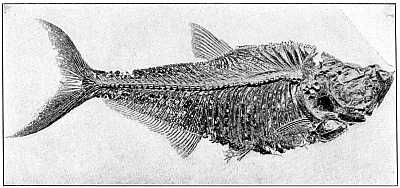
a, motile; and b, resting condition of Euglenæ.
Feeling that we must be merciful with the long-tailed
[16]words and explanations of classification, we reserve
further matter of this kind for the opportunities that
must arise, and direct our attention to living forms by
watching the Euglenæ which our water-drop contains.
We have before us a number of elegant spindle-shaped
bodies, somewhat thicker in front than behind, and in
what may be called the head there glitters a brilliant
red speck, commonly called an eye-spot, although, like
the eyes of potatoes, it cannot see. Round this eye-spot
the tissues are clear, like glass; but the body of
the creature is of a rich vegetable green, which shines
and glistens as it catches the light. Some swim rapidly
with a rollicking motion, while others twist themselves
into all manner of shapes. Now the once delicate
spindle is oddly contorted, now it swells out in the
middle, like a top, and now it rolls itself into a ball.
The drawings will afford some idea of these protean
changes, but they must be seen before their harlequin
character can be thoroughly appreciated. Some of the
specimens exhibit delicate lines running lengthwise, and
taking a spiral twist as the creature moves about; but
in none can any mouth be discerned, and their antics,[17]
although energetic and comical, afford no certain indications
of either purpose or will. What are they?
animals or vegetables? or something betwixt and
between?
The first impression of any casual observer would be
to declare in favour of their animality; but before this
can be settled, comes the question, what is an animal,
and how does it differ from a vegetable? and upon this
the learned do by no means agree. One writer considers
the presence of starch in any object a proof that
it belongs to the dominions of Flora, while another
would decide the issue by ascertaining whether it evolves
oxygen and absorbs carbon, as most plants do, or whether
it evolves carbon and absorbs oxygen, as decided animals
do. Dr. Carpenter asserts that the distinction between
Protophyta and Protozoa (first or simplest plants and
animals), "lies in the nature of their food, and the
method of its introduction, for whilst the Protophyte
obtains the materials of its nutrition from the air and
moisture that surround it, and possesses the power of
detaching oxygen, hydrogen, carbon, and nitrogen from
their previous binary combinations, and of uniting them
into ternary and quaternary organic compounds (chlorophyll,
starch, albumen, &c.), the simplest Protozoa,
in common with the highest members of the animal
kingdom, seems utterly destitute of any such power,
makes, so to speak, a stomach for itself in the substance
of its body, into which it injects the solid particles that
constitute its food, and within which it subjects them
to a regular process of digestion."
Unfortunately it is very difficult to apply this simple[18]
theory to the dubious objects which lie on the border-land
of the animal world, and no other theory that has
been propounded appears to meet all cases. Some
naturalists do not expect to find a broad line of demarkation
between the two great divisions of living
things, but others characterise such an idea as "unphilosophical,"
in spite of which, however, we incline
towards it.
Mr. Gosse, whose opinion is entitled to great respect,
calls the Euglenæ "animals" in his 'Evenings with
the Microscope;' but from the aggregate of recorded
observations it seems that they evolve oxygen, are
coloured with the colouring matter of plants, reproduce
their species in a manner analogous to plants, and have
in some cases been clearly traced to the vegetable
world. It is, however, possible that some Euglenæ
forms may be animal and others vegetable, and while
their place at nature's table is being decided, they must
be content to be called Phytozoa, which, as we have
before explained, is merely Zoophyte turned upside
down.
Some authorities have thought their animality proved
by the high degree of contractility which their tissues
evince. This, however, cannot go for much, as all
physiologists admit contractility to belong to the vegetable
tissues of the sensitive plant, "Venus' Fly-trap,"
&c., and a little more or less cannot mark the boundary
between two orders of being.
We shall have occasion again to notice the Protophytes,
and now pass to the Protozoa, of which we have
a good illustration in the Vorticella already spoken of.[19]
In the group before us a number of elegant bells or
vases stand at the end of long stalks, as shown at the
top of the frontispiece, while round the tops of the bells,
the vibrations of a wreath or cilia produce little vortices
or whirlpools, and hence comes the family name. This
current brings particles of all sorts to the mouth near
the rim of the bells, and the creature seems not entirely
destitute of power to choose or reject the morsels according
to its taste. Every now and then the stalk of
some specimen is suddenly twisted into a spiral, and
contracted, so as to bring the bell almost to the ground.
Then the stem gracefully elongates again, and the cilia
repeat their lively game.
The general effect can be seen very well by a power
of about sixty linear, but one of them from one to two
hundred is necessary to bring out the details, and a
practised observer will use still more magnification with
good effect. They should be examined by a moderately
oblique light, or most of the cilia are apt to be rendered
invisible, and also by dark ground illumination. This
may be accomplished in a well-made microscope by
turning the mirror quite out of the plane of the axis of
the instrument, that is to say, on one side of the space
the body would occupy if it were prolonged. By this
means, and by placing the lamp at an angle with the
mirror, that must be learnt by experiment, all the light
that reaches the eye has first passed through the object,
and is refracted by it out of the line it was taking,
which would have carried it entirely away. Or the
object may be illuminated by an apparatus called a
spotted lens, which is a small bull's-eye placed under
[20]the stage, and having all the centre of its face covered
with a plaster of black silk. In this method the central
or direct rays from the mirror are obstructed, but
those which strike the edge of the bull's-eye are bent
towards the object, which they penetrate and illuminate
if it is sufficiently transparent and refractive. Another
mode of dark ground illumination is by employing an
[21]elegant instrument called a parabolic illuminator, which
need not be described.
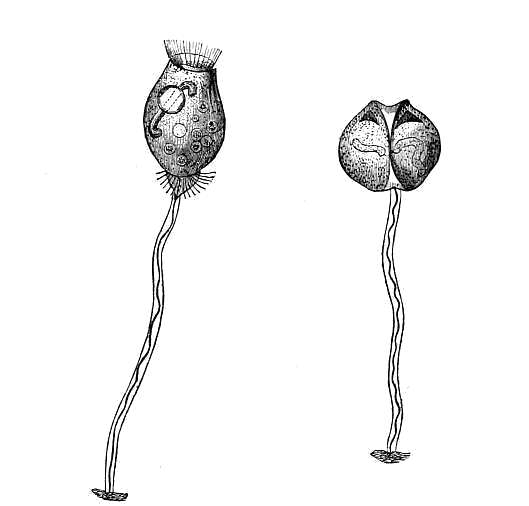
Left: Vorticella, with posterior
circlet of cilia in process of separation—Stein.
Right: Vorticella in process of self-division.
A new frontal wreath in formation in
each of the semi-lunar spaces.
Different specimens and species of Vorticellæ vary in
the length of their bells from one three or four
thousandth to one hundred and twentieth of an inch,
and when they are tolerably large, the dark ground
illumination produces a beautiful effect. The bells
shine with a pearly iridescent lustre, and their cilia
flash with brilliant prismatic colours.
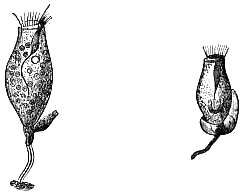
Left: Vorticella microstoma, showing
alimentary tube, ciliated mouth,
and formation of a gemma at the
base, 300 linear.—Stein.
Right: Vorticella microstoma, the encysted
animal protruding through
a supposed rupture of the tunic.
The Vorticellina belong to the upper division of the
Protozoa—the ciliata, or ciliated animalcules, and they
have a mouth, an œsophagus, and an orifice for the
exit of their food.
Many observers used to ascribe to those creatures a[22]
complete intestinal canal, but such an apparatus is now
believed not to exist in any of the Infusoria. Food
particles, after leaving the œsophagus, are thrust forward
into the sarcode, or soft flesh, and any cavity thus
formed acts as a stomach.
The bells or cups are not, as might be fancied from
a casual inspection, open like wineglasses at the top,
but furnished with a retractile disk or cover, on which
the cilia are arranged. Their stalks are not simple
stems, but are hollow tubes, which in the genus Vorticella
are furnished with a muscular band, by whose
agency the movements are principally made.
Some of the Vorticellids will be observed to leave
their stalks, having developed cilia round their base,
and may be seen to swim about in the enjoyment of
individual life. They are also capable of becoming
encysted, that is, of secreting a gelatinous cover.

Encysted Vorticella, showing the obliteration of special organs by
the advancement of the process.—Pritchard.
These changes are exhibited in the annexed cuts,
which are copied from known authorities. By careful
observation of the bodies of Vorticellids, a contractile
vesicle may be observed, which appears to cause a
movement of fluids, that is probably connected either
with respiration or secretion.[23]
Another piece of apparatus in this family, but not
confined to it, is the so-called nucleus, which in this
case is of a horseshoe shape and granular texture,
and greater solidity than the surrounding parts. The
functions of this organ formed the subject of various
conjectures, but it is now generally held to be an
ovary.
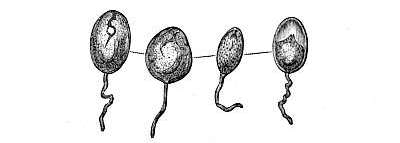
Vorticella microstoma, in process of encystment, 300 linear; in the
last the inclosing tunic is plainly developed.—Stein.
In common with many of the lower animals, the
Vorticellids have three ways of multiplying their race.
One by fission, or division of their bodies: another by
buds, somewhat analogous to those of plants; and another
by reproductive germs. These processes will come
again under our notice, and we shall leave the Vorticellids
for the present by observing that if they are
fed with a very small quantity of indigo or carmine,
the vacuoles or spaces, into which their nutriment
passes, will be clearly observed. Ehrenberg thought
in these and similar creatures that every vacuole
was a distinct stomach, and that all the stomachs
were connected by an intestinal canal; hence his name[24]
Polygastrica, or many stomached. In these views he
has not been followed by later observers, and it is probable
he was misled, partly by pushing the process of
reasoning from the analogies of higher animals much
too far, and partly by the imperfection of the glasses he
employed.
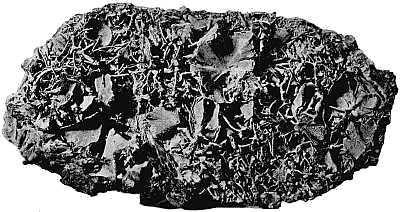
Rotifer vulgaris.—A, mouth, or gizzard; B, contractile
vesicle.—Micrographic Dictionary.
N.B.—When the cilia and tail part are retracted, and the
body shortened, the creature assumes an obtuse oval form.
Having thus briefly considered the Vorticellids we
must turn to the wheel-bearer, who belongs to a
higher race than even the ciliated Protozoa. We left
her crawling about with her snout or proboscis protruded,
but now she has moored herself by her tail-foot,
pulled in her nose, and put out two groups of cilia,[25]
which look like revolving wheels, and a little below
them is seen a gizzard in a state of active work. After
a little while she swims away with her wheels going,
and her tail, forked at the end, is found to be telescopic,
or capable of being pulled in and out. As the cilia
play, the neighbouring water is agitated, and the multitudes
of small objects are brought by the whirlpools
within her ravenous maw. But the strangest thing of
all is that inside her body is seen a young one; in this
case a large and fine infant, which, like "a chip of the
old block," imitates the parental motions, thrusts forth
its cilia and works its gizzard.[3] In other genera the
eggs are hatched externally, but this one is ovoviparous,
and carries its nursery inside.
[3] This was met with in the summer, but is described here to avoid
repetition. I do not know whether the eggs are hatched in very cold
weather.
A very slight investigation is sufficient to show that
in the wheel-bearer we have made a great advance
towards a higher organization than we discovered in
the preceding creatures. We witness what the learned
call a "differentiation" of parts and tissues, and a
"specialization" of organs. The head is plainly distinguishable
from the body, the skin or integument is
distinctly different from the internal tissues, behind the
eyes we can detect a nervous ganglion or miniature
brain, the gizzard is a complicated piece of vital
mechanism, such as we have not met with before, and
in various parts of the transparent inside we see organs
to which particular functions are assigned.
It was at one time thought that Rotifers were her[26]maphrodite—uniting
both sexes in one body—but that
idea is now generally abandoned, for in many species
the males have been discovered, and the fair sex may
be gratified to hear that they are without doubt the
"inferior animals." Their function is simply to assist
the female in producing young, and as this can be
quickly accomplished, their lives are short, and they
are not supplied with the gizzard and digestive apparatus,
which their lady-loves possess. Much discussion
has taken place as to the rank which the Rotifers hold
in the animal kingdom, some naturalists thinking them
relations of the crabs, and others believing them to
belong to the family of the worms. Professor Huxley,
who adopts the latter view, which has the most friends,
groups the lower Annulosa together under the name of
Annuloida, in which he includes Annelides, or worms
of various kinds, the Echinodermata (or "spine skins,"
among which are the star-fish and sea hedgehogs), and
some other families. He considers the Rotifers to be
"the permanent forms of Echinoderm larvæ." This
does not mean that they were ever produced by
Echinoderms, and had their development checked, but
that they resemble them in organization, and illustrate
a general law, observable in animated beings, namely,
that the lower creatures are like the imperfect stages of
higher animals, and that all things are formed according
to general principles, and exhibit a uniformity of
plan.
Mr. Gosse adopts a different view, and while admitting
a connection between the Rotifers and the worms,[27]
adduces important reasons for associating them with
the insects.
Leaving zoologists to settle their position, we may
remark that the Rotifers form a very numerous family,
presenting very great diversities of structure, some of
the most interesting of which we shall meet with in the
course of our rambles; but they all possess a gizzard,
which, though differing in complexity, is throughout
formed upon the same principle, and that we must now
explain.
We have called the masticatory apparatus of the
Rotifers a gizzard; but Mr. Gosse, who has done most
to elucidate its structure, contends that it is a mouth;
and in some species it is frequently protruded, and used
like the mouth of higher animals. Taking one of the
most typical forms of this organ, and drawing our illustrations
from Mr. Gosse's admirable paper in the
"Transactions of the Royal Society," we may describe
it, when completely developed, as consisting of three
lobes, having a more or less rounded form. The
eminent naturalist we have named calls the whole organ
the mastax, and states that it is composed of dense muscular
fibre. The tube which leads down to it he
designates the "buccal (mouth) funnel," and the tube
that issues from it, and conveys the food to the digestive
sac or stomach, he calls the œsophagus, in conformity
with the nomenclature applied to creatures whose
mouths are in the usual place. Inside the mouth-gizzard
are placed two organs, which work like hammers,
and which Mr. Gosse therefore names mallei.
The hammers work against a sort of anvil, which is
[28]called incus, the Latin for that implement. Each
hammer consists of two portions articulated by a hinge
joint. The lower portion, the manubrium, or handle,
gives motion to the upper portion, which from its
shape is named the uncus, or hook. The unci are
furnished with finger-like processes of teeth, which
vary in number. There are five or six in the best
developed specimens. These hooks or teeth work
against each other, and against the incus, or anvil,
which consists of distinct articulated portions, of which
the principal are two rami, or branches, jointed so that
they can open and close like a pair of shears. These
two rest upon the third portion, which is called the
fulcrum. Some faint idea of the working of the
toothed hammers may be obtained by rubbing the
knuckles of both hands together, but the motion is
more complicated, and the rami play their part in the
trituration of the food. Mr. Gosse states that when
an objectionable morsel has got as far as this mouth-gizzard,
[29]"it is thrown back by a peculiar scoop-like
action of the unci, very curious to witness." The
foregoing diagram will help the reader to comprehend
this description, but no opportunity should be lost for
viewing this remarkable organ busy at work in the
living animals.

Gizzard of Notomata.
The respiration of the Rotifers is supposed to be
effected by the passage of water through vessels running
round them, and called the "water vascular
system," and in addition to their eyes, which often
disappear in adult specimens, the organ we described
as standing out like a pig-tail, as our acquaintance
crawled along, is thought to act as an antenna, or
feeler, and brings its possessor in further relation to
the external world. It is also called the calcar, or
spur, and is furnished with cilia or bristles at its
extremity.
Sometimes the particles swallowed by the Common
Rotifer are large enough for their course to be traced,
but there is frequently a great commotion and grinding
of the gizzard, without any appreciable cause, although
doubtless something is taken in, and when the creature
is tired, or has had enough, we see both head and tail
retracted, and the body assumes a globular form. In
another chapter, when viewing a Philodine, we shall see
how in the family to which the Common Rotifer
belongs, the gizzard departs from the perfect type.
[30]
CHAPTER III.
FEBRUARY.
Visit to Hampstead—Small ponds—Water-fleas—Water-beetle—Snails—Polyps—Hydra
viridis—The dipping-tube—A glass cell—The
Hydra and its prey—Chydorus sphæricus and Canthocamptus, or
friends and their escapes—Cothurnia—Polyp buds—Catching
Polyps—Mode of viewing them—Structure of Polyps—Sarcode—Polyps
stimulated by light—Are they conscious?—Tentacles and
poison threads—Paramecium—Trachelius—Motions of Animalcules,
whether automatic or directed by a will—Their restless character.
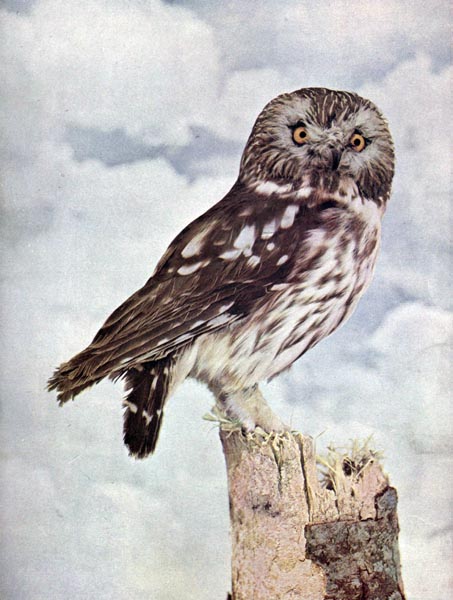
T has been a bitterly cold night, and as the sun
shines on a clear keen morning, and glistens
in the hoar-frost which covers the trees, it
might seem an unpropitious time for visiting the ponds,
in search of microscopic prey. We will, however,
try our luck, and take a brisk trot to the top of
Hampstead Heath, where the air is still keener, and
the ice more thick. Arriving at the highest point,
London appears on one side enveloped in its usual
great coat of smoke, through which St. Paul's big
dome, with a score or two of towers and steeples, can
be dimly made out; while looking towards Harrow-on-the-Hill,
or Barnet, we see the advantage of country
air in the sharpness with which distant objects cut the
blue sky. We leave the large ponds for another time,[31]
and hunt out the little hollows among the furze and
fern. One looks promising from the bright green
vegetation to be discovered under the sheet of ice,
which is almost firm enough to bear human weight.
Breaking a convenient hole we hook up some of the
water-plants, and place them in a wide-mouthed vial,
which we fill with water, and cursorily examine with a
pocket-lens. Some water-fleas briskly skipping about,
and a beautiful little beetle, with an elegant dotted
pattern on his brown back, and a glistening film of air
covering his belly, show that we have not been unsuccessful,
although we must wait till we get home to
know the extent of our findings, among which, however,
we can only discern the graceful spiral shell of a small
water-snail, the Planorbis.
Arriving at home the bottle was left undisturbed for
some hours in a warm light place, and then on being
examined several specimens of that beautiful polyp, the
Hydra viridis, were seen attached to the glass, and
spreading their delicate tentacles in search of prey.
One of the polyps is carefully removed by the dipping-tube,
a small glass tube, open at both ends. The forefinger
is placed upon the top, and when the other end
is brought over the object the finger is raised for an
instant, and as the water rushes in the little hydra
comes too, and is placed in a glass cell, about half an
inch wide, and one tenth of an inch deep. These cells
are obtained from the opticians, and cemented with
varnish or marine glue to an ordinary glass slide.
After an object has been placed in one of them, a little
water is taken up in the dipping-tube, and the cell
[32]filled until the fluid stands in a convex heap above its
brim. We then select around glass cover, and press
[33]it gently on the walls of our cell. A few drops of
superfluous water escape, and we have the cell quite
full, and the cover held tight by force of the capillary
attraction between the water and the glass.
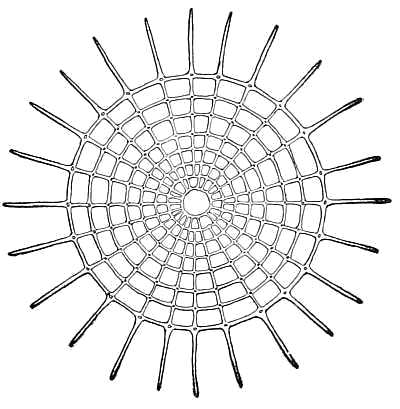
Hydra viridis with developed young one, and bud beginning
to sprout.
The polyp deposited in one of these water cages is
then transferred to the stage of the microscope, and its
proceedings watched. At first it looks like a shapeless
mass of apple-green jelly. Soon, however, the tail end
of the creature is fixed to the glass, the body elongates,
and the tentacles (in this case eight) expand something
after the manner of the leaves of a graceful
palm.
By accident two small Water Fleas were imprisoned
with the polyp, and one (a shrimp-like looking creature,
carrying behind her a great bag of eggs) came
into contact with the tentacles, and seemed paralysed
for a time. The hydra made no attempt to convey the
captive to its mouth, but held it tight until another
Water Flea, a round merry little fellow (Chydorus
sphæricus), came to the rescue, and assisted Canthocamptus
to escape by tugging at her tail. This friendly
action may not have been prompted by the intelligence
which seemed to suggest it, but those who have kept
tame soldier-crabs and prawns in an aquarium, will
not be indisposed to attribute to the crustaceans more
brains than they have usually credit for. It must,
however, be confessed that the subsequent conduct of
Mrs. Canthocamptus did not indicate the possession of
much prudence, for she learnt no lesson from experience,
but repeatedly swam against her enemy's tentacles,
suffered many captures, and only escaped being[34]
devoured through the indifference, or want of appetite,
which the polyp evinced.
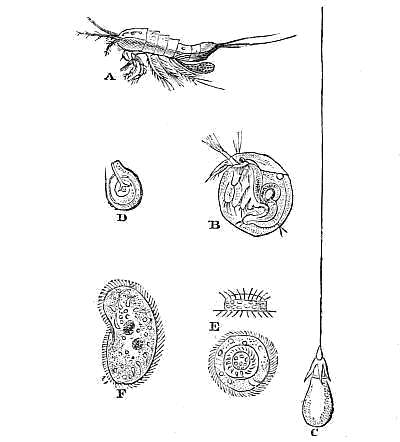
A, Canthocamptus minutus; B, Chydorus sphæricus; C and
D, Capsules and poison-thread of polyp; E, Tricodina pediculus,
side view and under view; F, Kerona polyporum.—Microg.
Dict.
On the body of the Canthocamptus were some
small transparent vases or bottles, containing living
objects, which sprang up and down. These were[35]
members of the Vorticella family, called Cothurnia, and
will be hereafter described.
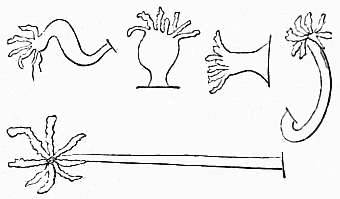
Hydra viridis, in various shapes.
Watching the hydra it was curious to note the
changes of form which these creatures are able to
assume. Now the tentacles were short and thick, and
the body squat; now the body was elongated, like the
stem of a palm tree, and the tentacles hung gracefully
from the top. From some of the polyps little round
buds were growing, while other buds were already
developed into miniature copies of the parent, and only
attached by a slender stalk. In a few days many of
these left the maternal side, fixed their own little tails
to the glass, and commenced housekeeping on their
own account.
Polyps may be obtained at all times of the year by
bringing home duckweed, conferva, and other water-plants
from the ponds. Some hauls may be unsuccessful,
but if one pond is not propitious others should
be tried. The plants should be put in a capacious[36]
vessel of water, and placed in the light, where, if polyps
be present, they will show themselves within twenty-four
hours, either attached to the sides of the glass, or
hanging from the plants, or suspended head downwards
from the upper film of the water. They are elegant
objects, and may be kept without difficulty for some
weeks. After being confined in a small quantity of
water for purposes of examination, they should be carefully
replaced in the larger vessel, and may thus be
used again and again without suffering any injury. A
low power—a three or two-inch glass—or a one-inch,
reduced by employing the erector—is the most
convenient for examining the whole creature, but
higher powers are necessary to make out its minute
structure. They should be viewed with direct and
oblique light, as transparent and also as opaque
objects. In the latter case the "Lieberkuhn," or
polished silver speculum, is convenient, and if the
microscope is not furnished with Lister's dark wells,
a small piece of black paper may be stuck behind the
object, by simply wetting it with the tongue.[4]
[4] The side silver reflector is useful for illuminating such objects.
Although the polyps are remarkable for the simplicity
of their organization, they do not the less
exhibit the wonderful nature of animal life. Their
bodies are composed of the substance, called sarcode,
in which is imbedded a colouring matter resembling that
in the leaves of plants; every part possesses irritability
and contractility, and they are very sensitive to the
stimulus of light. The outer layer of their bodies is
[37]harder than the inner layer. These layers are severally
called ectoderm and endoderm. They may be cut and
grafted like trees, and if turned inside out, the new
inside digests and assimilates as well as the old.
Whether any form of consciousness can belong to
creatures which have no distinct nervous system is
open to doubt, but it would seem probable from their
movements that food and light afford them something
like a pleasurable sensation in a very humble degree.
If we were sufficiently acquainted with the secrets of
molecular combination we might discover that the
various functions of these simple organisms were discharged
by different particles, although it is only in
higher creatures that muscular particles are aggregated
into muscles, or nerve particles into nerves.
Having examined the general appearance and proceedings
of the hydra, let us cut off a tentacle, or take
a small specimen and gently crush it by pressing down
the cover of the live box, and place the object so prepared
under a power of about three hundred linear. If
we then illuminate it with a moderate quantity of oblique
light, we shall discover round the edge of the tentacle
a number of small cells or capsules, from some of
which a very slender wire or thread will be emitted.[5]
These are the stinging organs of the polyp, and
resemble those which Mr. Gosse has so ably elucidated
in the sea anemones. Some writers have endeavoured
to show that they are not stinging organs at all, but so
large an amount of evidence to the contrary is accumulated
in Mr. Gosse's 'Actinologia Britannica,'
[38]that no reasonable doubt remains. The stinging
capsules of the polyp are shown in the annexed sketch,
and also the way in which they are employed, for it
[39]fortunately happened that on exposing one of the
hydras to pressure in the live box, a small worm
(Anguillula) escaped, which had been pierced with the
minute weapons which are supposed to convey a poison
into the wound. The authors of the 'Micrographic
Dictionary' think that the prongs of the forks,
which will be seen to point upwards in the sketch,[6]
are springs, and occupy a reversed position in the
capsule cells, and that their function is to throw out
the threads. However this may be, the polyps, and
similarly endowed creatures, have the power of darting
out their poison threads with considerable force, and
Mr. Gosse found that the anemone was able to pierce
a thick piece of human skin.
[5]
See illustration above.
[6]
See illustration below.
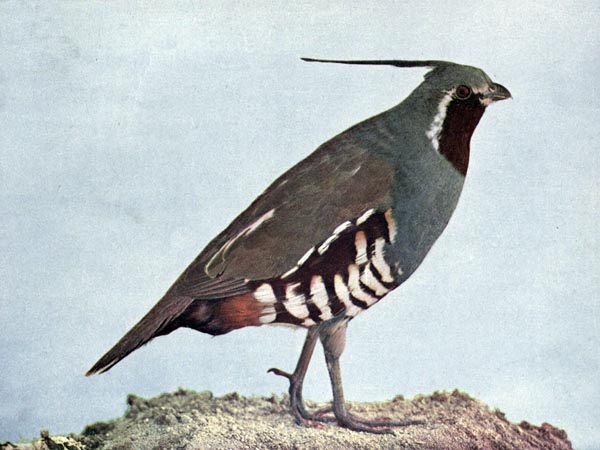
Anguillula pierced by stinging organs of the Hydra viridis.
The same excellent observer attributes the emission
of the anemone poison threads, which he considers
hollow, to the injection of a fluid. In their quiescent
state, he thinks they are drawn in, like the finger of a
glove, and are forced out as the liquid enters their
slender tubes. Possibly the polyp stinging organs may
have the same structure.
Notwithstanding their dangerous weapons, polyps
are often infested with a parasite, the Trichodina pediculus,
as shown in Fig. E, page 49, and it must happen
that either this visitation is not disagreeable, or that
the Trichodina is not influenced by the poison.
As the plants in the bottles decayed, some of the
animalcules died off and others appeared. In one
bottle, containing decaying chara, Paramecia abounded.
The Paramecia, of which there are various species,
[40]have always been favourite objects with microscopists.
The Germans call them "slipper animalcules," and
they vary in size from 1—96"
[7] to 1—1150". They are
flat rounded-oblong creatures, with a distinct integument
or skin, "through which numerous vibratile cilia
pass in regular rows."[8] They are furnished with a
distinct mouth, and adult specimens exhibit star-shaped
contractile vesicles in great perfection.
[7] The usual mode of giving dimensions is by fractions thus
expressed: 1—96" means one ninety-sixth of an inch.
[8] 'Micrographic Dictionary.'
The swarm of specimens before us belong to one
species, Paramecium aurelia, the Chrysalis animalcule,
and they crowd every portion of the little water-drop
we have taken up, and examined with a power of about
one hundred linear. When they are sufficiently quiet
a power of about four hundred may be used with
advantage, and Pritchard recommends adding a little
indigo and carmine to the water, in order to see the
cilia more clearly, or rather to render their action more
plain. The cilia are disposed lengthwise, and Ehrenberg
counted in some rows sixty or seventy of them, making
an aggregate of three thousand six hundred and forty
organs of motion in one small animated speck. This
number seems large, but although we have never performed
the feat of counting them, we should have
expected it to prove much greater. Unlike most
animalcules they are susceptible of being preserved by
drying upon glass, and we subjoin a figure from
Pritchard, of one thus treated, in which the star-shaped
vesicles are clearly seen. These curious organs com[41]municate
with other vessels, and, as we have previously
stated, are probably connected with respiration and
excretion.
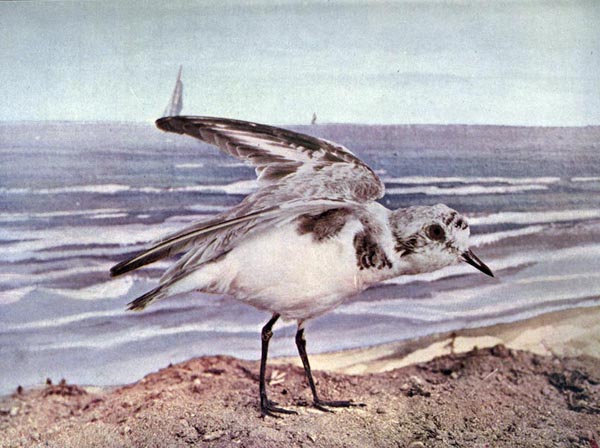
Paramecium aurelia.
A dried specimen showing the vesicles.—Pritchard.
The genus Paramecium is now confined to those
creatures which exhibit rows of longitudinal cilia of
uniform length, which are destitute of hooks, styles, or
other organs of motion than the cilia, which have a
lateral mouth, and no eye-spots. One mode of increase
is by division, which may be easily observed; another
is through the formation of true eggs as traced by
Balbiani.
Another of the treasures from the pond was a species
of Trachelius, or long-necked ciliated animalcule, which
kept darting in and out of a slimy den, attached to the
leaf of a water-plant. The body was stout and fish-shaped,
the tail blunt, and the neck furnished with long
conspicuous cilia, which enabled the advancing and
retreating movements to be made with great rapidity.
The motions of this creature exhibit more appearance
of purpose and design than is common with animalcules,[42]
but in proportion as these observations are prolonged,
the student will be impressed with the difficulty
of assuming that anything like a reasoning faculty and
volition, is proved by movements that bear some
resemblance to those of higher animals, whose cerebral
capacities are beyond a doubt. It is, however, almost
impossible to witness motions which are neither constant
nor periodic, without fancying them to be dictated
by some sort of intelligence. We must, nevertheless,
be cautious, lest we allow ourselves to be deceived by
reasoning so seductive, as the vital operations of the
lowest organisms may be merely illustrations of blind
obedience to stimuli, in which category we must reckon
food, and until we arrive at forms of being which
clearly possess a ganglionic system, we have no certainty
that a real will exists, even of the simplest kind;
and perhaps we must go still higher before we ought to
believe in its presence.
Ehrenberg was much struck with the restless character
of many infusoria—whether he looked at them
by day or by night, they were never still. In fact
their motions are like the involuntary actions which
take place in the human frame; and if attached to
their bodies we observe cilia that never sleep, the
living membrane of some of our own organs, the nose,
for example, is similarly ciliated, and keeps up a perpetual
though unconscious work.
[43]
CHAPTER IV.
MARCH.
Paramecia—Effects of Sunlight—Pterodina patina—Curious tail—Use
of a Compressorium—Internal structure of
Pterodina—Metopidia—Trichodina pediculus—Cothurnia—Salpina—Its
three-sided box—Protrusion of its gizzard mouth.

HE Paramecia, noticed in the last chapter,
have increased and multiplied their kind
without any fear lest the due adjustment
between population and food should fail to be preserved.
A small drop of the scum from the surface of the water
in their bottle is an astounding sight. They move
hither and thither in countless numbers, seldom
jostling, although thick as herrings in a tub, and in
many portions of the field the process of self-fissure, or
multiplication by division, is going on without any
symptoms of discomfort on the part of the parent creature.
This is an interesting sight, but we will not
linger over it, for the sun is shining, and there is enough
warmth in the air to make it probable that the ponds
will be more prolific than in the cold winter months.
Sunshine is a great thing for the microscopic hunter;
it brings swarms of creatures to the surface, and the
Rotifers are especially fond of its genial beams. Even[44]
if we imitate it by a bright lamp, we shall attract
crowds of live dancing specks to the illuminated side of
a bottle, and may thus easily effect their capture by
the dipping-tube.
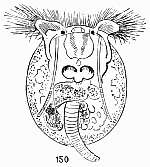
Pterodina patina.
This year the March sunshine was not lost, for on
the third of that month I obtained a bottleful of
conferva from a pond about a mile from my house, and
lying at the foot of the Highgate hills. Water-fleas
were immediately discovered in abundance, together
with some minute worms, and a ferocious-looking larva
covered with scales; but what attracted most attention
was a Rotifer, like a transparent animated soup-plate,
from near the middle of which depended a tail, which
swayed from side to side, as the creature swam along.
The head exhibited two little red eyes; two tufts of
cilia rowed the living disk through the water, and the
gizzard worked with a rapid snapping motion, that left
no doubt the ciliary whirlpools had brought home no
slender stores of invisible food. Sometimes the end of
the tail acted as a sucker, and fixed the animal tightly[45]
to the glass, when the wheels were protruded, and the
body swayed to and fro. Then the sucker action
ceased, and as the creature swam away, a tuft of cilia
was thrust out from the extremity of the tail. A power
of one hundred linear was sufficient to enable the
general nature of this beautiful object to be observed,
but to bring out the details, much greater amplification
was required, and this would be useless if the little
fidget could not be kept still.
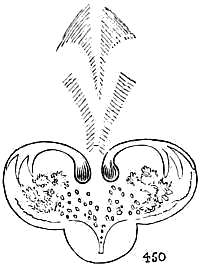
450 Pterodina patina—gizzard.
The size of the creature, whose name we may as well
mention was Pterodina patina, rendered this practicable,
but required some care. The longest diameter of the
body, which was not quite round, was about 1—120",
so that it was visible to the naked eye, and as a good
many were swimming together, one could be captured
without much difficulty, and transferred with a very
small drop of water to the live-box. Then the cover[46]
had to be put on so as to squeeze the animal just
enough to keep it still without doing it any damage, or
completely stopping its motions. This was a troublesome
task, and often a little overpressure prevented its
success.
Some observers always use in these cases an instrument
called a compressorium, by which the amount of
pressure is regulated by a lever or a fine screw; but
whether the student possess one or not, he should learn
to accomplish the same result by dexterously manipulating
a well-made live-box. We will suppose the
Pterodina successfully caged, and a power of about one
hundred and fifty linear brought to bear upon her, for
our specimen is of the "female persuasion." This will
suffice to demonstrate the disposition and relation of
the several parts, after which one of from four hundred
to five hundred linear may be used with great advantage,
though in this case the illumination must be
carefully adjusted, and its intensity and obliquity frequently
changed, until the best effect is obtained.
We find, on thus viewing the Pterodina, that it is
a complex, highly organized creature, having its body
protected by a carapace, like the shell of a tortoise, but
as flexible as a sheet of white gelatine paper, which it
resembles in appearance. Round the margin of this
carapace are a number of little bosses or dots, which
vary in different individuals. The cilia are not disposed,
as at first appeared, in two separate and distinct disks,
but are continuous, as in the annexed sketch. Down
each side are two long muscular bands, distinctly
striated, and when they contract, the ciliary apparatus[47]
is drawn in. As this contraction takes place, two
apparently elastic bands, to which the ciliary lobes are
attached, are bent downwards, till they look like the C
springs behind a gentleman's carriage; and they regain
their former position of slight curvature, when the cilia
are again thrust out.
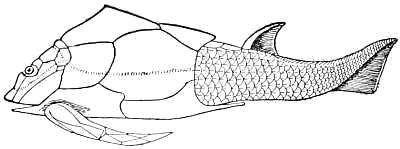
Pterodina patina—tail-foot.
The gizzard is three-lobed, and curiously grasped by
forked expansions of the handles of the hammers. The
tail, or tail-foot, can be withdrawn or thrust out at the
will of the creature; and when in a good position for
observation, a slight additional pressure will keep it so
for examination. Delicate muscular longitudinal bands,
forked towards the end of their course, supply the means
of performing some of its motions, and one, or perhaps
two, spiral threads extend through the upper half of its
length, and either act as muscles, or as elastic springs for
its extension. The intestines and other viscera are
clearly exhibited, and a strong ciliary action conducts
the food to the gizzard-mouth.
To return to the tail. One spiral fibre is easily discovered;[48]
but I have often, and at an interval of months,
seen the appearance of two, and am in some doubt
whether this was a deception, arising from the compression
employed, or was a genuine indication.
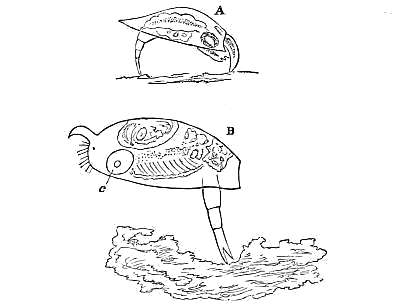
A. Metopidia acuminata, as drawn by Mr. Gosse. B. Specimen
as seen and described in text. c. Mouth or gizzard.
Where this Rotifer occurs I have usually found it
plentiful, but unfortunately could obtain no constant
supplies after I had determined to make a special study
of the remarkable tail, which is much more complicated
than I have described. The Pterodina lived for some
time in captivity, and for a week or two I could obtain
them from my glass tank. They were likewise to be
found for some weeks in the same part of the pond, but
not all over it, until one day not a single specimen
could be discovered, notwithstanding a persevering search[49]
nor was I afterwards able to get any from that pond
during the remainder of the year.
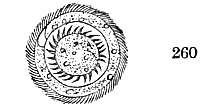
Trichodina pediculus.
Several other Rotifers, with and without carapaces,
were among the same mass of confervæ, among them
a Metopidia, with a firm shell, a forked jointed tail, and
a projection in front which worked like a pickaxe among
the decaying weed. There were likewise specimens of
the long-necked animalcules (Trachelii), groups of
Vorticella, some specimens of Volvox, and a small
Trichodina pediculus, which, when magnified two hundred
and sixty linear, was about the size of a sixpence
and equally round. The edge was beautifully fringed
with a circle of cilia; in an inner circle was a row of
locomotive organs, and the centre exhibited vacuoles
constantly opening and shutting. This creature, as
before explained, is often found as a parasite upon the
polyps. On one occasion a glimpse was caught of a
Rotifer similar in shape to the common wheel animalcule,
but with a yellow inside. Possibly it was the
object so beautifully delineated by Mr. Gosse, in his
"Tenby," and described as the "Yellow Philodine,"
but this must remain in doubt, as it managed to escape
before it could be secured.
[50]
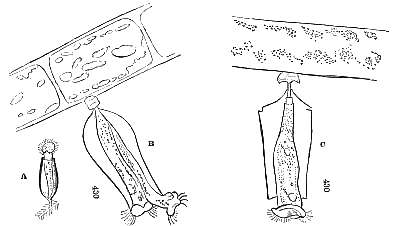
A. Cothurnia imberbis—('Micrograph. Dict.') B and C. The specimens described in text.
The figures give the linear magnification.
[51]
By the 18th of the month the Vorticellids were much
more plentiful, and their changes easily watched; many
left their stalks while under the microscope, after which
some rushed about like animated and demented hats,
others twirled round like tee-to-tums, while others took
a rest before commencing their wild career. But the
common Vorticellæ were not the only or the most interesting
representations of their charming order, for
upon some threads of conferva were descried several
elegant crystal vases standing upon short foot-stalks,
and containing little creatures that jumped up and down
like "Jack in the box." These were so minute, that a
power of four hundred and thirty linear was advantageously
brought to bear upon them. When elongated
their bodies were somewhat pear-shaped, but more
slender, and variegated with vacuoles and particles of
food. The mouths resembled those of Vorticellæ, and
put forth circles of vibrating cilia. They were easily
alarmed, when the cilia were retracted, and down they
sank to the bottom of their vases, quickly to rise again.
In one bottle there were two living in friendly juxtaposition.
This was not a case of matrimonial felicity,
nor of Siamese twins, but of fission, or reproduction by
division. The original inhabitant of the tube finding
himself too fat, or impelled by causes we do not understand,
quietly divided himself in two, and as the house
was big enough, no enlargement was required. How
many stout puffy gentlemen must envy this process;
how convenient to have two thin lively specimens of
humanity made out of one too obese for locomotion.
Man is, however, sometimes the victim of his superior[52]
organization, and no process of "fission" can make the
lusty lean.[9]
[9] Balbiani in his 'Recherches sur les Phénomènes Sexuels des Infusoires,'
speaks of the Vorticellids as the only Infusoria dividing longitudinally.
In other species such appearances arise from conjunction.
The bottles in which these creatures live, in happy
ignorance that they are called by so crackjaw a name
as Cothurnia imberbis, were described as Carapaces by
Ehrenberg, but they bear no resemblance to the shell
of a turtle or crab. They are thrown off by the animals
who preserve no other connection with them than the
attachment at the bottom.
The Micrographic Dictionary describes the family
Ophrydina as corresponding to Vorticellina with a carapace.
Stein places them with Vorticellids, &c., amongst
his Peritricha, which are characterised by a spiral
wreath of cilia round the mouth.
Towards the end of the month a great number of
black pear-shaped bodies (Stentor niger), visible to
the naked eye, were conspicuous in some water from
the Kentish Town ponds. Upon examination they
were found to be filled with granules that were red by
reflected, and purple by transmitted light. Each one
had a spiral wreath of cilia, with a mouth situated like
those of the stentors, hereafter to be described, but none
of them became stationary, and in a few days they all
disappeared. Stein divides Ehrenberg's Stentor igneus
from S. niger; the creature described seems to have
agreed with Stein's igneus, which he describes as having
blood-red lilac, cinnabar, or brown-red pigment particles,
and as much smaller than his S. niger. In the same[53]
water were specimens of that singular Rotifer, the
Salpina, about 1—150" long, and furnished with a
lorica, or carapace, resembling a three-sided glass
box, closed below, and slightly open along the
back. At the top of this box were four, and at the
bottom three, points or horns, and the creature had
one eye and a forked tail. Keeping him company
was another little Rotifer, named after its appearance,
Monocerca rattus, the 'One-tailed Rat.' This little
animal had green matter in its stomach, which was in
constant commotion. I ought to have observed that
the Salpina repeatedly thrust out its gizzard, and used
it as an external mouth. In the annexed sketch the
Salpina is seen in a position that displays the dorsal
opening of the carapace. Its three-cornered shape is
only shown by a side view.
Here we close a brief account of what March winds
brought in their train. The next chapter will show the
good fortune that attended April showers.
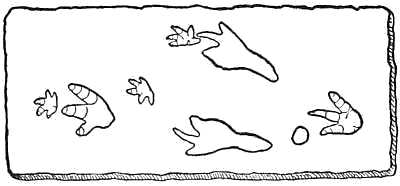
Salpina redunca.
[54]
CHAPTER V.
APRIL.
The beautiful Floscule—Mode of seeking for Tubicolor Rotifers—Mode
of illuminating the Floscule—Difficulty of seeing the transparent
tube—Protrusion of long hairs—Lobes—Gizzard—Hairy lobes of
Floscule not rotatory organs—Glass troughs—Their construction
and use—Movement of globules in lobes of Floscule—Chætonotus
larus—Its mode of swimming—Coleps hirtus—Devourer of dead
Entomostraca—Dead Rotifer and Vibriones—Theories of fermentation
and putrefaction—Euplotes and Stylonichia—Fecundity of
Stylonichia.

EW living creatures deserve so well the appellation
of "beautiful" as the Floscularia ornata,
or Beautiful Floscule, although to contemplate
a motionless and uncoloured portrait, one would
imagine that it exhibited no graces of either colour or
form. Mr. Gosse has, however, done it justice, and
the drawing in his "Tenby" is executed with that
rare combination of scientific accuracy and artistic
skill, for which the productions of his pencil are
renowned.
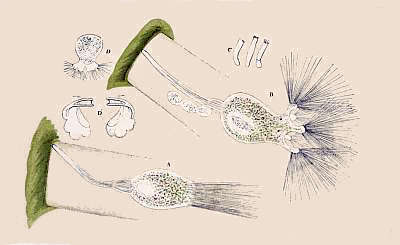
The Beautiful Floscule. A.—Partially protruded. B.—Freely protruded, with three eggs. C.—Appearance
of young. D.—Floscule seventeen hours old. D'.—Jaws of Floscule, as figured by Mr. Gosse.
Probably the sketches in several works of authority
representing the long cilia as short bristles, are merely
copies from old drawings, from objects imperfectly
[55]seen under indifferent microscopes, and before the
refinements of illumination were understood. Be this
as it may, any reader will be fortunate if on an April,
or any other morning, he or she effects the capture of
one of these exquisite objects, although the first impression
may not equal previous expectations, as the
delicacy of the organism is not disclosed by a mode of
using the light which answers well enough for the
common infusoria.
When the Floscules, or other tubicolar Rotifers are
specially sought for, the best way is to proceed to a
pond where slender-leaved water-plants grow, and to
examine a few branches at a time in a phial of water
with a pocket-lens. They are all large enough to be
discerned, if present, in this manner, and as soon as
one is found, others may be expected, either in the
same or in adjacent parts of the pond, for they are
gregarious in their habits. With many, however, the
first finding of a Floscule will be an accident, as was
the case last April, when a small piece of myriophyllum
was placed in the live-box, and looked over to see
what it might contain. The first glimpse revealed an
egg-shaped object, of a brownish tint, stretching itself
upon a stalk, and showing some symptoms of hairs or
cilia at its head. This was enough to indicate the
nature of the creature, and to show the necessity for a
careful management of the light, which being adjusted
obliquely, gave quite a new character to the scene.
The dirty brown hue disappeared, and was replaced by
brilliant colours; while the hairs, instead of appearing
few and short, were found to be extremely numerous,[56]
very long, and glistening like delicate threads of spun
glass.
Knowing that the Floscules live in transparent
gelatinous tubes, such an object was carefully looked
for, but in this instance, as is not uncommon, it was
perfectly free from extraneous matter, and possessed
nearly the same refractive power as the water, so that
displaying it to advantage required some little trouble
in the way of careful focusing, and many experiments
as to the best angle at which the mirror should be
turned to direct the light. When all was accomplished,
it was seen that the Floscule had her abode in a clear
transparent cylinder, like a thin confectioner's jar,
which she did not touch except at the bottom, to which
her foot was attached. Lying aside her in the bottle
were three large eggs, and the slightest shock given to
the table, induced her to draw back in evident alarm.
Immediately afterwards she slowly protruded a dense
bunch of the fine long hairs, which quivered in the
light, and shone with a delicate bluish-green lustre,
here and there varied by opaline tints.
The hairs were thrust out in a mass, somewhat after
the mode in which the old-fashioned telescope hearth-brooms
were made to put forth their bristles. As soon
as they were completely everted, together with the
upper portion of the Floscule, six lobes gradually
separated, causing the hairs to fall on all sides in a
graceful shower, and when the process was complete,
they remained perfectly motionless, in six hollow fan-shaped
tufts, one being attached to each lobe. Some
internal ciliary action, quite distinct from the hairs,[57]
and which has never been precisely understood, caused
gentle currents to flow towards the mouth in the
middle of the lobes, and from the motion of the gizzard,
imperfectly seen through the integument, and from the
rapid filling of the stomach with particles of all hues,
it was plain that captivity had not destroyed the
Floscule's appetite, and that the drop of water in the
live-box contained a good supply of food.
Sometimes the particles swallowed were too small to
be discerned, although their aggregate effect was
visible; but often a monad or larger object was ingulfed,
but without any ciliary action being visible to
account for the journey they were evidently compelled
to perform. The long hairs took no part whatever in
the foraging process, and as they do not either provide
victuals or minister to locomotion, they are clearly not,
as was supposed by early observers, representatives of
the "wheels," which the ordinary Rotifers present.
Neither can the cylindrical jar or bottle be justly
deemed to occupy the position of the lorica, or carapace
which we have before described. The general structure
of the creature and the nature of its gizzard distinctly
marked it out as a member of the family we call
"Rotifers," but the absence of anything like "wheels"
proves that those organs are not essential characteristics
of this class.
Noticeable currents are not always produced when
the mouth of this Floscule is fully expanded. On one
occasion, one having five lobes was discovered standing
at such an angle in a glass trough that the aperture
could be looked down into. The position rendered it[58]
impossible to use a higher power than about two
hundred linear, but with this, and the employment of
carmine, nothing like a vortex was seen during a whole
evening, although a less power was sufficient to show
the ciliary whirlpools made by small specimens of
Epistylis and Vaginicola, which were in the small
vessel. The density of the integument was unfavorable
to viewing the action of the gizzard, but it could be
indistinctly perceived. The contractions and subsequent
expansions of the cup, formed by the upper part of the
creature, may be one way in which its food is drawn
in, but there is no doubt it can produce currents when
it thinks proper. Sometimes animalcules in the
vicinity of Floscules whirl about as if under the influence
of such currents. Some may be seen to enter the
space between the lobes, swim about inside, and then
get out again, while every now and then one will be
sucked in too far for retreat.
Above the gizzard in the Horned Floscule,[10] I have
seen an appearance as if a membrane or curtain was
waving to and fro, while another was kept in a fixed
[59]perpendicular position. Mr. Gosse, speaking of this
genus, observes "that the whole of the upper part of
the body is lined with a sensitive, contractile, partially
opaque membrane, which a little below the disk recedes
from the walls of the body, and forms a diaphragm,
with a highly contractile and versatile central orifice.
At some distance lower down another diaphragm
occurs, and the ample chamber thus enclosed forms a
kind of crop, or receptacle for the captured prey."
[10] The Horned Floscules (F. cornuta) which I have found, and which
bred in a glass jar, were not so large as those described by Mr. Dobie,
as quoted in 'Pritchard's Infusoria.' Mr. Dobie's specimens were
1—40" when extended; mine about half that size, five-lobed, and with
a long slender proboscis, standing in a wavy line outside one lobe.
Mr. Dobie also describes an F. campanulata, with five flattened lobes.
The 'Micrographic Dictionary' pronounces these two species "doubtfully
distinct." I have three or four times met with a variety of
F. ornata, in which one lobe was much enlarged and flattened, but
they had no proboscis. In what I take for F. cornuta, the horn or
proboscis has sometimes been a conspicuous object, and at others so fine
and transparent as to be only visible in certain lights.
"From the ventral side of the ample crop that
precedes the stomach, there springs in F. ornata a
perpendicular membrane or veil, partly extending
across the cavity. This is free, except at the vertical
edge, by which it is attached to the side of the
chamber, and being ample and of great delicacy, it
continually floats and waves from side to side. At the
bottom of this veil, but on the dorsal side, are placed
the jaws, consisting of a pair of curved, unjointed, but
free mallei, with a membranous process beneath each."
The Beautiful Floscule could always be made to
repeat the process of retreating into her den, and
coming out again to spread her elegant plumes before
our eyes, by giving the table a smart knock, and her
colours and structure were well exhibited by the dark-ground
illumination, which has been explained in a
previous page.
An object like this should be watched at intervals
for hours and even days, especially if the eggs are
nearly ready to give up their infantile contents. This
was the case with the specimen described, and after a
few hours a young Floscule escaped, looking very much[60]
like a clumsy little grub. After a few awkward
wriggles the new-born baby became more quiet, and on
looking at it again at the expiration of seventeen hours,
it had developed into the shape of a miniature plum-pudding,
with five or six tiny lobes expanding their
tufts of slender hair. Unfortunately its further proceedings
were not seen, or it would have been
interesting to note the growth of the foot, and the
formation of the gelatinous tube, which is probably
thrown off in rings.
To view the details of the structure of a Floscule, it
must be placed in a live-box or compressorium, and if
specimens are scarce, they should not be allowed to
remain in the limited quantity of water those contrivances
hold, after the observations are concluded, but
should be carefully removed, and placed in a little vial,
such as homœopathists use for their medicine. By
such means an individual may be kept alive for many
days. It is also interesting to place a little branch
of the plant occupied by Floscules or similar creatures,
in a glass trough, where they may be made quite at
home, and their proceedings agreeably watched by a
one-inch or two-thirds power. These troughs,[11] which
can be obtained of the optician, should be of plate
glass, about three inches long, nearly the same height,
and about half an inch wide. If narrower, or much
taller, they will not stand, which is a great incon[61]venience.
The pieces of glass are stuck together with
marine glue, and a very simple contrivance enables the
plants or other objects to be pressed near the front, and
thus brought into better view. A strip of glass, rather
narrower than the width of the trough, is dropped into
it, and allowed to fall to the bottom. Then a piece of
glass rather shorter than the trough, and rather higher
than its front side, is placed so as to slope from the
front of the bottom towards the back at the top. The
piece of glass first dropped in keeps it in the right
position, and the trough is thus made into a V-shaped
vessel, wide at the top and gradually narrowing. Any
object then placed in it will fall till it fits some part of
the V, where it will remain for observation. A small
wedge of cork enables the moveable piece of glass to
be thrown forwards, until it assumes any angle, or is
brought parallel to the front of the trough.
[11] The shallow cells with thin sliding covers devised by Mr. Curteis
(of Baker's), are still more convenient when no pressure is required,
and the objects are small. When not under the microscope they can
be kept full of water by immersion in a tumbler.
A power of five or six hundred diameters generally
enables a movement of small globules to be seen at the
extremity of the lobes of the Floscule, and the gizzard
may be made plain by dissolving the rest of the creature
in a drop of solution of caustic potash. It also becomes
more visible as the supply of food falls short. Mr.
Gosse describes the body as "lined with a yellowish
vascular membrane," and young specimens exhibit two
red eyes, which may or may not be found in adults.
When these eyes of Rotifers are not readily conspicuous,
they must be sought for by opaque illumination, or by
the dark-ground method which, especially with the
parabola, is successful in bringing them out.
Naturalists, and possibly the specimens also, do not[62]
always agree in the number of lobes assigned to the
"Beautiful Floscule," and although it is easy enough
to count them in some positions, the observer may have
to exercise a good deal of patience before he is certain
whether they are five or six. For a long evening only
five could be discerned in the specimen now described,
but the next night six were apparent without difficulty
or doubt. The hairs also will not appear anything like
their true length or number, unless the object-glass is
good, and great care is taken not to obscure them by a
blaze of ill-directed light.

Chætonotus larus (swimming).
After the Floscules had been sufficiently admired and
put aside, for observations to be repeated on future
occasions, a Rotifer attracted attention by his merry-andrew
pranks, throwing himself in all directions by
means of two long and extremely mobile toes attached
to his tail-foot. Then came a creature swimming like
an otter, thrusting his head about on all sides, and
looking much more intelligent than most of his compeers
of the pond. Looked at vertically, he was somewhat[63]
slipper-shaped, the rounded heel forming his head, then
narrowing to a waist, and expanding towards the other
end, which projected in a fork. All round him were
long cilia, which were conspicuous near the head, and a
fine line indicated the passage from his mouth to the
stomach, which seemed full of granular matter. Presently
he took to crawling, or rather running, over a
thread of conferva, and then his back was elegantly
arched, and his cilia stood erect like the quills of a
porcupine. This was the Chætonotus larus.
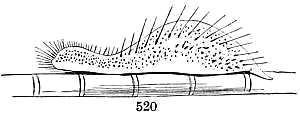
Chætonotus larus (crawling).
In Pritchard's "Infusoria," the views of those writers
are followed who rank this animal amongst the Rotifers,
and place it in the family Icthidina. To help out this
theory, the cilia upon the ventral surface are imagined
to form a "band-like rotary organ;" but in truth they
bear no resemblance whatever to the so-called wheels of
the ordinary Rotifers, nor is there anything like the
gizzard which true Rotifers present. Ehrenberg treated
it as a Rotifer, and Dujardin placed it among the Infusoria,
in a particular class, comprehending symmetrical
organisms. The 'Microscopic Dictionary'
remarks that its "structure requires further investigation,"[12]
[64]and while the learned decide all the intricate
questions of its zoological rank, the ordinary observer
will be pleased to watch its singular aspect and lively
motions. Its size, according to the 'Micrographic
Dictionary,' varies from 1—710" to 1—220", and while
its general proceeding may be watched with an inch or
two-thirds object-glass, and the second eye-piece, a
power of five hundred linear (obtained by a quarter or
a fifth) is required to make out the details of its structure.
If placed in a live-box with threads of conferva,
and a little decayed vegetation, it may be observed to
group about among them, and shake them like a dog.
[12] See a valuable paper by Mr. Gosse, "History of the Hairy-backed
Animalcules," 'Intellectual Observer,' vol. v, p. 387, in which the
known species are described and reasons given for following Vogt and
ranging them with the Turbellarian worms.
We have said that water-fleas were among the inhabitants
of a bottle filled at the pond, and as they go
the way of all flesh, it is common to find some odd-looking
animalcules ready to devour their mortal
remains. These are creatures shaped like beer-barrels,
upon short legs, and which swim with a tubby rolling
gait. Looking at one of these little tubs lengthwise, a
number of lines are seen, as though the edge of each
stave projected a little above the general level, and
transverse markings are also apparent, which may be
compared to hoops. This is the Coleps hirtus, which
differs from the usual type of Infusoria, by being symmetrical,
that is, divisible into two equal and similar
halves. The dimensions of this species vary from
1—570 to 1—430, and its colour varies from white to
[65]brown. It has been observed to increase by transverse
self-division, and has two orifices, one at each end, for
receiving food and ejecting the remains. It often
requires some little trouble to get a good view of the
cilia, which are arranged in transverse and longitudinal
rows. A power of one hundred and fifty linear is
convenient for viewing it in motion, but when quiet
under pressure, one of five or six hundred may be used
with advantage.
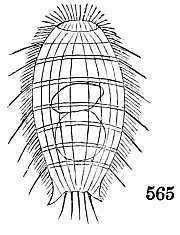
Coleps hirtus.
Among the rubbish at the bottom of the bottle, in
which the coleps was found, was a minute dead Rotifer,
the flesh of which was fast disappearing, but upon being
examined with a power of nine hundred and sixty
diameters, it was observed to swarm with extremely
minute vibriones, the largest only appearing under that
immense magnification like chains of bluish-green
globules, not bigger than the heads of minikin pins,
while the smallest were known by a worm-like wriggling,
although their structure could not be defined.[66]
These vibriones are probably members of the vegetable
world, and they always appear when animal matter
undergoes putrefaction.
M. Pasteur has brought forward elaborate experiments
to show that the development of the yeast plant is an
act correlative to alcoholic fermentation, and in like
manner the growth of vibriones may stand in correlation
to putrefactive decomposition.
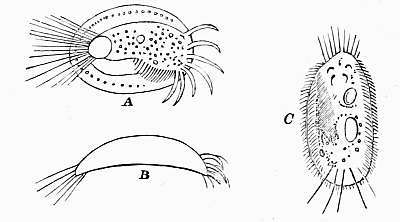
A, Euplotes (patella); B, side view of ditto; C, stylonichia.
Ehrenberg considered them animals, and fancied he
detected in them a plurality of stomachs; but the
vegetable theory is the more probable, at any rate of the
species under our notice, which is often seen, though
not always so minute.
At this time two interesting animalcules were very
plentiful—the Euplotes patella, and Stylonichia, both
remarkable as exhibiting an advance in organization,
which approximates them to the higher animals. In
addition to cilia they possess styles, which take the[67]
place of the limbs of more elaborately-constructed
creatures, and give a variety to their means of locomotion.
The Euplotes is furnished with an oval carapace
covering the upper surface, which in different individuals,
and probably at different ages, exhibits slightly
varied markings round its margin, which in the specimen
drawn above consisted of dots. They can run, climb,
or swim, and exemplify a singular habit which several
of the infusoria possess, that of moving for a little time
in one direction, and then suddenly, and without any
apparent cause, reversing it. If the reader is fond
of learned appellations, he can call this diastrophy,
but we do not know that he will be any the wiser
for it.
The Stylonichia are oval animalcules, surrounded by
cilia, and having moreover a collection of styles, both
straight and curved, the latter called uncini, or little
hooks. They swim steadily on, and then dart back, but
not so far as they have advanced, and may be seen to
keep up this fidgety motion by the hour together.
Pritchard tells us Ehrenberg found that a single animalcule
lived nine days; during the first twenty-four
hours it was developed by transverse self-division into
three animals; these in twenty-four hours formed two
each in the same manner, so that by self-division only
(without ova), these animalcules increased three or four-fold
in twenty-four hours, and may thus produce a million
from a single animalcule in ten days. Such are the
amazing powers of reproduction conferred upon these
humble creatures, powers which are fully employed
when the surrounding circumstances are favorable,[68]
and which, in the aggregate, change the condition of
large masses of matter, and bring within the circle of
life millions upon millions of particles every minute of
the day.
[69]
CHAPTER VI.
MAY.
Floscularia cornuta—Euchlanis triquetra—Melicerta ringens—its
powers as brickmaker, architect, and mason—Mode of viewing the
Melicerta—Use of glass-cell—Habits of Melicerta—Curious
Attitudes—Leave their tubes at death—Carchesium—Epistylis—Their
elegant tree forms—A Parasitic Epistylis like the "Old Man
of the Sea"—Halteria and its Leaps—Aspidisca Lynceus.

AY, the first of summer months, and of old
famous for floral games, which found their
latest patrons in the chimney-sweeps of
London, is a good time for the microscopist among the
ponds, for the increase of warmth and heat favours both
animal and vegetable life, and so we found as we carried
home some tops of myriophyllum, and soon discovered
a colony of tubicolor rotifers among the tiny
branches. They proved to be Floscules, generally
resembling the F. ornata, described in a previous page,
but having a long slender proboscis hanging like a
loose ringlet down one side. The cilia or hairs were
not so long as in the Beautiful Floscules we had before
obtained, nor was their manner of opening so elegant;
but they were, nevertheless, objects of great interest,
and were probably specimens of the Floscularia cornuta.
A swimming rotifer in a carapace somewhat fiddle-shaped,[70]
with one eye in its forehead, and a two-pronged
tail sticking out behind (the Euchlanis triquetra), also
served to occupy attention; but a further search among
the myriophyllum revealed more treasures of the tube-dwelling
kind. These were specimens of that highly
curious Rotifer, the Melicerta ringens, who, not content
with dwelling, like the Floscules, in a gelatinous
bottle, is at once brickmaker, mason, and architect,
and fabricates as pretty a tower as it is easy to conceive.
The creature itself stands upon a retractile foot-stalk,
and thrusts out above its battlements a large
head, with four leaf-like expansions surrounded by
cilia. Between the lower lobes, or leaves, the gizzard
is seen grinding away, and above it is an organ, not
always displayed, and of which Mr. Gosse was fortunate
enough to discover the use. This eminent naturalist
likens it to the circular ventilator sometimes inserted
in windows, and he found it was the machine for
making the yellow ornamental bricks of which the
tower is composed. Pellet by pellet, or brick by brick,
does the Melicerta build her house, which widens
gradually from the foundation to the summit, and every
layer is placed with admirable regularity.
In order to obtain the materials for her brickmaking
the Melicerta must have the power of modifying the
direction of the ciliary currents, so as to throw a stream
of small particles into the mould, which is a muscular
organ, and capable of secreting a waterproof cement, by
which they are fastened together. The result is, not to
produce anything like the tubes made by the caddis-worms
out of grains of sand, but entirely to change[71]
the appearance of the materials employed. All large
particles are rejected, and only those retained which
will form a homogeneous pulp with the viscid secretion;
and when the process is complete the head of the creature
is bent down, and the pellet deposited in its appropriate
place. Each pellet appears originally to possess
a more or less conical figure, but when they are
squeezed together to make a compact wall they all tend
to a hexagonal form, by which they are able to touch
at all points, and any holes or interstices are avoided.
According to Professor Williamson the young
Melicerta commences her house by secreting "a thin
hyaline cylinder," and the first row of pellets are
deposited, not at the base as would be expected, but in
a ring about the middle of the tube. "At first new
additions are made to both extremities of the enlarging
ring; but the jerking constrictions of the animal at
length force the caudal end of the cylinder down upon
the leaf, to which it becomes securely cemented by the
same viscous secretion as causes the little spheres to
cohere."
Round the margins of the lobes or expansions may
be seen delicate threads towards which others radiate;
these are thought by Mr. Gosse to be portions of a
nervous system, and two calcars or feelers serve as
organs of relation. The young Melicertas are likewise
furnished with a pair of eyes, which are probably
rudimentary, and disappear as they grow up.
The Melicerta tubes, being large enough to be visible
to the naked eye, are easily crushed in the live-box,
and to avoid this, they are conveniently viewed in a[72]
shallow glass cell, covered up as before described. By
occasionally changing the water one may be kept for
days in the same cell, and will reward the pains by frequently
exposing its flower-like head. Usually the
horns or feelers come out first, and then a lump of flesh.
After this, if all seems right, the wheels appear, and
make a fine whirlpool, as may be readily seen by the
use of a little indigo or carmine.
The Melicerta is, however, an awkward object to
undertake to show to our friends, for as they knock at
the door she is apt to turn sulky, and when once in this
mood it is impossible to say when her fair form will
reappear. At times the head is wagged about in all
directions with considerable vehemence, playing singular
antics, and distorting her lobes so as to exhibit a
Punch and Judy profile. When these creatures die
they leave their tubes, which are often found empty in
the ponds they frequent. The Melicertas are conveniently
viewed with a power of from sixty to one
hundred linear, and a colony of them may be kept alive
for some weeks in a glass jar or tank.
Among the remainder of my tiny captives were two
beautiful members of the Vorticella family, Epistylis
and Carchesium. The reader will remember that in
the Vorticella previously described, the bells stood upon
stalks that were very flexible, and retractile by means
of a muscle running down their length. The Epistylis
is, as its name imports, the dweller on a pillar. The
stem is stiff, or only slightly flexible, and has no apparatus
by which it can be drawn down. The specimen
mentioned stood like a palm-tree, and the large oval[73]
bells drooped elegantly on all sides, as its portrait will
show. At times they nodded with a rapid jerk.

Epistylis.
The Carchesium differs from the common Vorticella,
by branching like a tree, but the stems are all retractile,
although the trunk seldom exercises the power.
A group of these creatures presents a spectacle of extraordinary
beauty—it looks like a tree from fairy-land,
in which every leaf has a sentient life. In general
structure the bells of the Epistylis and the Carchesium
resemble the common Vorticella, and like them may be
seen with a power of about one hundred linear for
general effect, and with a higher one for the examination[74]
of special points. Pritchard notices three species
of Carchesium, and eighteen of Epistylis;[13] some of
which it is to be hoped will turn out to be only varieties.
[13]
An interesting Epistylis, called Digitalis, from its bells resembling
fox-glove flowers in shape, occurs as a parasite upon the Cyclops quadricornis,
a very common entomostracan in fresh-water ponds. At this
moment I have a beautiful specimen, branching like a bushy tree, and
attached to the tail of a Cyclops, who can scarcely move under his
burden, which is like Sinbad's "Old Man of the Sea." (See illustration above.)
Towards the end of this month rotifers abounded, and
polyps were plentiful. Among the rotifers was one
about a two-hundredth of an inch long, protected by a
carapace, and having a tail terminating in a single style,
hence called "Monostyle." There is perhaps no class
of creatures that present so many curious and unexpected
forms as the rotifers; and although we have
noticed a good many, there are far more that remain to
be found and described.
The water in which the preceding animals dwelt was
enlivened by the jumps of the Halteria, a little globe
surrounded by long fine cilia, with which its movements
were effected; and its companion was the Aspidisca
lynceus, an oval animalcule, having a distinct cilia or
lorica, and furnished, in addition to cilia, with bristles,
which enable it to walk and climb as well as swim.
There were also some eggs of rotifers attached to the
water plants, in which motion could be descried at intervals,
and a little red eye observed. These eggs are
always large in proportion to the creatures that
lay them, and if they escape being devoured by
[75]enemies, may be watched until their contents step
forth.
In this, as in other months, omission is made of
creatures that have already come under notice, or our
list would assume larger dimensions.
[76]
CHAPTER VII.
JUNE AND JULY.
Lindia Torulosa—Œcistes Crystallinus—A professor of deportment on
stilts—Philodina—Changes of form and habits—Structure of
Gizzard in Philodina family—Mr. Gosse's description—Motions of
Rotifers—Indications of a will—Remarks on the motions of lower
creatures—Various theories—Possibility of reason—Reflex actions
Brain of insects—Consensual actions—Applications of physiological
reasoning to the movements of Rotifers and Animalcules.

PRESSURE of other occupations prevented
full use being made of June and July, nor
was the weather at all propitious. For this
reason the microscopic doings of these two months are
recorded in one chapter.
As usual the Kentish Town ponds were productive
of objects, and among them were several rotifers not
found in the previous months. The first of these was a
very small worm-like thing, with one eye, a tuft of cilia
about the mouth, and two toes at the tail end. Had it
not been for the jaws, which were working like fingers
thrust against each other, and which were unmistakably
of the rotifer pattern, the animal might have been
supposed to belong to some other class. According to
the 'Micrographic Dictionary,' the Lindia torulosa is
1—75" long, but this specimen was only about 1—200".[77]
It was possibly very young, and did not thrust out its
cilia in two distinct tufts, as Cohn describes, although
it may have had the power of doing so. At times it
sprang quickly backwards and forwards, bringing its
head where its tail was before. This object required for
its comfortable elucidation a power of about six hundred
linear.
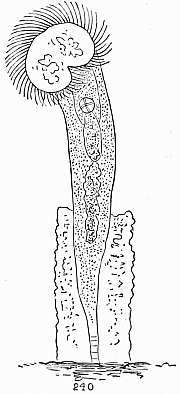
Œcistes crystallinus.
Among the common water-plants, which are worth
examining as the probable abodes of rotifers or infusoria,
is the pretty little thing called "star-weed,"
some of which was obtained from the last-mentioned[78]
ponds, and on examination yielded a specimen of a
tube-dwelling rotifer, the Œcistes crystallinus, which,
although less beautiful than the Floscules or the
Melicerta, is, nevertheless, a pretty and interesting
object. In this instance a little rough dirty tube, about
1—70" long, was observed to contain an animal capable
of rising up and expanding a round mouth garnished
with a wreath of cilia; while a little below, the indefatigable
and characteristic gizzard of the tribe was in
full play. A power of two hundred and forty linear
sufficed to afford a good view, and it was seen that a
long, irregular, conical body was supported upon a short
wrinkled stalk. The usual drawings represent this
creature with a short bell-shaped body upon a very long
slender pedicle. Possibly this one might have been able
to show himself under this guise, but he did not attempt
it; his appearance being always pretty much as described,
which made the foot shorter and the body
longer than the measurements which naturalists have
given, and according to which the whole creature is
1—36" long, although the body is only 1—140". The
tube of the Œcistes is called a "lorica," or carapace;
but it has in truth no right whatever to the appellation.
Another strange rotifer, of whose name I am uncertain,
had an ovalish oblong body, and a pair of legs
like compasses, twice as long as himself. His antics
were those of a posture-master, or "Professor of Deportment"
on stilts. Sometimes he stood bolt upright,
bringing his legs close together; then they were jauntily
crossed, and the body carried horizontally; then the[79]
two legs would be slightly opened, and the body thrown
exactly at right-angles to them. These antics were
repeated all the while the observation lasted, and had a
very funny effect in proving that drollery is practised,
if not understood, in the rotatorial world.
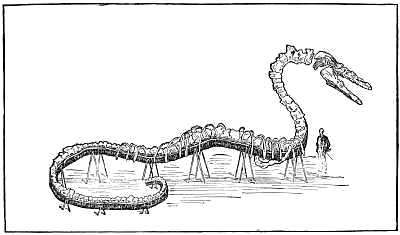
Philodina (swimming).
Another kind of rotifer was abundant—the Philodina,
which belongs to the same family as the common wheel-bearer,
namely, the Philodinæa. The Philodina is a
good deal like the common wheel-bearer, or Rotifer
vulgaris, but is usually of a stouter build, and carries
his eyes in a different place. In the common rotifer
these organs are situated on the proboscis, while those
of the Philodina are lower, and said to be "cervical."
The changes of form in this rotifer are still more
remarkable than in the common wheel-bearer. When
resting it resembles a pear-shaped purse, puckered in at
the mouth. Then it thrusts out its tail-foot, swells its
body to an oval globe, protrudes its feeler, and slightly[80]
exposes a row of cilia. After this two distinct wheels
are everted, and as their cilia whirl and spin, the animal
is swiftly rowed along, until it thinks proper to moor
itself fast by the tail-foot, and employ all its ciliary
power in causing currents to converge towards its
throat. When it pleases it can elongate the body, till
it becomes vermiform, and it walks like the common
rotifer, by curving its back, and bringing its nose and
its tail in contact with the ground.
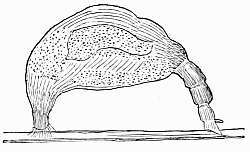
Philodina (crawling).
The gizzard of this family (Philodinæa) presents a
considerable deviation from the perfect form exhibited
by the Brachions. According to Mr. Gosse, "The
mallei and the incus (terms already explained) are
soldered together into two subquadrantic-globular
masses, which appear to be muscular, but invested with
a solid integument. The manubria (handles) may still
be recognised in a vertical aspect as three loops, of
which the central one is chiefly developed, and in a
vertical aspect as a translucent reniform (kidney-shaped)
globe." These descriptions are not easy to understand,[81]
not from any want of clearness or precision in the words
employed, but from the complicated character of the
organ, and its very different appearance under different
aspects. To make the matter more intelligible, Mr.
Gosse adds, "the structure and action of an apparatus
of this type may be made more clear by a homely illustration.
Suppose an apple to be divided longitudinally,
leaving the stalk attached to one half. Let this now
be split again longitudinally so far as the stalk, but not
actually separating either portion from it. Draw the
two portions slightly apart, and lay them down on their
rounded surfaces. They now represent the quadrantic
masses in repose, the stalk being the fulcrum, and the
upper surfaces being crossed by the teeth. By the
contraction of the muscles, of which they are composed,
the two segments are made to turn upon their long axis,
until the points of the teeth are brought into contact,
and the toothed surfaces rise and approach each other.
The lower edges do not, however, separate as the upper
edges approach, but the form of the mass alters, becoming
more lenticular, so that when the toothed surfaces
are brought into their closest approximation, the outline
has a subcircular figure. It is on account of this change
of form that I presume the masses themselves to be
partially composed of muscle."
These remarks, although specially made of the Rotifer
macrurus, are in the main applicable to all the Philodinas,
but the student must not expect to understand
any of the complicated gizzards of the rotifers without
repeated observations, and no small exercise of patience.
It is common to call the portions of the Philodine-pattern[82]
gizzard "stirrup-shaped," but Mr. Gosse has
shown them to be quadrantic, that is, shaped like the
quarter of a sphere.
As we are not very well off with subjects for description
in these two months, we can afford a little time to
consider a question that continually arises in the mind,
on viewing the movements of animalcules, and especially
of any so highly developed as the rotifers, namely, to
what extent motions which appear intelligent are really
the result of anything like a conscious purpose or will.
When any of the lower animals—a bee, for example—acts
in precisely the same way as all bees have acted
since their proceedings have been observed, we settle
the question by the use of the term instinct. Those who
take the lowest view of insect life, assume that the bee
flies because it has wings, but without wishing to use
them, and that the nerves exciting them to action are
in their turn excited, not by volition, but by some
physical stimulus.
The sight or the smell of flowers is thought by the
same reasoners to be capable of attracting the insect,
which is unconscious of the attraction, while proximity
of food stimulates the tongue to make the movements
needful for its acquisition, and so forth. The cells,
they tell us, are built according to a pattern which the
earliest bee was impelled to construct by forces that
bear no analogy to human reason and human will, and
so originate all the ordinary processes of bee life. Sometimes,
however, it happens that man or accident interposes
particular obstacles, and forthwith there appears
a particular modification of the orthodox plan, calculated[83]
to meet the special difficulty. How is this? Does
any one of the difficulties which the bee or the ant is
able to get over, produce precisely that kind of electrical
disturbance, or polar arrangement of nerve particles
that is necessary to stimulate the first step of the action
by which the difficulty is surmounted; and does the
new condition thus established stimulate the second
step, and so forth, or can the bee, within certain limits,
really think, design, and contrive?
No questions are more difficult of solution; but
while protesting against a tendency to undervalue all
life below that of man, we must remember we have in
our bodies processes going on which are not the result
of volition, as when the blood circulates, and its
particles arrange themselves in the pattern required to
form our tissues and organs, and also that many of our
actions belong to the class termed by physiologists,
"reflex," that is, the result of external impressions upon
the nervous system, in which the sentient brain takes no
part. Thus when a strong light stimulates the optic
nerve, the portion of brain with which it is connected
in its turn stimulates the iris to contract the pupil;
and it is supposed that after a man has begun to walk,
through the exercise of his will, he may continue to
walk, by a reflex action; as his feet press the ground
they transmit an impression to the spinal cord, and the
legs receive a fresh impulse to locomotion, although the
mind is completely occupied with other business, and pays
no attention to their proceedings.[14] The ordinary move[84]ments
of insects appear to be of this character, and
to be excited by the ganglia belonging to the
segment to which the moving limbs are attached.
Thus a centipede will run, after its head has been cut
off, and a water-beetle (Dytiscus) swam energetically
when thrown into water after its brain had been
removed.[15]
[14] See Carpenter's 'Manual of Physiology.'
[15] Carpenter's 'Manual of Physiology,' p. 551.
It must not, however, be assumed that the brain of
insects has nothing to do with their movements. It is
probably the means of co-ordinating or directing them
to a common end, and gives rise to what are called
consensual movements, that is, movements which are
accompanied or stimulated by a sensation, although
not controlled by a will. In man these actions are
frequently exhibited, "as when laughter is provoked
by some ludicrous sight or sound, or by the remembrance
of such at an unseasonable hour."[16] Sneezing
is another instance of a sensation leading to certain
motions, without any intervention of the human will.
[16] Ibid., p. 543.
Speaking of these consensual motions, Dr. Carpenter
observes, "It is probable, from the strong manifestations
of emotion, exhibited by many of the lower
animals, that some of the actions which we assemble
under the general designation of instinctive are to be
referred to this group."
The insect brain is composed of a supra-œsophagal
ganglion and infra-œsophagal one. Von Siebold says,
the first corresponds to the cerebrum of the vertebrata,
and "the second is comparable, perhaps, to the cere[85]bellum
or spinal cord."[17] The superior ganglion gives
off nerves to the antennæ and eyes, the lower one to the
mandibles, &c. So far as is known the insects that
exhibit the most intelligence have the largest and best
developed brains.
[17] 'Anatomy of Invertebrates,' Burnett's trans.
A special volume would be required for anything like
a complete examination of the little which is known on
this subject, but these few remarks may assist the
microscopic beginner in examining the movements of
his subjects, and guard against the error of referring to
reason and volition those which are, probably, either the
direct result of stimulants applied to the surface (as in
nerveless creatures), or the indirect (reflex) result of
such stimulants in beings like the rotifers, who have a
nervous system; or the result of sensations, which
excite actions without previously referring the matter
to the decision of a will. It must not, however, be
too readily assumed that the behaviour of creatures
possessing distinct organs is entirely automatic; and
we must not forget that even the best physiologists
know very little concerning the range of functions
which the nervous ganglia of the invertebrata are able
to discharge.
[86]
CHAPTER VIII.
AUGUST.
Mud coloured by worms—Their retreat at alarm—A country duck-pond—Contents
of its scum—Cryptomonads—Their means of
locomotion—A Triarthra (three-limbed Rotifer)—The Brachion or
Pitcher Rotifer—Its striking form—Enormous gizzard—Ciliary
motion inside this creature—Large eye and brain—Powerful tail—Its
functions—Eggs.
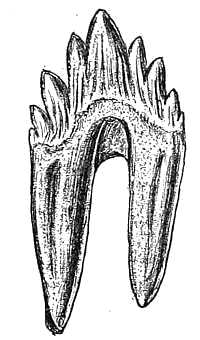
N the beginning of this month a pond in the
Finchley Road, a little beyond the Highgate
Archway, supplied some more specimens of
the Pterodina patina, described in a previous chapter;
but towards the middle of the month a visit to
Chipstead, in Surrey, enabled a new region to be
explored.
It is always a treat to a Londoner to get down to
any of the picturesque parts of Surrey; the trees
exhibit a richness of foliage and variety of colour not
seen within the regions of metropolitan smoke; the
distance glows with the rich purples so much admired
in the pictures of Linnel, and the sunsets light up earth
and sky with the golden tints he is so well able to
reproduce. Probably the warmth of the soil, and the
purity of the air, may make Surrey ponds prolific in[87]
microscopic life; but of this we do not know enough to
make a fair comparison, although our own dips into
them were tolerably lucky.
Walking one day down a lane leading towards
Reigate, where the trees arched overhead, ferns grew
plentifully in the sandy banks, and the sunlight flitted
through the branches, and chequered the path, we came
to a shallow pond, or great puddle, which crossed the
way, and near the edge of the water the eye was struck
with patches of crimson colour. On attempting to
take up a portion of one of these patches the whole
disappeared, although when the disturbance ceased
the rich colour again clothed the dingy mud. The
appearance was caused by thousands of little worms,
belonging to the genus Tubifex, not uncommon in
such situations, who thrust themselves out to enjoy the
light and air, and retreat the moment an alarm is
given. Probably both actions belong to the class
described in the last chapter, as "reflex;" but it would
be interesting to know whether creatures so humble
have any sense of fear. These worms will repay observation,
but in these pages we eschew all their tribe—unless
the rotifers be assigned to them—and take ourselves
once more to our especial subjects.
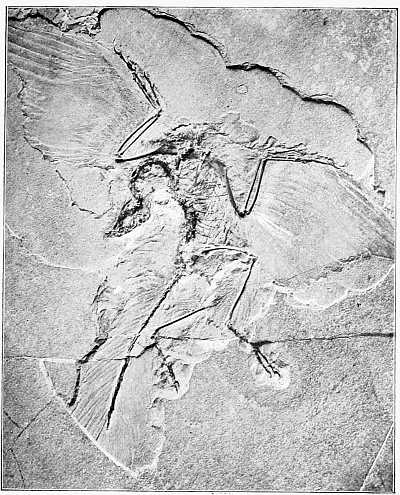
Cryptomonad—Euglena.
Knowing that farm-ponds are usually well stocked
with microscopic game, we made a dip into one more
especially assigned to ducks, and obtained wondrous
little for our pains. We were not, however, discouraged,
but made an examination of the circumstances,
which determined a particular course of action. Our
piece of water was simply a dirty duck-pond, in which
[88]no large plants were growing, and which did not even
exhibit the little disks of duckweed that are common
to such situations. There was, however, on the surface,
in parts, an exceedingly fine scum of pale yellow green,
and this, armed with a teaspoon, we proceeded to
attack. By careful skimming, a small bottle was half-filled
with minute organic particles, which were likely
to be interesting in themselves, and pretty sure to be
the food for something else. A small drop was placed
on a tablet of the live-box, flattened out by the application
of the cover, and viewed with a power of two
hundred linear, which disclosed swarms of brilliant
green globes, amongst which were a good sprinkle of
minute creatures, like the Euglenæ already described,[89]
and whose little red eyes contrasted vividly with the
prevailing emerald hue.
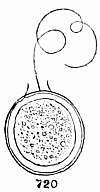
Cryptomonad.
One of the higher infusoria, whose species I could
not identify, was devouring them like a porpoise
among sprats. It did not, however, exhibit any sense
in its hungry career; it moved about in all directions,
gulping down what came in its way, but often permitting
the escape of the little green things that were
almost in its mouth. The little globes rolled and
whirled about without the faintest indication of a
purpose, and without exhibiting any instrument with
which their locomotion was effected. To find out how
this was done, a higher power was used, and from their
extreme minuteness an amplification of seven hundred
and twenty linear was conveniently employed, although
a lower one (three or four hundred) disclosed the secret
by showing that a little whip was flourished about
through the neck, which the lower power revealed.
When highly magnified, each little globe was seen to
consist of an outer case of a reddish orange colour,[90]
which was noticeable on looking at the edges, although
in the centre it was transparent enough to show the
brilliant green contents, that resembled the chlorophyll,
or green colouring matter of plants. From a short
neck proceeded the whip-like filament, which was
lashed and twisted about in all directions. These little
creatures belong to the monad family, but whether they
are to be called Trachelomonads, or by some other hard
name, the learned must decide.
The 'Micrographic Dictionary' puts a note of
interrogation to the assertion of some writers that
Trachelomonads have no necks, and draws some with
such an appendage.
Pritchard's last edition is against necks, and whether
the necks or no necks are to win, is a mighty question
equal at least to the famous controversy, which divided
the world into "big and little endians in the matter
of breaking eggs."
A discussion of more importance is, whether these
Cryptomonads—that name will do whatever comes of
the neck controversy—are animals or vegetables.
Lachmann and Mr. Carter affirm that they have
detected a contractile vesicle, which would assimulate
them to the animal series, but their general behaviour
is vegetable; and the 'Micrographic Dictionary' is in
favour of referring them to the Algæ—that great family
of simple plants, of which the sea-weeds are the most
important representatives.
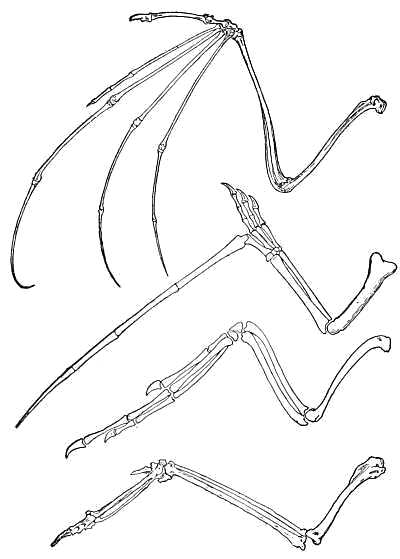
Triarthra.
When any of the monads swarm, there are sure to
be plenty of other creatures to eat them up, and in
this instance the predaceous animalcule, already
[91]described, was not the only enemy the little green
globes had to suffer from, as two sorts of rotifer were
frequently met with. One of these was a very handsome
and singular creature, which in some positions
had the general contour of a cockatoo, only that the
legs were wanting, and the head exhibited a monkey
face. The "wheels" were represented by ciliary tufts,
and two bright red eyes twinkled with a knowing look.
From each shoulder proceeded a long curved spine, and
about two thirds down the body, and lying between
the two long spines, a shorter one was articulated,
which followed the same curve. A gizzard was busy in
the breast, and the body terminated in two short toes,
which grasped a large round egg. Whenever the cilia
were drawn in, the three spines were thrown up; but
they had an independent motion of their own, and
every now and then were jerked suddenly and violently[92]
back, which occasioned a rapid change in the creature's
position. The gizzard appeared to consist of two
rounded masses, having several ridges of teeth, which
worked against each other something like the prominences
of a coffee-mill. From the three spines, this
animal was a Triarthra, or Three-limbed Rotifer, but
the position of the spines, and the toes, made it differ
from any species described in the 'Micrographic
Dictionary,' or in Pritchard.
Whether or not this species is to be regarded as
having a lorica or not, must depend upon the precise
meaning attached to that word. At any rate the
integument was much firmer than in many of the
rotifers, and gave an efficient support to the spines
which a mere skin could not do. As Mr. Gosse
remarks of an allied genus, the Polyarthra, or Many-limbed
Rotifer, this creature could not be investigated
without coming to the conclusion "Here again we have
true jointed limbs;" a fact of great importance in
determining the zoological rank of the family, and in
supporting Mr. Gosse's view some at least bore a strong
affinity with the group of Arthropoda, of which the
insects are the principal representatives.
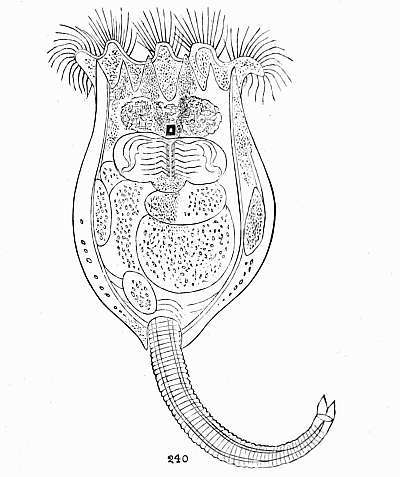
Brachionus urceolaris.
This drawing has been accidentally reversed by the engraver,
which alters the relative place of the internal organs.
Another rotifer of even greater interest, which was
busy among the Cryptomonads, was the Brachion, or
"Pitcher Rotifer" (Brachionus). The members of
this genus will frequently reward the searcher into
pond-life. Their main characteristic is a cup or pitcher-shaped
lorica, which is cut or notched at the top into
several horns or projections, the number of which
indicates the species; while two or more similar
[93]projections ornament the bottom. This lorica is like
the shell of a tortoise open at both ends; from the top
an extremely beautiful wreath of cilia is protruded, and
also some longer and stiff cilia, or slender spines, which
do not exhibit the rotatory movement. The ciliary[94]
apparatus is in reality continuous, but it more often
presents the appearance of several divisions, and the
lateral cilia frequently hang over the sides. From the
large size of each cilium they are very favorable
creatures for exhibiting the real nature of the action,
which gives rise to the rotatory appearance, and which
can be easier studied than described. By movements,
partly from their base, and partly arising from the
flexibility of their structure, the cilia come alternately
in and out of view, and when set in a circular pattern,
the effect is amazingly like the spinning round of a wheel.
The internal arrangements of the Brachiones are finely
displayed, and they have a most aldermanic allowance
of gizzard, which extends more than half way across
each side of the median line, and shows all the portions
described by Mr. Gosse. As the joints of this machine
move, and the teeth are brought together, one could
fancy a sound of mill-work was heard, and the observer
is fully impressed with a sense of mechanical power.
When the creature is obliging enough to present a
full front view, her domestic economy is excellently
displayed. The prey that is caught in her whirlpool is
carried down by a strong ciliary current to the gizzard,
which may be often seen grappling with objects that
appear much too big for its grasp; and Mr. Gosse was
lucky in witnessing an attempt to chew up a morsel
that did actually prove too large and too tough, and
which, after many ineffectual efforts, was suddenly cast
out. As soon as food has passed the gizzard, it is
assisted in its journey by more ciliary currents, which
are noticeable in the capacious stomach, in the neighbourhood[95]
of which the secreting and other vessels are
readily observed. Just over the gizzard blazes a great
red eye, of a square or oblong form, and it reposes
upon a large mass of soft granular-looking brain,
which well justifies Mr. Gosse's epithet "enormous."
Whether this brain is highly organized enough to be a
thinking apparatus, we do not know, but it is evidently
the cause of a very vigorous and consentaneous action
of the various organs the Brachion possesses.
A description of the Brachion would be very incomplete
if it omitted that important organ the tail,
which in this family reaches the highest point of
development. It is a powerful muscular organ, of
great size in proportion to the animal, capable of complete
retraction within the carapace, and of being
everted wholly, or partially, at will. It terminates in
two short conical toes, protruded from a tube-like
sheath, and capable of adhering firmly even to a substance
so slippery as glass. This tail may be observed
to indicate a variety of emotions, if we can ascribe
such feelings to a rotifer, and it answers many purposes.
Now we see it cautiously thrust forth, and turned this
way and that, exploring like an elephant's trunk, and
almost as flexible. Now it seizes firm hold of some
substance, and anchors its proprietor hard and fast. A
few moments afterwards it lashes out right and left
with fury, like the tail of a cat in a passion. Then
again it will be retracted, and a casual observer might
not imagine the Brachion to be furnished with such a
terminal implement.
The Brachiones may often be seen with one or more[96]
large eggs stuck about the upper part of the tail, and
others may be discerned inside. One specimen before
us has three eggs attached to her in this way. They
are large oval bodies, with a firm shell. These
creatures differ very much in appearance, according to
the direction in which they are seen, and a side view
makes them look so different from a full front or back
aspect, that it would be easy to suppose another animal
was under observation. The extent to which the
ciliary apparatus is protruded, and the pattern it forms
likewise differs continually; and hence no drawing,
however correct, is sure to resemble the arrangement
that may be presented to the observer's eye. But
however our little "Pitcher" may be viewed, it is sure
to prove a spectacle of interest and delight.
[97]
CHAPTER IX.
SEPTEMBER.
Microscopic value of little pools—Curious facts in appearance and
disappearance of Animalcules and Rotifers—Mode of preserving
them in a glass jar—Fragments of Melicerta tube—Peculiar shape
of Pellets—Amphileptus—Scaridium Longicaudum—A long-tailed
Rotifer—Stephanoceros Eichornii—A splendid Rotifer—Its gelatinous
bottle—Its crown of tentacles—Retreats on alarm—Illumination
requisite to see its beauties—Its greediness—Richly-coloured
Food—Nervous ganglia.

CATTERED about Hampstead Heath are a
number of little pools, not big enough to be
dignified by the name of ponds. They are
generally surrounded by furze bushes, and would escape
attention if not actually looked for. Those which are
mere puddles, and have only a brief existence in rainy
weather, seldom reward the labour of investigation;
but others are permanent, except after prolonged
drought, and afford convenient situations for the
growth of confervæ, star-weed, and other plants. These
will nearly always repay the microscopic collector
during the winter, when he must break the ice to get
at their contents; in spring, when long chains of frog-spawn
afford ocular evidence of the prolific properties[98]
of the Batrachian reptiles; and in summer, when they
afford both shade and sunshine to their numerous
inhabitants. Small beetles, water-spiders, larvæ of
gnats, and other insects, rotifers, including the tubicolar
sorts, and several varieties of infusoria may be
expected and generally found. There is, however, a
curious fact about ponds, big and little, which Pritchard
remarks upon in his 'Infusoria,' and which
corresponds with our own experience, that those which
have proved to be well stocked with any particular
creature during one year, will very likely contain none
of it in the next. There are of course exceptions to
this rule, but we have often been astonished and disappointed
at finding the complete change, both in
populousness and population, that a revolution of
twelve months will make; and it would be extremely
interesting to notice the changes that took place during
a term of years.
Such researches might unfold some unexpected laws
in the succession of infusorial life. Those germs which
are most widely diffused, will be the most likely to be
developed in any mass of convenient water; but how
and why the rarer forms come and go is very imperfectly
understood. Slight modifications in surrounding
circumstances will materially affect the result. Thus,
if we bring home a handful of conferva, and a few
water-plants of higher organisation, such as duckweed
and anacharis, and place the whole in a glass jar full
of pond-water, we shall at first have a good stock of
objects; but they will usually grow less and less, until
scarcely anything is left. If, however, we introduce a[99]
few pieces of straw, or a tiny wisp of hay, we shall
succeed much better, and not only preserve our population
longer, but enjoy a succession of animated crops.
Extensive decomposition of vegetable matter kills off
all but certain families, such as Paramecia, who enjoy
it; on the other hand, too little decomposition proves
fatal to some creatures, by depriving them of their food,
and when they have died off, those who depended upon
them for a living, die too. Different vegetables in
decomposition suit different creatures, and hay and
straw in that state seem to please the largest number.
An animalcule tank will succeed best when it contains
two or three kinds of growing plants, which oxygenize
the air, and a moderate variety of decomposing organisms
will supply food without making the water
offensive.
From these considerations it will be apparent that
not only the nature of the vegetation of a pond, which
is often changed by accidental circumstances, but also
the quality of the odds and ends that the winds may
blow into it, or which may fall through the air, will do
much to determine the character and number of its
inhabitants, while the quantity of shade or sunshine it
enjoys, will also exercise an important influence. Hay
and other infusions have from the beginning of microscopic
investigations been employed to obtain the
creatures which the Germans call "Infusions thierchen"
(infusion animalcules), and the English "Infusoria;"
but very little has yet been done in the way of
their scientific culture and management.
To return from this digression to our little Hampstead[100]
ponds, we obtained from one, in September, that
was full of star-weed, a number of sugar-loaf bodies,
adhering to one another, and of a pale yellow brown
colour. The specimens first examined looked complete
in themselves, and were taken for eggs of some water
creature. Further search, however, disclosed aggregations
of similar sugar-loaves that had evidently formed
part of a tubular structure, and the idea at once
occurred that they were fragments of a Melicerta tube,
a conclusion that was verified by finding some tubes
entire and a dead Melicerta in the rubbish at the
bottom. All the specimens of Melicerta tubes we had
hitherto examined were composed of rounded pellets,
but these were made of pointed cones or sugar-loaves,
with the points projecting outwards from the general
surface. In Pritchard's 'Infusoria,' these pellets are
described "as small lenticular bodies." The 'Micrographic
Dictionary' states that the tubes of the
Melicerta are composed of "numerous rounded or
discoidal bodies;" and Mr. Gosse, in his 'Tenby,'
which contains an admirable description, and an
exquisite drawing of this interesting rotifer, calls the
pellets "round."
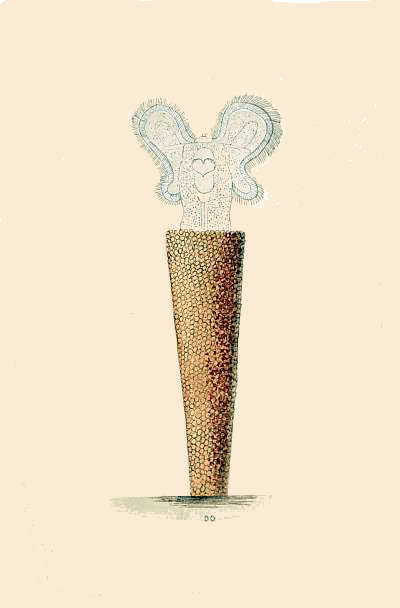
Melicerta ringens.
Not being able to obtain a living specimen of the
Melicerta, who made her tube of long sugar-loaves, I
could not tell whether she differed in structure from
the usual pattern of her race, but the general appearance
of the dead body was the same. It is possible
that these creatures possess some power of modifying
the form of their singular bricks, or they may at
different ages vary the patterns, which matters some
[101]fortunate possessor of a colony of these animals may be
able to verify.
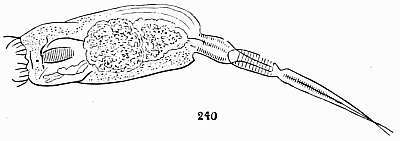
Scaridium longicaudum.
In the sediment of the water containing the Melicerta
cases was found an animalcule about 1—120" long,
covered with cilia, and having a proboscis seldom more
than a quarter of the length assumed by the body,
which continually changed its form, sometimes elongating,
sometimes shortening, and often contracting
one side into a deep fissure. It was, probably, an
Amphileptus, though not precisely agreeing with any
drawing or description I am acquainted with. Another
inmate of the same water was a lively long-tailed rotifer,
with a small oval body, a tuft of vibrating cilia and a
curved bristle visible among them on one side. This
creature had a jointed tail-foot, ending in two long
style-shaped toes, and by means of this appendage
executed rapid leaps or springs. It was the Scaridium
longicaudum, and agreed in dimensions tolerably well
with the size given in the books, namely, total length
1—72". With a power of five hundred diameters the[102]
muscles of the tail-foot presented a beautifully striated
appearance.
Towards the end of the month I passed the Vale of
Heath Pond, Hampstead, and although I had not gone
out for the purpose of collecting, was fortunately
provided with a two-dram bottle. Close by the path the
Anacharis alsinastrum grew in profusion, quantities of
water-snails crawled among its branches, and small fish
darted in and out, threading their mazes with lightning
rapidity. Thrusting a walking-stick among the mass
of vegetation, a few little tufts were drawn up and carefully
bottled, with the addition of a little water.
Returning home, a few leaves were placed in the live-box,
and on examination with the power of sixty diameters
they disclosed a specimen of, perhaps, the most
beautiful of all the rotifers, the Stephanoceros Eichornii.
In this elegant creature an oval body, somewhat expanded
at the top, is supported upon a tapering stalk,
and stands in a gelatinous bottle, composed of irregular
rings superimposed one upon the other, as if thrown off
by successive efforts, the upper ones being inverted and
attached to the body of the animal. But that which
constitutes the glory of this little being is the crown of
five tapering tentacles, each having two rows of long
cilia arranged on opposing sides, but not in the same
plane. The ordinary position of the tentacles is that
of a graceful elliptical curve, first swelling outwards,
then bending inwards, until their points closely approximate,
but each is capable of independent motion, and
they are seldom quiet for many minutes at a time.
The cilia can be arranged in parallel rows or in tufts
[103]at the will of the creature, and their motion appears
under control, and susceptible of greater modification
than is exhibited by the ordinary infusoria.
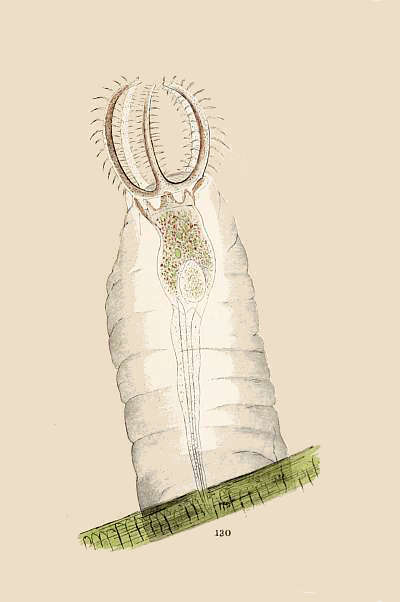
Stephanoceros Eichornii.
The Stephanoceros is a member of the Floscule
family, but in all the specimens I obtained and watched
for several weeks, there was an important difference in
the relation of the tube to the creature. In the Floscules
I had never seen anything like an adhesion
between the tube and the animal, but in the Stephanoceros
I noticed it continually, and always in the manner
already described. Like the Floscule, the Stephanoceros
is readily alarmed, and retreats into her house,
carrying with her the invaginated portion. In the last
edition of 'Pritchard's Infusoria,' this case is spoken of
as apparently not tubular, but a solid gelatinous mass,
enveloping the animal as high up as the base of the
rotatory arms. It is very likely that specimens at
different ages, and possibly in different seasons, may
vary in the structure of their abodes; but I am not
able to concur in the preceding account, as all the
tubes I examined resembled sacks turned in at the
mouths, and attached to the shoulders only of their
inmates; and on one occasion I was able to look down
into a deserted tube, which had not collapsed, as it
would have done if it had been merely a solid gelatinous
mass.
Like the Floscule, the Stephanoceros only reveals
her beauties under careful illumination. A direct light
renders them invisible, and only when the requisite
obliquity has been obtained, does the exquisite character
of the structure become displayed. The dark-ground[104]
illumination is very useful, and makes the
ciliary action very distinct. At times a view can be
obtained, in which the cilia of perhaps a single tentacle
are all ranged like the steel springs of a musical box.
For a moment they are quiescent, and then they vibrate
in succession, each moving thread sparkling in the
light. With a clumsy mode of lighting them, the cilia
look like stumpy bristles, and are often so drawn; but
precisely the right quantity of light coming in the
right direction, makes them appear more numerous,
and much longer than would at first be supposed.
When well exhibited the tentacles have a lustre between
glass and pearl; the body, in a favorable specimen, is
like a crystal cup, and the food, usually composed of
small red and green globes, glows like emeralds and
rubies, as if in the height of luxury the little epicure
had more than rivalled Cleopatra's draught, and instead
of dissolving, swallowed its jewelry whole. So lustrous
and varied in colour is the whole appearance of the
animal under these circumstances, that it is frequently
alluded to by one of our first artists, to whom it was
displayed.
It is said by some authors that the tentacles are used
to seize prey. This never occurred under my observation,
although their basal portions are often approximated
when an object is forced down to the grinding
apparatus below. The Stephanoceros is a ravenous
feeder, and swallows a variety of creatures. Green
vegetable monads, rich red and brown globes of similar
characters, and any animalcule that comes in her way
is acceptable; and even good-sized rotifers do not[105]
escape her all-consuming maw. On one occasion I
noticed one of the loricated sort, more than half as
long as one of her tentacles, rapidly swallowed, and
passed downwards without attempting to escape.
Objects much too big for the gizzard are often gulped
down, and probably receive a preliminary softening and
maceration in the crop. Very often, when food is
plentiful, the creature is filled to the brim, but still
endeavours to continue her abundant meal. From the
presence of large quantities of food and the density of
the integuments, the gizzard cannot always be seen;
but in favorable specimens its teeth may be observed
busily at work.
At the base of the tentacles small masses of matter
may be discovered, which are probably nervous ganglia,
and other organs; and Ehrenberg discovered small
vibrating bodies, supposed to be connected with the
function of respiration. A single egg, as shown in the
annexed drawing, is often found, and the ovarian is said
to develop but few at a time. Two red eyes are found
in young specimens, but in adults they either disappear
or are not conspicuous. The Stephanoceri are sociable
animals, and when one is found, others are probably
near at hand. Several may often be discovered on the
same branch of a small water-plant, of various dimensions,
and in different stages of growth. The full size
is about 1—36" in height, and from its magnitude care
is required not to crush it in the live-box. When
specimens are plentiful, some should be placed in that
convenient receptacle; and others with the plant on
which they are growing, in a glass cell or trough,[106]
where they have more room to display their motions,
and can with fresh supplies of water, be preserved for
days and weeks. With occasional renewals from one
pond, I was able to keep up a stock for about three
months, and never had objects which gave more pleasure
to myself or to my friends.
[107]
CHAPTER X.
OCTOBER.
Stentors and Stephanoceri—Description of Stentors—Mode of viewing
them—Their abundance—Social habits—Solitary Stentors living in
Gelatinous caves—Propagation by divers modes—Cephalosiphon
Limnias—A group of Vaginicolæ—Changes of shape—A bubble-blowing
Vorticella.

CTOBER, the finest of our autumn months, is
noted for usually granting the inhabitants of
our dripping climate about twenty pleasant
sunshiny days, and it is probably on this account somewhat
of a favourite with the infusorial world, although
the cold of its nights and early mornings thins their
numbers, which reach a maximum in the summer heat.
Even in the dismal year 1860, October maintained its
character, and afforded a great many opportunities of
animalcule hunting, during which a constant supply of
Stephanoceri were readily obtained, together with
swarms of Stentors, which are not exceeded in interest
by any of the Ciliated Protozoa. The Stentors were
abundant on the same weed (Anacharis), that formed
the residence of the Stephanoceri, and might be seen
in large numbers hanging from it like green trumpets,
visible to the unassisted eye. In the 'Micrographic[108]
Dictionary' they are said to belong to the Vorticella
family, which has already given us several beautiful
objects, and possess a marvellous power of changing
their shape. It is, however, better to follow Stein, who
separates them from the Vorticellids and ranges them
in his order Heterotricha, as they have two distinct
sets of cilia, small ones covering the body and the
larger ones round the mouth. Those before us are
named after this property Stentor polymorphus,[18] or
Many-shaped Stentors, and owe their exquisite tint to
numberless green vesicles, or small cavities filled with
colouring matter like that of plants. This, however, is
not essential to the species which may often be found
of other hues. In size this Stentor varies from a
hundred and twentieth to one twenty-fourth of an
inch. It is entirely covered with fine cilia, disposed in
longitudinal rows, and round the head is a spiral
wreath of larger and very conspicuous cilia leading to
the mouth.
[18]
See Frontispiece.
Having observed the abundance of these creatures, a
few small branches to which they were appended, were
placed in the glass trough, and viewed with powers of
sixty and one hundred linear. Some had tumbled
down as shapeless lumps, others presented broad
funnel-shaped bodies; while others stretched themselves
to great length like the long, narrow post-horns which
still wake the echoes of a few old-fashioned towns.
The ciliary motion of the elegant wreath was active
and rapid, causing quite a stir among all the little
particles, alive and dead; and when the right sort of
[109]food came near the corkscrew entrance to the mouth,
down it went, and if conspicuous for colour, was
subsequently seen apparently embedded in little
cavities, which Ehrenberg supposed were separate
stomachs, although that theory is now rejected. One
advantage of viewing these objects in a sufficient
quantity of water, to leave them in freedom, is that
they frequently turn themselves, so that you can see
right down into them; and the drawing given in the
frontispiece represents such a view, which is the most
favorable for the exhibition of the mouth. To make[110]
out the details of their structure, to see the nucleus
and other organs, the flattening in the live-box is
useful, and it enables much higher powers to be employed.
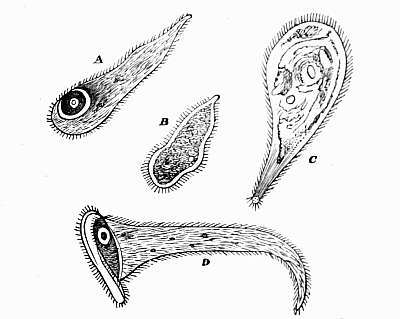
A, B, C, D, Stentor polymorphus in different degrees of expansion.
A large specimen is one twenty-fourth of an inch
long.
After leaving the Anacharis in a glass jar for a few
days, the Stentors multiplied exceedingly; some clung
to the sides of the vessel in sociable communities,
others hung from the surface of the water, and crowds
settled upon the stems, visibly changing their tint, as
the Stentor green was much bluer than that of the
plant. Scores swam about in all sorts of forms. Now
they looked like cylindrical vessels with expanding
brims, now globular, now oddly distorted, until all
semblance of the original shape was lost. Many were
found in shiny tubes, but these were never so lively or
green as the free swimmers, but mostly of a dingy
dirty hue.
These housekeepers were more timid and cautious
than the roving tribe. They came slowly out of their
dens, drew back at the slightest alarm, never took their
tails from home, and only extended their full length
when certain not to be disturbed. Some authors have
thought they only take to private lodgings when they
feel a little bit poorly, but others dispute this opinion,
and I do not think it is correct. I have found these
Stentors at all seasons, from January to the autumn,
but they are never so numerous, nor aggregated in
numbers like the roving sort. Whether they are old
folks, who are tired of the world and its gaieties, and
devote the remainder of their lives to contemplation, or
whether they are bachelors disappointed in love, I am[111]
unable to say; but they are very inferior in beauty to
the "gay and glittering crowd."[19]
[19] Stein says the colourless variety of S. Polymorphus is sometimes
found with a tube, and the S. Rössellii very frequently so provided.
For some weeks my Stentors abounded, and then
most of them suddenly disappeared. They could not
have "moved," but probably "went to smash" by a
process peculiar to infusoria, and which Dujardin
politely describes as "diffluence." This mode of
making an exit from the stage of life is more tragical
than the ripping up so fashionable in Japan. The
integument bursts, and its contents disperse in minute
particles, that in their turn disappear, and scarcely
leave a "wrack behind."
The Stentors obey the injunction to "increase and
multiply" by self-division, which Stein says is always
oblique, and the nucleus, which plays such an important
part in infusoria, is band-like, moniliform (bead-shape),
or round. When an animalcule increases by
self-division, a portion of the nucleus goes with each
part, and it is probably the organ which stimulates the
change. It is also concerned in other modes of propagation.
"The anus is situated on the back close
beneath the ciliary circle;" and the "contractile vesicle
on a level with the ciliary wreath." Stein records that
in November, 1858, he met green Stentors (Polymorphus)
encysted, and he figures one in a gelatinous
flask having a stopper in its narrow neck.
Before closing our account of the Stentor, let us
revert a moment to the ciliary wreath, as it may be
made the subject of a curious experiment. If, for
[112]example, the cilia are viewed at right-angles to their
length, they will seem to form a delicate frill, in which
a quivering motion is perceived. But if the table is
shaken by a sharp blow, the frill is thrown into waves,
or takes the form which washerwomen give to certain
female articles by the use of the Italian iron, and the
ciliary motion is thus made to take place in different
planes, and rendered strikingly apparent.
One day turning over the Anacharis in search of
subjects, a small brown tube was noticed, from which
a glassy rod protruded like the feeler of a rotifer.
Keeping the table quiet, and watching the result, was
soon rewarded by a further protrusion of the feeler,
accompanied by a portion of the body of the inmate of
the tube. The feeler was thrust on this side and on
that, as if collecting information for its proprietor, who,
I suppose, was satisfied with the intelligence, and
gradually extended herself, until she stood out two
thirds in length beyond the tube, and set two lobes of
one nearly continuous ciliary organ in rapid motion.
Sometimes the creature, Cephalosiphon limnias, bent
its neck, if I may so speak, to the right, and sometimes
to the left, and sometimes stood upright, when the
true form of the ciliary apparatus could be seen. The
tube of this creature was opaque, from the adhesion of
foreign matter, and presented an untidy appearance,
strangely contrasting with the clear, neat bottles of the
Floscules. These Cephalosiphons are very whimsical
in their ways, and many that were sent to different
observers never exhibited their ciliary wreaths, but
performed sundry antics, disguising their true shape.[113]

Cephalosiphon limnias.
Somewhat like the Cephalosiphon, though much
commoner and without the siphon, is Limnias ceratophylli,
which every collector is sure to meet. The
length of the Limnias varies, according to Pritchard,
from 1—20" to 1—40". Our Cephalosiphon, when fully
extended and magnified one hundred and eighty linear,[114]
looked about three inches and a half long, and was
therefore very small. Just below the ciliary lobes the
gizzard was seen, with its toothed hammers working one
against the other. The masticatory organ differs from
the typical form, as represented in the Brachion; and Mr.
Gosse observes of Limnias that "each uncus forms, with
its ramus, a well-defined mass of muscle enclosing the
solid parts, and in form approaching the quadrature of
a globe. Across the upper surface of the mass the
uncus is stretched like three long parallel fingers,
arched in their common direction, and imbedded in the
muscular substances, their points just reaching the
opposing face of the ramus, and meeting the points of
the opposite uncus when closed."[20]
[20] The terms uncus, ramus, etc., have been explained in Chapter II,
page 28.
There is no connection between Limnias or Cephalosiphon
and their tubes, except that of simple adhesion,
which takes place by means of the end of their foot-stalks.
In a former chapter we have described an interesting
relation of the Vorticella, the Cothurnia, whose elegant
crystal vases form a very artistic abode, characterised
by possessing a distinct foot. Other species of the
same family inhabit vases which have no foot or stalk,
or live in gelatinous sheaths less accurately fashioned.
Sometimes these creatures are obliging enough to
conform to the specific descriptions which eminent
naturalists have given of them, and also to the characters
which the authorities have assigned to the
different genera in which they have been grouped, but
[115]the microscopist will often meet with difficulties in the
way of classification.
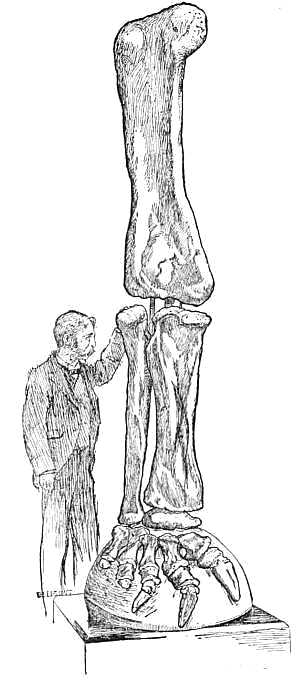
Vaginicola (?) (A, elongated; B, retracted.)
Attached to a piece of weed were a number of cylindrical
masses of brownish jelly, with rounded tops, and
situated in an irregular and very transparent sheath,
about twice as high as themselves. Presently they all
rose up to four times their previous height, put forth a
beautiful crown of vibrating cilia, and opened a sort of
trap-door to their internal arrangements. In this
position they had a long cylindrical form, gracefully
curved, but of nearly equal width from the mouth to
the base, and they readily imbibed particles of carmine,
which tinged sundry little cavities with its characteristic
hue. The slightest disturbance caused the ciliary[116]
wreaths to be drawn in, and the bodies to be retracted,
and descend into their house like a conjuring toy, until
the appearance first described was reproduced.
The general form and structure of these objects was
like the drawings usually given of Vaginicola, which is
said not to exist in groups, although two individuals
are commonly found in one well-shaped cell. These
creatures, however, did not taper towards the base as
Vaginicolæ generally do, and perhaps they became
aware of this defect in their figures, for after a day or
two a change appeared, and they assumed a more
graceful form by swelling out in the middle, and then
growing slender down to the bottom, very much like
the pattern given by glass-blowers to little vases of
flowers.
It is very important to note the changing appearance
of animalcules, and where the same individuals can be
observed from day to day, these will often be found
considerable. It is probable that when such particulars
are fully known, the number of species will be greatly
reduced, and the study of these organisms considerably
simplified. I have called the animals just described
Vaginicolæ, but the reader must be prepared to find
similar bodies, inhabiting well-formed vases, either
solitarily or in couples, the latter condition arising
from the fission of one individual without a corresponding
division of the abode.
For a few weeks I continually met with groups living
as I have described, in what may be called amorphous
cells, which were often so nearly like the surrounding
water in refracting power, as to be discerned with some[117]
difficulty. No trace could be seen of divisions into
separate cells, but they all appeared to live happily
together in one room, and if one went up all went
up, and if one went down all went down, as if their
proceedings were regulated by a community of sensation
or will.
Another little curiosity was a transparent cup upon a
slender stem, which stood upright like a wineglass,
and supported on its mouth a transparent globe. By
removing a leaf which prevented the stalk being traced
to its termination, it was found to be a Vorticella, and
after two hours the globe was partially drawn in, and
reduced in size. Why the creature was engaged in
blowing this bubble I do not know, and have not met
with another instance of such conduct.
[118]
CHAPTER XI.
NOVEMBER.
Characteristics of the Polyzoa—Details of structure according to
Allman—Plumatella repens—Its great beauty under proper illumination—Its
tentacles and their cilia—The mouth and its guard
or epistome—Intestinal tube—How it swallowed a Rotifer, and
what happened—Curiosities of digestion—Are the tentacles capable
of Stinging?—Resting Eggs, or "Statoblasts"—Tube of Plumatella—Its
muscular Fibres—Physiological importance of their
structure.

URING the fag end of last month I observed
some fragments of a new creature among
some bits of Anacharis, from the Vale of
Heath Pond, and searched for complete and intelligible
specimens without effect. Luckily one evening a
scientific neighbour, to whom I had given some of the
plant for the sake of the beautiful Stephanoceri which
inhabited it, came in with a glass trough containing a
little branch, to which adhered a dirty parchment-like
ramifying tube, dotted here and there with brown oval
masses, and having sundry open extremities, from
which some polyp-shaped animals put forth long pearly
tentacles margined with vibrating cilia, and making
a lively current. The creatures presented an organization
higher than that of polyps, for there was an
[119]evident differentiation and complication of parts. They
belonged to the Polyzoa or Bryozoa,[21] a very important
division of the mollusca. The Polyzoa are chiefly
marine, and the common "sea-mat," often erroneously
treated as a sea-weed, is a well-known form. A species
of another order often picked up on our coasts is the
Sertularia, or Sea-Fir, composed of delicate branching
stems of a horny-looking substance, which, under a
pocket-lens, is found to contain an immense number of
small cells inhabited by Polyps. It is instructive to
compare the two and note how much more advanced in
structure is the Polyzoon than the polyp.
[21] Polyzoa means "many animals," in allusion to their habit of living
in association. Bryozoa, "moss-animals," from some forming cells
having that appearance.
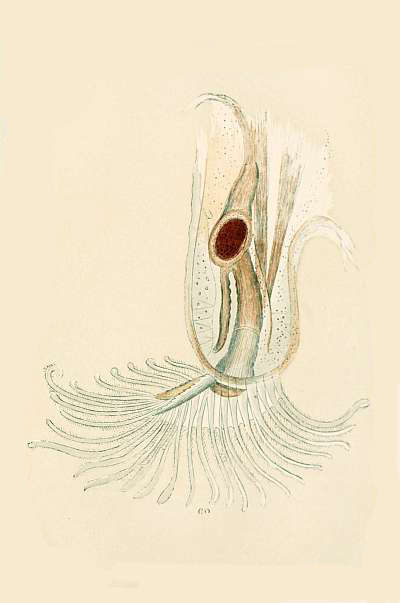
Plumatella repens. Single Polypide enlarged
Polyzoa were formerly associated with the polyps, to
which they bear a strong superficial resemblance; but
they are of a much higher degree of organization, as
will be seen by comparing what has been said in a
former chapter on the Hydra, with the description
which we now proceed to abridge from Dr. Allman's
splendid monograph on the fresh-water kinds. In
order to get a general conception of a Polyzoon, the
Professor tells us to imagine an alimentary canal,
consisting of œsophagus, stomach, and intestine, to be
furnished at its origin with long ciliated tentacles, and
to have a single nervous ganglion on one side of the
œsophagus. We must then conceive the intestine bent
back till its anal orifice comes near the mouth; and
this curved digestive tube to be suspended in a bag
containing fluid, and having two openings, one for the
[120]mouth and the other for the vent. A system of
muscles enables the alimentary tube to be retracted or
protruded, the former process pulling the bag in, and
the latter letting it out. The mouth of the bag is, so
to speak, tied round the creature's neck just below the
tentacles, which are the only portions of it that are
left free. The investing sack has in nearly every case
the power of secreting an external sheath, more or less
solid, and which branches forming numerous cells, in
which the members of the family live in a socialistic
community, having, as it were, two lives, one individual,
and the other shared in common with the rest.
The whole group of tubes and cells, whatever may be
the form in which they are aggregated, is called the
Polypary, or, as Dr. Allman prefers, the Cœnœcium
(common house); the creature he names a Polypide[22]
(polyp-like); and the disk which bears the tentacles
Lophophore (crest-bearer). There are some more hard
words to be learnt before the student can enjoy himself
scientifically among the Polyzoa, and we shall be
compelled to employ some of them before we have
done; but will now endeavour to describe what was
presented to our view by the specimen obtained from
the Hampstead Pond.
[22] Polyzoon is preferable, as avoiding confusion with polypite, used
for another class of object.
The general aspect of a branch of Plumatella repens—the
creature we have to describe—is given in the
drawing annexed. When all was quiet, the mouths of
the bags belonging to each cell were slowly everted,
and out came a numerous bundle of tentacles, which
[121]were either spread like the corolla of a flower, or
permitted to hang dishevelled like the snake-locks of
Medusa. We will suppose these organs symmetrically
expanded, and that we are looking down upon them
with a magnifying power of sixty diameters, the light
having been carefully adjusted by turning the reflecting
mirror a little on one side, to avoid a direct glare.
The tentacles, each of which curves with a living grace,
and displays an opaline tint in its glassy structure, do
not form a complete circle, for at one place we discern
two slightly diverging arms of the disk, or frame
(Lophophore) from which they grow.
These arms support tentacles on each side, and leave
a gap between, so that the whole pattern is crescentic,
or crescent-shaped, and not circular. Extending as far
as the points of the arms, and carried all round the
crescent, is an extremely delicate membrane, like the
finest gauze, which unites all the tentacles by their
basal portions, and makes an elegant retreating curve
between every two. Each tentacle exhibits two rows
of cilia, which scintillate as their vibrations cause them
to catch the light. The motion of the cilia is invariably
down one side and up the other, the current
or pattern being carried on from one tentacle to the
other, all through the series. This characteristic, and
the facility with which each cilium can be distinguished,
gives great interest and beauty to the spectacle
of this wonderful apparatus, by which water-currents
are made to bathe the tentacles, and assist
respiration, and also to carry food towards the mouth,
over which a sort of finger or tongue is stretched to[122]
guard the way, and exercise some choice as to what
particles shall be permitted to pass on. This organ is
called the epistome, from two Greek words, signifying
"upon the mouth."
If the cell is an old one, it may be covered with so
much extraneous matter as to obscure the economy
within; but we are fortunate in having a transparent
specimen before us, through which we can see all that
goes on. The alimentary tube, after forming a capacious
cavity, much longer than it is broad, turns round and
terminates in an orifice near the mouth, and just below
the integuments. When refuse has to be discharged,
this orifice is protruded; and after the operation is
over, it draws back as before. Long muscles, composed
of separate threads or fibres, pull the creature in and out
of its cell, and at the part where the stomach ends, and
the intestine turns round, is attached a long flexible
rope, called the funiculus, which goes to the bottom of
the cell. The passage of the food down to the stomach,
its digestion, and the eviction of the residue, can all be
watched; and when a large morsel is swallowed, the
spectacle is curious in the extreme.
One day a polyzoon caught a large rotifer, (R. vulgaris,)
which, with several others of its tribe, had been
walking over the cœnœcium, and swimming amongst
the tentacles, as if unconscious of danger. All of a
sudden it went down the whirlpool leading to the mouth,
was rolled up by a process that could not be traced,
and without an instant's loss of time, was seen shooting
down in rapid descent to the gulf below, where it looked
a potato-shaped mass, utterly destitute of its characteristic[123]
living form. Having been made into a bolus,
the unhappy rotifer, who never gave the faintest sign of
vitality, was tossed up and down from the top to the
bottom of the stomach, just as a billiard-ball might be
thrown from the top to the bottom of a stocking.
This process went on for hours, the ball gradually
diminishing in size, until at last it was lost in the
general brown mass with which the stomach was filled.
The bottom of the stomach seems well supplied with
muscular fibres, to cause the constrictions by which
this work is chiefly performed, and by keeping a colony
for a month or two, I had many opportunities of seeing
my Polyzoa at their meals.
When alarmed the tentacles were quickly retracted,
but although these creatures are said to dislike the light,
and usually keep away from it in their native haunts,
my specimens had no objection to come out in a strong
illumination, and seemed perfectly at their ease. They
were indeed most amiable creatures, and never failed to
display their charms to admiring visitors, who rewarded
them with unmeasured praise. Twice I had an opportunity
of observing an action I cannot explain, except
by supposing either that the tentacles of the Plumatella
have some poisonous action, or that rotifers are
susceptible of fear. On these occasions the common
rotifer was the subject of the experiment. First one
and then another got among the tentacles, and on
escaping seemed very poorly. One fellow was, to borrow
a phrase from Professor Thomas Sayers, "completely
doubled up," and two or three seconds—long periods in
a rotifer's life—elapsed before he came to himself again.[124]
By keeping a colony of the Plumatella for a few weeks
in a glass trough, and occasionally supplying them with
fresh water from an aquarium, containing the animalcules,
they are easily preserved in good health, and as
they develop fresh cells, the process of growth may be
readily watched. This production of fresh individuals
enlarges the parent colony, but could not be the means
of founding a new one, which is accomplished by two
other modes. A little way down the cells Professor
Allman discovered an ovary attached to the internal
tube by a short peduncle, or foot stalk, while a testis or
male generative organ is attached to the funiculus, or
"little rope," we have already described.
July and August are the best times for observing the
ovaries, and they are most conspicuous in the genera
Alcyonella and Paludicella. True eggs are developed in
the ovaries in a manner resembling this mode of multiplication
in other animals; but there is another kind
of egg, or, perhaps to speak more properly, a variety of
bud, which is extremely curious. In looking at our
specimens we noticed brown oval bodies in the cells;
these, on careful examination, presented the appearance
of the sketch. The centre is dark, covered with a network,
which is more conspicuous in the lighter coloured
and more transparent margins. These curious bodies
are produced from the funiculus, and act as reserves of
propagative force, as they are not hatched or developed
until they get out and find themselves exposed to appropriate
circumstances. Professor Allman names
them Statoblasts, or stationary germs, and they bear
some resemblance to what are called the "winter eggs"
[125]of some other creatures. The Professor was never able
to discover any mode by which they were permitted to
escape from the cells, and in our colonies none were
allowed to leave their homes until the death of their
parent, and the decomposition of its cell had taken
place; a process which went on contemporaneously with
the growth of new cells, until the plant on which the
cœnœcium was situated, rotted away, and then unfortunately
the whole concern went to pieces.
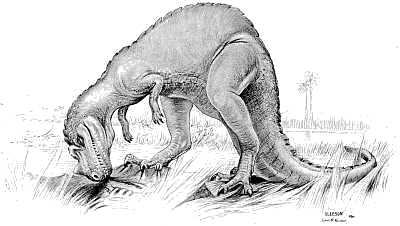
Plumatella repens on a leaf.
The tubes of the Plumatella, and of most other Polyzoa,
are composed of two coats, called respectively
endocyst and ectocyst, that is, "inner case" and "outer
case." The first is vitally endowed, and exhibits vessels
and muscular fibres. The second or outer case is
thrown off by the first. It is a parchment-like substance,
strengthened by the adhesion of dirt particles, and does
not appear to exercise any vital functions, but to be
merely a covering for protection. The inner layer
terminates in the neck of the bag before described, as
exserted when the polypide comes out, and inverted
when it goes in. This mode of making a case or sheath
by inversion of a bag is technically called invagination,
and is readily seen in new and transparent cells.
The movement of eversion, or coming out, is chiefly
produced by the contraction of the endocyst; while the
inversion, or getting in again, is performed by the long
muscles, which, when the animal is extended, are seen
attached to it like ropes. Upon these muscles Professor
Allman remarks that they are "especially interesting
in a physiological point of view, as they seem
to present us with an example of true muscular tissue,[126]
reduced to its simplest and essential form. A muscle
may here be viewed as a beautiful dissection far surpassing
the most refined preparation of the dissecting
needle, for it is composed of a bundle of elementary
fibres, totally separate from one another through their
entire course." He further adds, "The fibres of the
great retractor muscle are distinctly marked by transverse
striæ;—a condition, however, which is not at all
times equally perceptible, and some of our best observers
have denied to the Polyzoon the existence of
striated fibre."
We can confirm the fact of this sort of fibre being
present, but we fancy a reader not versed in the
mysteries of physiology exclaiming, 'What does it
matter whether his fibres are striped or not?'
Physiologists used to suppose there was a strong and
marked distinction and separation between striped
muscles, that is, muscles the fibres of which exhibit
transverse stripes when magnified, and those which do
not. Kölliker, however, says this decided separation
can no longer be maintained,[23] and he gives instances
in proof of the connections that can be traced between
the two forms. In the higher animals the striped
muscles are the special instruments of will, and of movements
that follow, or are accompanied by, distinct sensations.
Striped fibre must be regarded as the highest
form; and as a muscle of this sort contracts in length
it increases uniformly in breadth.
[23] 'Manual of Human Microscopic Anatomy,' p. 63.
There are many other genera and species of fresh-water
polyzoa besides the Plumatella repens, and they
[127]are found attached to sticks, stones, or leaves, generally
to the under surface of the latter. They are all objects
of great interest and beauty, which, whatever their diversity,
conform sufficiently to one type that the student
who has observed one, will easily recognise the zoological
position of another. They should be viewed by transmitted
and by dark-ground illumination, which produces
very beautiful effects. To observe them in the performance
of their functions, they require more room than
the live-box can afford, but are well shown in the glass
trough, whose moveable diaphragm enables them to be
brought near enough to the object-glass, for the use of
a power of about sixty linear for general purposes, and
of from one to two hundred for the examination of
particular parts. For a more detailed examination
dissection must be employed, but all that we have mentioned
can be seen without injury to the living animal,
if specimens are kept till new cells are formed in water,
which does not contain enough dirt to render their integuments
opaque.
[128]
CHAPTER XII.
DECEMBER.
Microscopic Hunting in Winter—Water-bears, or Tardigrada—Their
comical behaviour—Mode of viewing them—Singular gizzard—A
compressorium—Achromatic condenser—Mouth of the
Water-bear—Water-bears' exposure to heat—Soluble
albumen—Physiological and chemical reasons why they are not killed by
heating and drying—The Trachelius ovum—Mode of swimming—Method
of viewing—By dark-ground illumination—Curious digestive
tube with branches—Multiplication by division—Change of
form immediately following this process—Subsequent appearances.
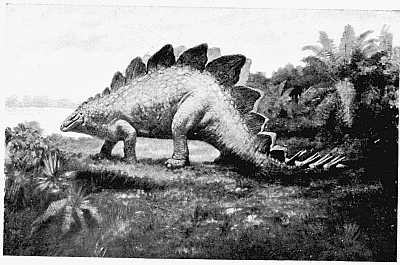
HERE is always satisfaction in finding a work
accomplished; but the attempt to delineate
some of the marvels of minute creation has
been a pleasant one, and we approach the completion of
our task of recording a Microscopic Year with something
like regret. The dark, dirty December of the
great metropolis may not seem a promising time for
field excursions, but some ponds lie near enough to
practicable roads and paths to render an occasional dip
in them, not of ourselves, but of our bottles—an
easy and not unpleasant performance; and if the
weather is unusually bad, we can fall back upon our
preserves in bottles and tanks, which seldom fail to
afford something new, as we have been pretty sure to
bring home some undeveloped germs with our stock of[129]
pond-water and plants, and even creatures of considerable
size are very likely to have escaped detection
in our first efforts at examination.
When objects are not over abundant, as is apt to be
the case in the cold months, it is well to fill a large vial
with some water out of the aquarium or other large
vessel, and watch what living specks may be moving
about therein. These are readily examined with a
pocket-lens, and with a little dexterity any promising
creature can be fished out with the dipping-tube. It is
also advisable to shake a mass of vegetation in a white
basin, as the larger infusoria, &c., may be thrown
down; and indeed this method (as recommended by
Pritchard) is always convenient. Even so small a
quantity of water as is contained in a glass cell, appropriated
to the continual examination of polyps or
polyzoa, should be frequently hunted over with a low
power, as in the course of days and weeks one race of
small animals will disappear, and another take their
place.
Following these various methods in December, we
obtained many specimens; but the most interesting was
found by taking up small branches of the Anacharis
with a pair of forceps, and putting them into a glass
trough to see what inhabitants they might possess.
One of these trials was rewarded by the appearance of
a little puppy-shaped animal very busy pawing about
with eight imperfect legs, but not making much progress
with all his efforts. It was evident that we had
obtained one of the Tardigrada (slow-steppers), or
Water-Bears, and a very comical amusing little fellow[130]
he was. The figure was like that of a new-born puppy,
or "unlicked" bear cub; each of the eight legs were
provided with four serviceable claws, there was no
tail, and the blunt head was susceptible of considerable
alteration of shape. He was grubbing about among
some bits of decayed vegetation, and from the mass of
green matter in his stomach, it was evident that he was
not one of that painfully numerous class in England—the
starving poor.
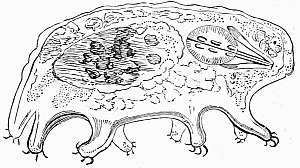
Water-Bear.
A power of one hundred and five linear, obtained
with a two-thirds object-glass, and the second eye-piece,
enabled all his motions and general structure to be exhibited,
and showed that he possessed a sort of gizzard,
whose details would require more magnification to bring
out. Accordingly the dipping-tube was carefully held
just over him, the finger removed, and luckily in went
the little gentleman with the ascending current. He
was cautiously transferred to a Compressorium,[24] an
[131]apparatus by which the approach of two thin plates
of glass can be regulated by the action of a spring and
a screw; and just enough pressure was employed to
keep him from changing his place, although he was
able to move his tiny limbs. Thus arranged, he
was placed under a power of two hundred and forty
linear, and illuminated by an achromatic condenser,[25] to
make the fine structure of his gizzard as plain as possible.
It was then seen that this curious organ contains
several prominences or teeth, and is composed of muscular
fibres, radiating in every direction. From the
front of the gizzard proceed two rods, which meet in a
point, and are supposed to represent the maxillæ or
jaws of insects, while between them is a tube or channel,
through which the food is passed. The mouth is
suctorial, and the two horny rods, with their central
piece or pieces, are protrusile. They were frequently
brought as far as the outer lips (if we may so call the
margins of the mouth), but we did not witness an actual
protrusion, except when the lips accompanied them,
and formed a small round pouting orifice. The skin of
the animal was tough and somewhat loose, and wrinkled
during the contractions its proprietor made. The interior
of the body exhibited an immense multitude of
globular particles of various sizes in constant motion,
but not moving in any vessels, or performing a distinct
circulation.
[24] The best forms of this instrument are made by Messrs. R. & J.
Beck, the glass plates being held in their places by flat-headed screws,
and not by cement. This plan was devised by the author, and makes
it easy to renew the glasses when broken.
[25] The achromatic condenser is a frame capable of supporting an
object-glass, lower than that employed for vision, through which the
light passes to the object in quantities and directions determined by
stops of various shapes. The appearances mentioned can be seen
without it, though not so well.
[132]
My specimens had no visible eyes, and these organs
are, according to Pritchard's book, "variable and fugacious."
The same authority remarks, "In most vital
phenomena they very closely accord with the rotatoria;
thus like these they can be revived after being put into
hot water at 113° to 118°, but are destroyed by immersion
in boiling water. They may be gradually heated
to 216°, 252°, and even 261°. It is also by their capability
of resuscitation after being dried that they are
able to sustain their vitality in such localities as the
roofs of houses, where at one time they are subjected to
great heat and excessive drought, and at another are
immersed in water."
When vital processes are not stopped by excess of
temperature, as is the case with the higher animals, the
power of resisting heat without destruction depends
upon the condition of the albumen. Soluble albumen,
or, as it should be called, Albuminate of Soda (for a
small quantity of that alkali is present and chemically
united with it), after having been thoroughly dried, may
be heated without loss of its solubility; although if the
same temperature was applied before it was dry, that
solubility would be destroyed, and it would no longer
be a fit constituent of a living creature. As Dr. Carpenter
observes, this fact is of much interest in explaining
the tenacity of life in the Tardigrada.
The movements of the water-bears, although slow,
evince a decided purpose and ability to make all parts
work together for one common object; and as might
be expected from this fact, and also from the
repetition of distinct, although not articulated limbs,[133]
they are provided with a nervous apparatus of considerable
development, in the shape of a chain of a
ganglia and a brain, with connecting filaments. From
these and other circumstances naturalists consider the
Tardigrada to belong to the great family of Spiders,
of which they are, physiologically speaking, poor
relations. Siebold says "they form the transition
from the Arachnoidæ to the Annelides."[26] Like
the spiders they cast their skin; and, although I
was not fortunate enough to witness this operation—called
in the language of the learned ecdysis, which
means putting its clothes off—I found an empty hide,
which, making allowance for the comparative size of
the creatures, looked tough and strong as that of a
rhinoceros, and showed that the stripping process extended
to the tips of the claws. The 'Micrographic
Dictionary' states that the Tardigrada lay but few eggs
at a time, and these are "usually deposited during the
ecdysis, the exuviæ serving as a protection to them
during the process of hatching." Thus Mrs. Water-Bear
makes a nursery out of her old skin, a device as
ingenious as unexpected. The water-bears are said to
be hermaphrodites, but this is improbable.
[26] 'Anatomy of the Invertebrata,' Burnett's trans., p. 364.
The Plumatella repens, described in a former chapter,
was kept in a glass trough, to which some fresh water
was added every few days, taken from a glass jar that had
been standing many weeks with growing anacharis in it.
One day a singular creature made its appearance in the
trough; when magnified sixty diameters it resembled
an oval bladder, with a sort of proboscis attached to it.
[134]At one part it was longitudinally constricted, and
evidently possessed some branched and complicated
internal vessel. The surface was ciliated, and the neck
or proboscis acted as a rudder, and enabled the creature
to execute rapid turns. It swam up and down, and
round about, sometimes rotating on its axis, at others
keeping the same side uppermost, but did not exhibit
the faintest sign of intelligence in its movements, except
an occasional finger-like bend of the proboscis,
upon which the cilia seemed thicker than upon the
body. It was big enough to be observed as a moving
white speck by the naked eye, when the vessel containing
it was held to catch the light slantingly; but a
power of one hundred and five was conveniently employed
to enable its structure to be discerned. Under
this power, when the animal was resting or moving
slowly, a mouth was perceived on the left side of the
proboscis, which was usually, though not always, curved
to the right. The mouth was a round or oval orifice,
and when illuminated by the parabola, its lips or
margin looked thickened, and of a pale blue, and
ciliated, while the rest of the body assumed a pinkish
pearly tint.
Below the mouth came a funnel-shaped tube or
œsophagus, having some folds or plaits on its sides, and
terminating in a broad digestive tube, distinct from the
nucleus, and ramifying like a tree. The constriction
before mentioned, which was always seen in certain
positions, although it varied very considerably in depth
and width, drew up the integument towards the main
trunk of the digestive tube, and thus the animal had a[135]
distinct ventral and dorsal side. The branches of the
tube stopped somewhat abruptly just before reaching
the surface, and were often observed to end in small
round vacuoles or vesicles.
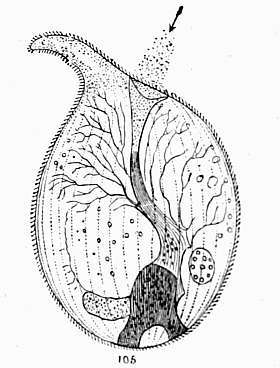
Trachelius ovum (slightly flattened).
At the bottom of the bladder, opposite the mouth, in
some specimens were large round cavities or cells, filled
with smaller cells, or partially transparent granules.
These varied in number from one to two or three, and
were replaced in other specimens by masses that did
not present the same regular form or rounded outline.
In one instance an amorphous structure of this kind
gradually divided itself, and seemed in the course of
forming two cells, but the end of the process was unfortunately
not seen. The annexed drawing will readily
enable the animal to be recognised. It shows the mouth
very plainly, and a current of small particles moving[136]
towards it. The œsophagus terminates in a digestive
tube, like the trunk of a tree, from which numerous
branches spring. This arrangement is probably analogous
to that of the phlebenterous mollusks described by
Quatrefages, in which the ramifications of the stomach
answer the purpose of arteries, and convey the nutrient
fluid to various parts of the body. It is also likely
that they minister to the function of respiration.
The cilia on the surface, which are arranged in
parallel lines, are best observed when the animal is
slightly flattened in a live-box; but this process produces
a considerable derangement in the relative position
of the internal parts, and they can only be well seen
when it is immersed in plenty of water, and is polite
enough to stand still, and submit his digestive economy
to a steady gaze. The only way to succeed in this
undertaking is to have a large stock of patience as well
as a convenient cell or trough. The table must be kept
steady, and the prisoner watched from time to time,
and at last he will be found ready for display.
Pritchard says this animal, whose name is Trachelius
ovum, is an inhabitant of stagnant bog water, and has
been found encysted. My specimens could not be
called plentiful, but for several weeks I could generally
find two or three, by filling a four-ounce vial from the
glass jar, and examining its contents with a pocket-lens.
If none were present, another dip was made, and usually
with success.
One evening I caught a good specimen by means of
the dipping-tube, and cautiously let it out, accompanied
by a drop of water, on the glass floor of the live-box.[137]
A glance with the pocket-lens showed all was right, and
the cover was very gently put on, but it had scarcely
touched the creature when it became crumpled up and
in confusion. On one or two former occasions I had
been unfortunate enough to give my captives a squeeze
too much, with the usual result of a rupture of their
integuments and an escape of globules and fluids from
the regions within. Now, however, there was no such
rupture and no such escape, but instead of a smooth,
comely surface, my Trachelius had lost all title to his
specific designation, ovum, for instead of bearing any
resemblance to an egg, it was more like an Irishman's
hat after having a bit of a "shindy" at Donnybrook
Fair.
I was greatly puzzled with this aspect of things, and
still more so when my deranged specimen twirled and
bumped about with considerable velocity, and in all
directions. Presently a decided constriction appeared
about half-way below the mouth and proboscis, and in
transverse direction. The ciliary motion became very
violent in the lower half just below the constriction,
while the proboscis worked hard to make its half go
another way. For some minutes there was a tug of war,
and at length away went proboscis with his portion,
still much crumpled by the fight, and left the other
bit to roam at will, gradually smooth his puckers,
and assume the appearance of a respectable well-to-do
animalcule.
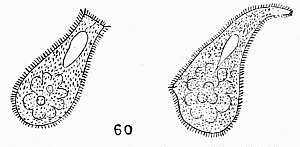
Trachelius ovum, three hours after division.
Three hours after the "fission" the proboscis half
was not unlike the former self of the late "entire," but
with diminished body and larger neck; while the re[138]maining
portion had assumed a flask form, and would
not have been known by his dearest acquaintance. The
portraits of the dis-United States were quickly taken,
and, as bed-time had arrived, they were left to darkness
and themselves. The next morning a change had come
over the "spirit of their dream." Both were quiet, or
sedately moving, and they were nearly alike. The
proboscis fellow had increased and rounded his body,
and diminished his nose; while Mr. Flask had grown
round also, and evinced an intention of cultivating a
proboscis himself. Twenty-seven hours after the
separation, both had made considerable progress in
arranging and developing their insides, which had been
thrown into great confusion by the way in which the
original animal had been wrenched in half, and in both
a granular mass was forming opposite the mouth end.
The proboscis portion, which may perhaps be termed
the mother, was more advanced than her progeny, but
both had a great deal to do if they meant to exhibit the
original figure, and develop a set of bowels as elegantly
branched. Whether they would have succeeded or not
under happier circumstances I cannot tell, but unfortunately[139]
the Fate who carries the scissors cut short their
days.
In all other animalcules in which I had observed the
process of multiplication by self-division, it seemed to
go on smoothly, and with no discomfort to either the
dividend or the quotient, and it may be that in the
fission of the Trachelius ovum I witnessed what the
doctors would call a bad case. Indeed it may have
been prematurely brought on, and aggravated by the
squeeze in the live-box. It is, however, probable, from
the stronger texture and greater organic development
of this animalcule, that it does not divide so easily as
the softer and simpler kinds.
Frequent examination of this animalcule has created
a strong doubt in my mind whether it is rightly placed
in our "systems." My own impression is that it
belongs to a higher class.
[140]
CHAPTER XIII.
CONCLUSION.

HE creatures described in the preceding pages
range from very simple to highly complicated
forms, and in describing them some attention
has been paid to the general principles of classification.
The step is a wide one from the little masses of living
jelly that constitute Amœbæ to the Rotifers, supplied
with organs of sensation—eyes, feelers (calcars), and the
long cilia in the Floscularians, which seem to convey
impression like the whiskers of a cat—together with
elaborate machinery for catching, grinding up, and
digesting their prey, and which are also well furnished
with respiratory and excretory apparatus, ovaries, &c.
In the polypi and polyzoa may be observed those
resemblances in appearance which induced early naturalists
to group them together, and also the wide difference
of organization which marks the higher rank
to which the latter have attained. Amongst the ciliated
infusoria important gradations and differences will also
be noticed, some having only one sort of cilia, others
two sorts, and others, again, supplied, in addition to
cilia, with hooks and styles. No perfectly satisfactory[141]
classification of the infusoria has yet been devised, and
the life history of a great many is still very imperfectly
known. On the whole, the tendency of research is to
place many of them higher than they used to stand
after Ehrenberg's supposition of their having a plurality
of distinct stomachs, &c., was given up. Balbiani and
others have shown numerous cases of their forming
their eggs by a process analogous to that of higher
animals. Some really are, and others closely resemble,
the larval conditions of creatures higher in the scale, and
the contracted vesicle with its channel bears resemblance
to what is called the "water vascular system" of
worms.
Zoological classification depends very much on morphology,
that is, the tracing of particular structures,
or parts, through all their stages, from the lowest to the
highest forms in which they are exhibited. In this
way the swimming bladder of a fish is shown to be a
rudimentary lung, though it has no respiratory functions,
and Mr. Kitchen Parker has found in the imperfect
skull of the tadpole a rudimentary appearance of
bones belonging to the human ear. The comparative
anatomist, after a wide survey of the objects before
him, arranges them into groups. He asks what are the
characteristic things to be affirmed concerning all the A's
that cannot be said of all the B's; or of all the C's that
marks their difference from the A's or the D's. Careful
investigation upon these methods shows affinities where
they were not previously expected—birds and reptiles
being close relations, for example, instead of distant
connections—and they lessen the value for purposes of[142]
classification of peculiarities that might have been
deemed of the highest importance.
Professor Huxley divides the vertebrates into Ithycoids,
comprising fishes and amphibia, which, besides
other characteristics, have gills at some period of their existence;
Sauroids (reptiles and birds), which have no
gills, and possess certain developmental characteristics in
common; and, lastly, Mammals. The Insecta, Myriopoda,
Arachnidæ, and Crustacea, he remarks, "without
doubt present so many characters in common as to
form a very natural assemblage. All are provided
with articulated limbs attached to a segmented body
skeleton, the latter, like the skeleton of the limbs,
being an 'exoskeleton,' or a bordering of that layer
which corresponds with the outer part of the vertebrates.
In others, at any rate in the embryonic condition,
the nervous system is composed of a double
chain of ganglia, united by longitudinal commissures,
and the gullet passed between two of these commissures.
No one of the members of these four classes is known
to possess vibratile cilia. The great majority of these
animals have a distinct heart, provided with valvular
apertures, which are in communication with a peri-visceral
cavity containing corpusculated blood." These
four classes have constituted the larger group or
"province" of Articulata or Arthropoda. Professor
Huxley thinks that, notwithstanding "the marked differences"
between the Annelida (worms) and the preceding
Arthropods (joint-foots), their resemblances outweighing
them—"the characters of the nervous system,
and the frequently segmented body, with imperfect[143]
lateral appendages of the Annelida, necessitates their
assemblage with the Arthropoda in one great division,
or sub-kingdom, of Annulosa."
Tracing analogies between the Echinodermata (sea
urchins, star-fish, &c.) and the Scolecida (intestinal
worms), he places them together as Annuloida.
Cephalopoda, Pteropoda, Pulmo-gasteropoda, and
Branchio-gasteropoda, having resemblances of nervous
system, and "all possessing that remarkable buccal
apparatus, the Odontophore," are placed together by
him as Odontophora. The Odontophores (tooth-bearers)
are familiar to microscopists as the so-called palates of
mollusca. Placing with the above the lamellibranchial
mollusks (mollusks with gills formed of lamellæ or
little plates), Ascidioida (ascidians), Brachiopoda (lamp-sheds),
and Polyzoa, in spite of their differences, he
forms another great group, Annuloida.
The Actinozoa (anemonies, &c.) and the Hydrozoa
(polyps) constitute the Cœlentera of Frey and Leuckart.
"In all these animals," says Professor Huxley, "the
substance of the body is differentiated into those histological
elements which have been termed cells, and the
latter are previously disposed in two layers, one external
and one internal, constituting the ectoderm and endoderm.
Among animals which possess this histological
structure the Cœlenterata stand alone in having an
alimentary canal, which is open at its inner end and
communicates freely by this aperture with the general
cavity of the body," and "all (unless the Ctenophora
should prove a partial exception to the rule) are provided
with very remarkable organs of offence or defence,[144]
called thread-cells or nematocysts." In describing the
Polyps we have given illustrations of these weapons.
The remaining classes, which have been roughly
associated as Protozoa, must evidently be rearranged.
Sponges, Rhizopods (Amœbæ, &c.), and Gregarines,
have strong resemblances, but recent researches
may place the former higher. The Infusoria comprehend
creatures too various to remain under one head,
and very many of them too highly organized to be
called "protozoons," or first life-forms.
Those who wish to pursue this subject further may
consult Professor Huxley's 'Elements of Comparative
Anatomy,' from which the preceding quotations have
been taken.
A system of classification founded upon anatomical
and developmental considerations frequently differs considerably
from one we might arrive at if all the creatures
were arranged according to the perfection of their
faculties and the extent and accuracy of their relations
to the external world. Such a classification would not
in any way supersede the former, but it would prove
very instructive and offer many valuable suggestions.
Some years since, Professor Owen proposed to divide the
Vertebrates according to the perfection of their brains,
but other anatomists did not find his divisions sufficiently
coincident with facts. Very little has been done
towards an exact science of human phrenology. The
difficulties remain pretty much as they were many years
ago, and our comparative phrenology, if we may use such
a term, is in a very imperfect state. When we come to
the lower animals we do not know what peculiarities[145]
of the brain of an ant make it the recipient of a higher
instinct, or give its possessor greater capacities for
dealing with new and unexpected difficulties than are
possessed by most other insects, and if any reader has
a marine aquarium, and will make a few experiments
in taming prawns, and watching their proceedings, he
will discover symptoms of intelligence beyond what the
structure of the creature would have led him to expect.
Animals usually possess some one leading characteristic
to which their general structure is subordinated.
Man stands alone in having the whole of his organization
conformed to the demands of a thinking, ruling
brain. To pass at once to the other extreme, we
observe in the lower infusoria a restless locomotion,
probably subservient to respiration, but utterly inconsistent
with a well developed life of relation, or
with manifestations of thought. The life of an animalcule
may be summed up as a brief and restricted,
but vigorous organic energy, and if the amount of
change which a single creature can make in the external
world, is inconceivably small, the labours of the
entire race alter the conditions of a prodigious amount
of matter. Microscopic vegetable life is an important
agent in purifying water from the taint of decomposing
organisms. By evolving oxygen it brings putrescent
particles under the influence of a species of combustion,
which, though slow, is as effectual as that which a
furnace could accomplish. In this way minute moulds
burn up decaying wood.
Microscopic animal life helps the regenerative process,
and, together with the minute vegetable life,[146]
restores to the organic system myriads of tons of
matter, which death and decay would have handed
over to the inorganic world. In a very small pond
or tank the quantity of this kind of work is soon
appreciable, and if we reflect on the amazing amount
of water all over the globe, including seas and oceans,
which swarm with infusoria, the total effect produced in
a single year must seem considerable, even when compared
with that portion of the earth's crust that is
subject to alteration from all other causes put together.
If we add to the labour of the Infusoria those of other
creatures whose organization can only be discovered
by the microscope, and take in the foraminifera, polyps,
polyzoa, &c., we shall have to record still larger obligations
to minute forms of living things. The coral
polyp builds reefs that constitute the chief characteristic
of certain regions in the Pacific; foraminifera are
forming or helping to form strata of considerable
extent, while diatoms are making deposits many feet in
thickness, composed of myriads of their silicious shells,
or adding their contributions of silex, very large in
the aggregate, to all sedimentary rocks. Testimony of
this kind of work is found by the navigator who
examines the ice in arctic seas, and it comes up with
soundings from the ocean depths.
On the surface of the earth the amount of change
produced is equally remarkable, although it leaves less
permanent traces behind. As a rule no decomposition
of organized matter takes place, no death of plants or
animals, without infusorial life making its appearance,
and disposing of no small portion of the spoil. Even[147]
in our climate the mass of matter thus annually
affected is very large; but what must it not be in
moist tropical lands, where every particle seems alive,
and the race of life and death goes on at a speed, and
to an extent scarcely conceivable by those who have
not witnessed it.
Thus, if we look at the world of minute forms which
the microscope reveals, there opens before us a spectacle
of boundless extent. We see life manifested by
the specks of jelly containing particles not aggregated
into structure, and we see it gradually ascending in complexities
of organization. In creatures whose habits and
appearance seem most remote from our own, we find
the elementary developments of the organs and powers
that constitute our glory, and give us our power. Such
studies assist us to conceive of the universe as a
Cosmos, or Beautifully Organized Whole; and, although
we cannot tell the object for which a single
portion received its precise form, we trace everywhere
relations of structure to means of existence and enjoyment,
and are led to the conviction that all the
actions and arrangements of the organic or inorganic
worlds are due to a definite direction and co-ordination
of a few simple forces, which implicitly and unerringly
obey the dictates of an Omniscient Mind.
PRINTED BY J. E. ADLARD, BARTHOLOMEW CLOSE.
[149][149]
NEW WORKS AND NEW EDITIONS
RECENTLY PUBLISHED
BY
GROOMBRIDGE AND SONS
5, PATERNOSTER ROW, LONDON.
DEDICATED TO THE RIGHT HON. LORD LYTTON.
In one handsome Volume, Foolscap Quarto, cloth gilt, price 25s.
WOMANKIND IN WESTERN EUROPE,
FROM THE EARLIEST AGES TO THE SEVENTEENTH CENTURY.
By THOMAS WRIGHT, M.A., F.S.A.
Illustrated with numerous Coloured Plates and Wood Engravings.
"It is something more than a drawing-room ornament. It is an elaborate and careful
summary of all that one of our most learned antiquaries, after years of pleasant labour
on a very pleasant subject, has been able to learn as to the condition of women from the
earliest times. It is beautifully illustrated, both in colours—mainly from ancient
illuminations—and also by a profusion of woodcuts, portraying the various fashions by
which successive ages of our history have been marked."—The Times.
In one handsome Volume, Super-royal Quarto, cloth gilt, price 21s.
RURAL CHURCHES
THEIR HISTORIES, ARCHITECTURE, AND ANTIQUITIES.
By SIDNEY CORNER.
With Coloured Illustrations from Paintings by the Author.
Illustrations of some of those of the Churches of our country that are
most interesting, either from their associations or from the picturesque
beauty of their situations; each Illustration being accompanied by a
full descriptive account of the History, Architecture, and Antiquities
of the Church, together with information on subjects of interest in its
neighbourhood.
Large Crown 8vo, cloth gilt, price 10s. 6d.
GRAVEMOUNDS
AND THEIR CONTENTS.
BY LLEWELLYNN JEWITT, F.S.A.
Illustrated with more than Three Hundred Illustrations.
[150]
The Books in this Catalogue may be ordered through any Bookseller, or the Publisher will forward
them direct (post paid) on receipt of their value in Postage Stamps or Post-Office Order.
NEW EDITION OF THE WORKS
OF
GRACE AGUILAR.
This elegant Edition, large crown 8vo, is printed from new type, on
paper made especially for the series, handsomely bound, and illustrated by
the leading Artists of the day.
HOME INFLUENCE.
A Tale for Mothers and Daughters. Crown 8vo, Illustrated, cloth gilt, 5s.
THE MOTHER'S RECOMPENSE.
A Sequel to Home Influence. With Illustrations, Crown 8vo, cloth gilt, 6s.
WOMAN'S FRIENDSHIP.
A Story of Domestic Life. Crown 8vo, Illustrated, cloth gilt, 5s.
THE VALE OF CEDARS; OR, THE MARTYR.
Crown 8vo, Illustrated, cloth gilt, 5s.
THE DAYS OF BRUCE.
A Story from Scottish History. Crown 8vo, Illustrated, cloth gilt, 6s.
HOME SCENES AND HEART STUDIES.
Crown 8vo, Illustrated, cloth gilt, 5s.
THE WOMEN OF ISRAEL.
Characters and Sketches from the Holy Scriptures. Illustrated.
Crown 8vo, cloth gilt, 6s.
Criticisms on Grace Aguilar's Works.
HOME INFLUENCE.—"To those who really knew Grace Aguilar, all eulogium falls
short of her deserts, and she has left a blank in her particular walk of literature,
which we never expect to see filled up."—Pilgrimages to English Shrines, by Mrs.
S. C. Hall.MOTHER'S RECOMPENSE.—"'The Mother's Recompense' forms a fitting close to
its predecessor, 'Home Influence'. The results of maternal care are fully developed,
its rich rewards are set forth, and its lesson and its moral are powerfully
enforced."—Morning Post.WOMAN'S FRIENDSHIP.—"We congratulate Miss Aguilar on the spirit, motive,
and composition of this story. Her aims are eminently moral, and her cause comes
recommended by the most beautiful associations. These, connected with the skill here
evinced in their development, ensure the success of her labours."—Illustrated News.VALE OF CEDARS.—"The Authoress of this most fascinating volume has selected
for her field one of the most remarkable eras in modern history—the reigns of Ferdinand
and Isabella.... It is marked by much power of description, and by a woman's
delicacy of touch, and it will add to its writer's well-earned reputation."—Eclectic
Review.DAYS OF BRUCE.—"The tale is well told, the interest warmly sustained throughout,
and the delineation of female character is marked by a delicate sense of moral beauty.
It is a work that may be confided to the hands of a daughter by her parent."—Court
Journal.HOME SCENES.—"Grace Aguilar knew the female heart better than any writer of
our day, and in every fiction from her pen we trace the same masterly analysis and
development of the motives and feelings of woman's nature."—Critic.WOMEN OF ISRAEL.—"A work that is sufficient of itself to create and crown a
reputation."—Mrs. S. C. Hall.
GROOMBRIDGE & SONS, 5, PATERNOSTER ROW, LONDON.[151]
SHILLING GIFT BOOKS FOR YOUNG PEOPLE.
Each Book sent Post Free for 12 Stamps.
UNION JACK; AND OTHER STORIES.
BY MRS. S. C. HALL.
Illustrated with 15 Wood Engravings. Foolscap 8vo, cloth gilt, 1s.
"Mrs. Hall has written a charming story. The scene is laid in Ireland. The
characters are for the most part Irish, and the name of the tale is 'Union Jack.'
It is written with much simplicity, and is calculated to amuse men and women as
well as children, for whom it is professedly written."—Western Daily Mercury.
THE TOWN OF TOYS; AND OTHER STORIES.
BY SARA WOOD.
Illustrated with 15 Wood Engravings. Foolscap 8vo, cloth gilt, 1s.
"One of the best of the series; the narrative is clearly and concisely written,
the subject matter is good, and above all it is replete with that sustained interest,
without which children's stories become worse than useless."—English Churchman.
NO MAN'S LAND; AND OTHER STORIES.
BY T. MILLER.
Illustrated with 15 Wood Engravings. Foolscap 8vo, cloth gilt, 1s.
"A series of very amusing and instructive tales for children, written by a
talented author."—Brighton Gazette.
THE SEA SPLEENWORT; AND OTHER STORIES.
BY THE AUTHOR OF "THE HEIR OF REDCLYFFE."
Illustrated with 15 Wood Engravings. Foolscap 8vo, cloth gilt, 1s.
"A capital little book for children, both amusing and instructive."—Liverpool
Daily Post.
LOTTIE'S HALF-SOVEREIGN; AND OTHER STORIES.
BY MRS. RUSSELL GRAY.
Illustrated with 15 Wood Engravings. Foolscap 8vo, cloth gilt, 1s.
"The story before us is a most delightful one, and such as may be placed in
the hands of any child with the utmost confidence."—Hull Advertiser.
THE SHEPHERD LORD; AND OTHER STORIES.
BY JULIA CORNER.
Illustrated with 15 Wood Engravings. Foolscap 8vo, cloth gilt, 1s.
"We cannot imagine a better book for children educated at home; it combines
the fascination of romance with the truth of history, and will be eagerly
devoured by the youth of both sexes."—Somerset County Herald.
THE CAPTIVE'S DAUGHTER; AND OTHER STORIES.
BY W. HEARD HILLYARD.
Illustrated with 15 Wood Engravings. Foolscap 8vo, cloth gilt, 1s.
"If one were asked to select a series of stories most suitable for presents to
children, and affording real pleasure in their perusal to 'children of a larger
growth,' very few would hesitate to name this series as the very first and best of
the class."—Coventry Herald.
THE ORPHANS OF ELFHOLM; AND OTHER STORIES.
BY FRANCES BROWNE.
Illustrated with 15 Wood Engravings. Foolscap 8vo, cloth gilt, 1s.
"A book to be prized by the young, for its several tales are well written and
full of touching interest."—City Press.
WHEN WE WERE YOUNG; AND OTHER STORIES.
BY THE AUTHOR OF "A TRAP TO CATCH A SUNBEAM."
Illustrated with 15 Wood Engravings. Foolscap 8vo, cloth gilt, 1s.
"The precept of moral courage which it inculcates, coupled with its excellent
tone throughout, stamps it at once as being of the right sort."—English Churchman.
NOT CLEVER; AND OTHER STORIES.
BY FRANCES M. WILBRAHAM.
Illustrated with 15 Wood Engravings. Foolscap 8vo, cloth gilt, 1s.
"Pure in tone, full of interest, well got up, and cheap."—Hereford Times.
DEAR CHARLOTTE'S BOYS; AND OTHER STORIES.
BY EMILY TAYLOR.
Illustrated with 15 Wood Engravings. Foolscap 8vo, cloth gilt, 1s.
"We are glad to receive a volume of these pretty stories. There is something
refreshing in them, scarcely to be found in any other publication."—City Press.
THE STORY OF NELSON; AND OTHER STORIES.
BY W. H. G. KINGSTON.
Illustrated with 15 Wood Engravings. Foolscap 8vo, cloth gilt, 1s.
"Mr. Kingston, with great skill, brings out the stirring events of the great
Admiral's life from the lips of an old Greenwich pensioner. The story is told with
all the enthusiasm of a true 'Salt,' and has the further merit of capital descriptive
writing."—Plymouth Journal.
[153]
BLIND URSULA; AND OTHER STORIES.
BY MRS. WEBB.
Illustrated with 15 Wood Engravings. Foolscap 8vo, cloth gilt, 1s.
"A domestic tale of humble life, which will well repay perusal. There is an
excellent tone, moral and religious, throughout the narrative."—Leeds Intelligencer.
SEA-SHELL ISLAND; AND OTHER STORIES.
BY G. E. SARGENT.
Illustrated with 15 Wood Engravings. Foolscap 8vo, cloth gilt, 1s.
"An exceeding pretty story."—Somersetshire County Herald.
WHICH WAS THE BRAVEST? AND OTHER STORIES.
BY L. A. HALL.
Illustrated with 15 Wood Engravings. Foolscap 8vo, cloth gilt, 1s.
"A tale of the Christmas holidays on the banks of the Shannon, intended to
show, by the conduct of a party of young people, that rashness and disobedience
are no proofs of courage. It should be widely spread, for the spirit of the little
book is excellent. The engravings are appropriate and pleasing."—Plymouth
Journal.
THE CLOCKMAKER OF LYONS; AND OTHER STORIES.
BY E. M. PIPER.
Illustrated with 15 Wood Engravings. Foolscap 8vo, cloth gilt, 1s.
"An interesting tale, forming one of Messrs. Groombridge's Series of Gift
Books, and by no means the worst of the series."—Cheltenham Journal.
THE ANGEL UNAWARES; AND OTHER STORIES.
BY MARY HOWITT.
Illustrated with 15 Wood Engravings. Foolscap 8vo, cloth gilt, 1s.
"A pretty story of kindness rewarded by success. Tho principal actors are
children, and the teaching of the story, while it is full of point for older learners,
is adapted especially to the capacity of youth."—Plymouth and Devonport Journal.
HISTORICAL DRAMAS.
BY THE AUTHOR OF "THE HEIR OF REDCLYFFE."
Illustrated with 15 Wood Engravings. Foolscap 8vo, cloth gilt, 1s.
"Combines amusement with instruction in a way that must please the rising
generation."—Renfrewshire Independent.
[154]
LOST IN THE WOOD; AND OTHER STORIES.
BY MRS. GILCHRIST.
Illustrated with 15 Wood Engravings. Foolscap 8vo, cloth gilt, 1s.
"Perfectly healthy in tone, and highly interesting, these tales are indeed
most suitable for family reading."—Gloucester Mercury.
RAINBOW'S REST; AND OTHER STORIES.
BY THOMAS HOOD.
Illustrated with 15 Wood Engravings. Foolscap 8vo, cloth gilt, 1s.
"These are excellent stories for children, and nicely got up and illustrated."—Paisley
Herald.
*A COMPLETE SET OF THE TWENTY VOLUMES, VIZ.:—
UNION JACK. By Mrs. S. C. Hall.
TOWN OF TOYS. By Sara Wood.
NO MAN'S LAND. By T. Miller.
SEA SPLEENWORT. By Author of "The Heir of Redclyffe."
LOTTIE'S HALF-SOVEREIGN. By Mrs. Russell Gray.
THE SHEPHERD LORD. By Julia Corner.
THE CAPTIVE'S DAUGHTER. By W. Heard Hillyard.
THE ORPHANS OF ELFHOLM. By Frances Browne.
WHEN WE WERE YOUNG. By Author of "A Trap to Catch a Sunbeam."
NOT CLEVER. By Frances M. Wilbraham.
DEAR CHARLOTTE'S BOYS. By Emily Taylor.
STORY OF NELSON. By W. H. G. Kingston.
BLIND URSULA. By Mrs. Webb.
SEA-SHELL ISLAND. By G. E. Sargent.
WHICH WAS THE BRAVEST? By L. A. Hall.
THE CLOCKMAKER OF LYONS. By E. M. Piper.
THE ANGEL UNAWARES. By Mary Howitt.
HISTORICAL DRAMAS. By Author of "The Heir of Redclyffe."
LOST IN THE WOOD. By Mrs. Gilchrist.
RAINBOW'S REST. By Thomas Hood.
Enclosed in a Box, 20s.
"We have read most of them with great care, for we are very watchful over
books for the young, and can assure our readers they are well worth a mother's
attention. They vary in interest and in moral value, but all of them are calculated
both to amuse and instruct. Some convey valuable historical information,
others lessons in natural history, and most of them convey a healthy moral influence.
All are subservient to religion as well as morals, but they are not tinctured
with any ism, nor do they inculcate any peculiar tenets."—British Mothers'
Journal.
GROOMBRIDGE & SONS, 5, PATERNOSTER ROW, LONDON.[155]
GROOMBRIDGE'S SHILLING PRACTICAL MANUALS.
Each Book sent post-free on receipt of the price.
1. HOME-MADE WINES. How to Make and Keep
them, with remarks on preparing the fruit, fining, bottling,
and storing. By G. VINE. Contains Apple, Apricot, Beer,
Bilberry, Blackberry, Cherry, Clary, Cowslip, Currant, Damson,
Elderberry, Gooseberry, Ginger, Grape, Greengage, Lemon,
Malt, Mixed Fruit, Mulberry, Orange, Parsnip, Raspberry, Rhubarb,
Raisin, Sloe, Strawberry, Turnip, Vine Leaf, and Mead.2. CARVING MADE EASY; or, Practical Instructions
for Diners Out. Illustrated with Engravings of Fish,
Flesh, and Fowl, and appropriate instructions, whereby a
complete and skilful knowledge of the useful art of Carving
may be attained, and the usages of the Dinner Table duly
observed. By A. Merrythought.3. COTTAGE COOKERY. Containing Simple Instructions
upon Money, Time, Management of Provisions, Firing,
Utensils, Choice of Provisions, Modes of Cooking, Stews,
Soups, Broths, Puddings, Pies, Fat, Pastry, Vegetables, Modes
of Dressing Meat, Bread, Cakes, Buns, Salting or Curing Meat,
Frugality and Cheap Cookery, Charitable Cookery, Cookery
for the Sick and Young Children. By Esther Copley.4. COTTAGE FARMING; or, How to Cultivate from
Two to Twenty Acres, including the Management of Cows,
Pigs, and Poultry. By Martin Doyle. Contains, On Enclosing
a Farm, Land Drainage, Manures, Management of a
Two-acre Farm, Cow Keeping, The Dairy, Pig Keeping, Bees
and Poultry, Management of a Ten-acre Farm, Flax and Rape,
Management of a Farm of Twenty Acres, Farm Buildings, etc.5. SINGING MADE EASIER FOR AMATEURS,
explaining the pure Italian Method of Producing and Cultivating
the Voice; the Management of the Breath; the best
way of Improving the Ear; with much other valuable information
equally valuable to Professional Singers and Amateurs.6. MARKET GARDENING, giving in detail the
various methods adopted by Gardeners in growing the Strawberry,
Rhubarb, Filberts, Early Potatoes, Asparagus, Sea
Kale, Cabbages, Cauliflowers, Celery, Beans, Peas, Brussels
Sprouts, Spinach, Radishes, Lettuce, Onions, Carrots, Turnips,
Water Cress, etc. By James Cuthill, F.R.H.S.7. CLERK'S DICTIONARY OF COMMERCIAL
TERMS; containing Explanations of upwards of Three
Hundred Terms used in Business and Merchants' Offices.
By the Author of "Common Blunders in Speaking and
Writing Corrected.""An indispensable book for all young men entering a counting-house for the first time."
8. THE CAT, Its History and Diseases, with Method
of Administering Medicine. By the Honourable Lady Cust.[156]
9. ELOCUTION MADE EASY for Clergymen, Public
Speakers, and Readers, Lecturers, Actors, Theatrical Amateurs,
and all who wish to speak well and effectively in Public
or Private. By Charles Hartley. Contents: Cultivation
of the Speaking Voice, Management of the Voice, Pausing,
Taking Breath, Pitch, Articulation, Pronunciation, The
Aspirate, The Letter R, Emphasis, Tone, Movement, Feeling
and Passion, Verse, Scriptural Reading, Stammering and
Stuttering, Action, Acting, Reciting, etc.10. ORATORY MADE EASY. A Guide to the Composition
of Speeches. By Charles Hartley. Contents: Introduction,
Power of Art, Various Kinds of Oratory, Prepared
Speech, Constructing a Speech, Short Speeches, Command
of Language, Reading and Thinking, Style, Hasty Composition,
Forming a Style, Copiousness and Conciseness, Diction
or Language, Purity and Propriety, Misapplied Words,
Monosyllables, Specific Terms, Variety of Language, Too
Great Care about Words, Epithets, Precision, Synonymes,
Perspicuity, Long and Short Sentences, Tropes and Figures,
Metaphor, Simile, etc.11. THE GRAMMATICAL REMEMBRANCER; or,
Aids for correct Speaking, Writing, and Spelling, for Adults.
By Charles Hartley. Contents: Introduction, Neglect of
English Grammar, Divisions of Grammar, Parts of Speech,
The Article, The Silent H, Nouns, Formation of the Plural,
Genders of Nouns, Cases of Nouns, Comparison of Adjectives,
Personal Pronouns, Relative Pronouns, Demonstrative Pronouns,
Regular and Irregular Verbs, Shall and Will, The Adverb,
Misapplication of Words, Division of Words, Capital
Letters, Rules for Spelling, Double l and p, A Short Syntax,
Punctuation, etc.12. THE CANARY. Its History, Varieties, Management,
and Breeding, with Coloured Frontispiece. By Richard
Avis. Contains, History of the Canary, Varieties of the
Canary, Food and General Management, Cages, Breeding,
Education of the Young, Mules, Diseases, etc.13. BIRD PRESERVING and Bird Mounting, and the
Preservation of Birds' Eggs, with a Chapter on Bird Catching.
By Richard Avis.14. WINE GUIDE; or, Practical Hints on the Purchase
and Management of Foreign Wines, their History, and
a complete catalogue of all those in present use, together with
remarks upon the treatment of Spirits, Bottled Beer, and
Cider. To which is appended Instructions for the Cellar, and
other information valuable to the Consumer as well as the
Dealer. By Frederick C. Mills.
GROOMBRIDGE & SONS, 5, Paternoster Row, London.[157]
ELEGANT PRIZE OR GIFT BOOK FOR BOYS.
In Three handsome Volumes, fcap. quarto, gilt edges, Illustrated with Eleven
Hundred Beautiful Engravings, price Twenty-four Shillings.
RECREATIVE SCIENCE
A RECORD AND REMEMBRANCER OF INTELLECTUAL OBSERVATION
IN EVERY DEPARTMENT OF SCIENCE.
Astronomy, Chemistry, Botany, Geology, Mechanics, Meteorology,
Microscopy, Physiology, Zoology, etc., etc.
THE PROMINENT FEATURES OF RECREATIVE SCIENCE.
Applications of Science, including Photography and the Stereoscope, Electro-Metallurgy,
etc., with all their minute and recreative manipulations.Essays on the Result of Scientific Research, as witnessed by the civilization
of the Nineteenth Century, which derives so much of its strength
and moral excellence from the Steam-engine, the Electric Telegraph,
and other applications of scientific principles.Biographies of Eminent Scientific Men and Analysis of Old and New
Scientific Books.Illustrations of Natural Phenomena and Diagrams of Optical, Mechanical,
and other principles as required by the subject matter of the papers published
in the work.Natural History occupies a prominent position among the various subjects
dealt with, including Home Recreations, of which the love of Nature
may be said to be the basis. The Management of Collections of Living
Animals, the Preparation of Specimens by Taxidermy, and the arrangement
of Cabinets of Insects, Birds, Shells, Plants, etc., etc.Experimental Philosophy and Recreations in Chemistry are introduced
with a view to explain principles and give a zest to study.Recreative Science is in all respects popular in tone and attractive in its
subjects. It is compiled by writers of the highest eminence in the several
departments of Scientific Knowledge. In a word, it is a Record of Discovery,
Observation, and Intellectual Progress. An Instructor in First
Principles, and an Exhibitor of the Accomplishments of Research.
GROOMBRIDGE & SONS, 5, Paternoster Row, London.[158]
Crown 8vo, elegantly bound, cloth gilt, Illustrated with 8 beautifully coloured
full-page Plates and numerous Wood Engravings, price 3s. 6d.
THE MICROSCOPE
A Popular Description of some of the most Beautiful and Instructive
Objects for Exhibition.
With Directions for the Arrangement of the Instruments and the Collection
and Mounting of Objects.
By the Hon. Mrs. WARD.
"This elegant book deserves at our hands especial commendation for
many reasons. There is no book that we know of that we would more
willingly place in the hands of a beginner to create an interest in the science
of Microscopy. The Illustrations are beautiful, coloured to represent nature,
and all original. To our readers we cannot give better advice than to
become purchasers of the book—they will not regret the outlay."—Electrician.
GROOMBRIDGE & SONS, 5, Paternoster Row, London.
Crown 8vo, elegantly bound, cloth gilt, Illustrated with 12 beautifully
coloured full-page Plates and numerous Wood Engravings, price 3s. 6d.
THE TELESCOPE
A FAMILIAR SKETCH
Combining a Special Notice of Objects coming within the Range
Of a Small Telescope
With a Detail of the most Interesting Discoveries which have been made
with the assistance of powerful Telescopes, concerning the Phenomena
of the Heavenly Bodies.
By the Hon. Mrs. WARD.
"It is with pleasure that we direct the reader's attention to a little gem
lately published by the Hon. Mrs. Ward. One of the most admirable little
works on one of the most sublime subjects that has been given to the world.
The main design of the book is to show how much may be done in astronomy
with ordinary powers and instruments. We have no hesitation in
saying that we never saw a work of the kind that is so perfect. The illustrations
are admirable, and are all original."—Western Daily Press.
GROOMBRIDGE & SONS, 5, Paternoster Row, London.[159]
Crown 8vo, elegantly bound, cloth gilt, Illustrated with 8 full-page coloured
Plates and numerous Wood Engravings, price 3s. 6d.
COUNTRY WALKS OF A NATURALIST WITH HIS CHILDREN.
By the Rev. W. HOUGHTON, M.A., F.L.S.
"A fresher, pleasanter, or more profitable book than this has rarely
issued from the press."—Art Journal."Contrives to furnish a large amount of interesting natural history in
brief compass and in a picturesque and engaging manner."—Pall Mall
Gazette."It is wonderful what a very large amount of most instructive matter
connected with the animal and plant world the writer has condensed into
a small compass."—Land and Water."This pretty little volume forms one of the best little books on popular
Natural History, and is admirably adapted as a present to the young"—Birmingham
Daily Journal.
GROOMBRIDGE & SONS, 5, Paternoster Row, London.
Crown 8vo, elegantly bound, cloth gilt, Illustrated with 8 beautifully coloured
full-page Plates and numerous Wood Engravings, price 3s. 6d.
SEA-SIDE WALKS OF A NATURALIST WITH HIS CHILDREN.
By the Rev. W. HOUGHTON, M.A., F.L.S.
"The wonders of the sea-shore are detailed in an easy, pleasant and
lucid style."—Examiner."The book is very attractive, and its usefulness is enhanced by its many
careful illustrations."—Daily Telegraph."Families visiting the sea-side should provide themselves with this convenient
and instructive work."—The Queen."It is pleasingly written, and the scientific information is correct and
well selected."—Athenæum.
GROOMBRIDGE & SONS, 5, Paternoster Row, London.[160]
Crown 8vo, elegantly bound, cloth gilt, Illustrated with 8 beautifully
coloured full-page Plates and 90 Wood Engravings, price 3s. 6d.
FIELD FLOWERS
A HANDY BOOK FOR THE RAMBLING BOTANIST,
SUGGESTING
What to Look for and Where to Go in the Outdoor Study of
BRITISH PLANTS.
By SHIRLEY HIBBERD, F.R.H.S.
"It will serve as an excellent introduction to the practical study of wild
flowers."—The Queen."We cannot praise too highly the illustrations which crowd the pages
of this handbook; the coloured plates are especially attractive, and serve
to bring before us very distinctly the most prominent flowers of the field,
the heaths, and the hedgerows."—Examiner.
GROOMBRIDGE & SONS, 5, Paternoster Row, London.
Crown 8vo, elegantly bound, cloth gilt, illustrated with 8 beautifully coloured
Plates and 40 Wood Engravings, price 3s. 6d.
THE FERN GARDEN
HOW TO MAKE, KEEP, AND ENJOY IT OR, FERN CULTURE MADE EASY.
By SHIRLEY HIBBERD, F.R.H.S.
CONTENTS.
Ferns in General
Fern Collecting
How to Form an Outdoor Fernery
Cultivation of Rock Ferns
Cultivation of Marsh Ferns
Ferns in Pots
The Fern House
The Fernery at the Fireside
Management of Fern Cases
The Art of Multiplying Ferns
British Ferns
Cultivation of Greenhouse
Stove Ferns
Select Greenhouse Ferns
Select Stove Ferns
Tree Ferns
Fern Allies
GROOMBRIDGE & SONS, 5, Paternoster Row, London.[161]
Crown 8vo, elegantly bound, gilt edges, Illustrated with 12 beautifully
coloured Engravings, price 3s. 6d.
THE CANARY
ITS VARIETIES, MANAGEMENT, AND BREEDING WITH PORTRAITS OF THE AUTHOR'S OWN BIRDS.
By the Rev. FRANCIS SMITH.
CONTENTS.
A Plea for the Canary
Origin of Our Own Canaria
The Wild Canary
Our Lizards
Our Yorkshire Spangles
Our Norwich Yellows
Our London Fancy Birds
Our Belgians
Our Green Birds
Our Cinnamons
Our Turncrests
The Dominie and the Germans
Preparations for Breeding
Nest Boxes and Nests
Our First Birds
Our Misfortunes
Our Infirmary
On Cages
GROOMBRIDGE & SONS, 5, Paternoster Row, London.
Post 8vo, cloth gilt, with Woodcut Illustrations, price 5s.
THE ROSE BOOK
A PRACTICAL TREATISE ON THE CULTURE OF THE ROSE
COMPRISING
The Formation of the Rosarium; the Characters of Species and Varieties;
Modes of Propagating, Planting, Pruning, Training, and Preparing
for Exhibition; and the Management of Roses in all Seasons.
By SHIRLEY HIBBERD, F.R.H.S.
CONTENTS.
The Families of Wild Roses
The Families of Cultivated Roses
Summer Roses
Forming the Rosarium
Culture of Roses in the Open Ground
Autumn Planting
Spring Planting
Pruning, Disbudding, and Seasonal Management
Climbing Roses
Pillar Roses
Yellow Roses
Roses in Pots
Roses in Beds
Roses in Great Towns
Tea Roses in Towns
Various Modes of Propagating
Select Lists of Roses
Reminders of Monthly Work In Rose Garden
Hints To Beginners
GROOMBRIDGE & SONS, 5, Paternoster Row, London.[162]
BOOKS FOR YOUNG NATURALISTS
Crown 8vo, elegantly bound, gilt edges, Illustrated with 16 beautifully
coloured Plates and numerous Wood Engravings, price 5s.
NESTS AND EGGS OF FAMILIAR BIRDS.
Described and Illustrated with an account of the Haunts and Habits of
the Feathered Architects, and their Times and Modes of Building.
By H. G. ADAMS.
GROOMBRIDGE & SONS, 5, Paternoster Row, London.
Crown 8vo, elegantly bound, gilt edges, Illustrated with 8 beautifully
coloured Plates and numerous Wood Engravings, price 3s. 6d.
BEAUTIFUL BUTTERFLIES
DESCRIBED AND ILLUSTRATED.
With an Introductory chapter, containing the History of a Butterfly
through all its Changes and Transformations. A Description of its Structure
in the Larva, Pupa, and Imago states, with an Explanation of the
scientific terms used by Naturalists in reference thereto, with observations
upon the Poetical and other associations of the Insect.
By H. G. ADAMS.
GROOMBRIDGE & SONS, 5, Paternoster Row, London.
Crown 8vo, elegantly bound, gilt edges, Illustrated with 8 beautifully
coloured Plates and numerous Wood Engravings, price 3s. 6d.
BEAUTIFUL SHELLS
THEIR NATURE, STRUCTURE, AND USES
FAMILIARLY EXPLAINED.
With Directions for Collecting, Clearing and Arranging them in the
Cabinet.
Descriptions of the most remarkable Species, and of the creatures
which inhabit them, and explanations of the meaning of their scientific
names, and of the terms used in Conchology.
By H. G. ADAMS.
GROOMBRIDGE AND SONS, 5, Paternoster Row, London.
Crown 8vo, elegantly bound, gilt edges, Illustrated with 8 beautifully
coloured Plates and Wood Engravings, price 3s. 6d.
HUMMING BIRDS.
DESCRIBED AND ILLUSTRATED.
WITH AN
Introductory Sketch of their Structure, Plumage, Haunts, Habits, etc.
By H. G. ADAMS.
GROOMBRIDGE & SONS, 5, Paternoster Row, London.[163]
NEW EDITION OF THE WORKS
OF
ANNA LISLE.
This elegant edition, large crown 8vo, is handsomely bound in cloth, gilt
edges, suitable for presentation, and Illustrated by the
leading artists of the day.
In One Volume, large crown 8vo, Illustrated, price 6s.
SELF AND SELF-SACRIFICE
OR,
NELLY'S STORY.
BY ANNA LISLE.
"A very beautiful story, with characters well drawn, scenery vividly described, and
interest admirably sustained. The tendency of the volume is not only unexceptionable,
but excellent in a Christian point of view. We have seldom seen a book in which the
best and highest aim is so manifest without the attractiveness of the tale being at all
lessened by the embodiment of religious principles."—Eclectic Review."The story is so delightful, and the whole spirit of the book so pure, that it compels
our admiration."—Daily News."Since 'Currer Bell' we have read nothing more genuine, nor more touching.
'Nelly's Story' has power to carry the reader right through with it, and can hardly fail
to impress a moral of inestimable importance."—Carlisle Journal."Admirably written, pervaded throughout by fine, correct, and wholesome sentiments."—Morning
Post."Its excellent moral tone, and keen observation, are sure to render the book widely
popular."—John Bull."'Nelly's Story' is a good one. It is one of the best we have read for a long time."—Bucks
Advertiser."Abounding in interest. We can hardly conceive a more suitable gift-book."—Lady's
Newspaper."Will be welcomed, read, and talked about."—Gentleman's Magazine.
"'Nelly's Story' is told in such a good and pleasant way, and withal is so useful and
world-like, that we trust it may bring to its authoress the fame that she is well able to
support."—Tait's Magazine."We recognise and proclaim in the authoress of this thrilling tale a quality beyond
mere ability—genius of a very high order. We claim for Anna Lisle a place amongst
the most distinguished writers of her age. The story is a brilliant effort of refined and
sanctified imagination throughout, quite as fascinating as anything in the way of story,
whether told by Scott, Stowe, Dickens, or Currer Bell."—Sentinel.
In One Volume, large crown 8vo, Illustrated, price 5s.
QUICKSANDS
A TALE.
BY ANNA LISLE.
"It is a thoroughly woman's book. We can fairly say that we have seldom met with
a graver or more striking warning against the consequences of over eagerness about
worldly position and advantages, more forcibly and, at the same time, gracefully conveyed."—Literary
Gazette."Contains a great deal of quiet and powerful writing. Marty, the maid of Mrs.
Grey, might pass for a creation of Dickens. The moral of 'Quicksands' is at once comprehensive
and striking."—Weekly Mail.
GROOMBRIDGE & SONS, 5, Paternoster Row, London.[164]
GIFT BOOKS FOR BOYS.
Foolscap 8vo, cloth gilt, Illustrated with 8 full-page Wood Engravings,
price 2s. 6d.
INVENTION AND DISCOVERY
A COLLECTION
OF
INTERESTING ANECDOTES.
by
RALPH and CHANDOS TEMPLE.
"Has a point and object, and a good one—nicely worked out."—Saturday
Review."We can recommend this book as a Christmas present, and one which
has given us no small pleasure."—Literary Churchman."Exceedingly well-timed. A volume which should be added to every
working-man's club in England."—Notes and Queries."Exhibits a conscientious regard for accuracy."—Athenæum.
"The tendency is to instil the principle of self-help and the advantage
of earnest purpose."—Bell's Messenger.
GROOMBRIDGE & SONS, 5, Paternoster Row, London.
Foolscap 8vo, cloth gilt, Illustrated with 8 full-page Wood Engravings,
price 2s. 6d.
ENTERPRISE AND ADVENTURE
A COLLECTION
OF
INTERESTING ANECDOTES.
BY
RALPH and CHANDOS TEMPLE.
"Very handsomely got up. The 'Temple Anecdotes' will be one of
the most popular of Christmas books."—Standard."A sensible, well-written book."—Globe.
"We know of no work which will make a more acceptable present
than this extremely handsome and really useful book."—Era."As a present for boys, nothing can be better."—Daily News.
"The anecdotes are told with a clearness and simplicity that cannot
fail to give pleasure."—Spectator.
GROOMBRIDGE & SONS, 5, Paternoster Row, London.[165]
Featured Books

Kai Lung's Golden Hours
Ernest Bramah
writing must in any age neglectconstruction. We write to establish a record for a few days: or to s...

Fox Trapping: A Book of Instruction Telling How to Trap, Snare, Poison and Shoot
A. R. Harding
oxSacking FoxesWire or Twine SnareThe Wire LoopSpring Pole SnareThe Runway Snare SetSome Canadian Re...

The Subspecies of the Mountain Chickadee
Joseph Grinnell
ontribution From the Museum of Vertebrate Zoology of the University of California)Fieldwork was carr...

The League of the Scarlet Pimpernel
Baroness Emmuska Orczy Orczy
lid black; /* a thin black line border.. */ padding: 6px; /* ..spaced a bit out from the gr...

Do and Dare — a Brave Boy's Fight for Fortune
Jr. Horatio Alger
TARTLING REVELATION CHAPTER XXIV. A MORNING WALK CHAPTER XXV. MELVILLE ...

The Dash for Khartoum: A Tale of the Nile Expedition
G. A. Henty
orge for England: A Tale of Cressy and Poitiers. 5s.By Pike and Dyke: A Tale of the Rise of the Dutc...

Samantha among the Brethren — Volume 7
Marietta Holley
stands to reason it is. And I'd like to knowwhat you have got to say about him any way?"Sez I, "That...

Mizora: A Prophecy
Mary E. Bradley Lane
messages about it, and letters of inquiry, and someladies and gentlemen desired to know the particu...
Browse by Category
Join Our Literary Community
Subscribe to our newsletter for exclusive book recommendations, author interviews, and upcoming releases.
Comments on "Marvels of Pond-life" :